| The Beach Boys: "Holland" (Brother, Jan. 1973) |
 Eigentlich waren die Beach Boys damals auf dem Tiefpunkt ihre Karriere
(Brian Wilson war ein hilfloses Drogenwrack), als irgend jemand die verrückte
Idee hatte, in Holland ein Platte aufzunehmen, wozu ein ganzes Studio
in Einzelteilen von Kalifornien in die Nähe von Hilversum geschafft
wurde (ihr solltet mal den interessanten Bericht
über das Entstehen der Platte lesen!). Trotz all der widrigen Umstände
entstand eine wunderschöne Platte - und sogar Brian Wilson
war dabei. Sie enthält mit "Sail On Sailor" eines meiner
absoluten Lieblingsstücke von ihm. Neben dem harten Kern um Brian,
Carl Wilson, Dennis Wilson, Mike Love und Alan
Jardine gehörten zu dieser Zeit auch die beiden südafrikanischen
Musiker Ricky Fataar (Schlagzeug) und Blondie Chaplin (Gitarre)
fest zur Band.
Eigentlich waren die Beach Boys damals auf dem Tiefpunkt ihre Karriere
(Brian Wilson war ein hilfloses Drogenwrack), als irgend jemand die verrückte
Idee hatte, in Holland ein Platte aufzunehmen, wozu ein ganzes Studio
in Einzelteilen von Kalifornien in die Nähe von Hilversum geschafft
wurde (ihr solltet mal den interessanten Bericht
über das Entstehen der Platte lesen!). Trotz all der widrigen Umstände
entstand eine wunderschöne Platte - und sogar Brian Wilson
war dabei. Sie enthält mit "Sail On Sailor" eines meiner
absoluten Lieblingsstücke von ihm. Neben dem harten Kern um Brian,
Carl Wilson, Dennis Wilson, Mike Love und Alan
Jardine gehörten zu dieser Zeit auch die beiden südafrikanischen
Musiker Ricky Fataar (Schlagzeug) und Blondie Chaplin (Gitarre)
fest zur Band.

 Mehr ...
Mehr ...
| "A surprising last-minute gasp of brilliance, this
carefully produced album is far more sincere and hard-edged than its immediate
predecessors. Mike nearly ruins it with a cheesy, musically incompetent,
eco-nostalgic, three-track mini-concept album ("California Saga"),
and one of the better tracks (Carl's "Trader") is spoiled by self-righteous,
politically correct lyrics. But the rest is solid: hummable singles (the
powerful, slowly building "Sail On Sailor," recorded with Chaplin
on lead vocals to beef up the record), plodding but effective white soul
(Dennis' "Steamboat"; the group effort "Leaving This Town"),
and even a light-hearted R & B number ("Funky Pretty"). You'll
want to skip certain selections, though, including the bonus EP, which consists
of a self-consciously ironic, spoken children's story with a few snippets
of Brian playing the piano." |
|
|
The surprisingly weak result of a concerted effort by both band and label
to push the Beach Boys back into the Top 40 (they succeeded, barely),
Holland continued the muddy sound of Carl and the Passions - So Tough.
The highlights here -- Carl's "The Trader," Brian's "Sail
On Sailor" and "Funky Pretty" -- are marginally better
than their immediate predecessors, though "Leavin' This Town"
(from recent addition Blondie Chaplin) is rather tiresome. Also, Al Jardine
and Mike Love's three-part "California Saga" shows the effects
of their environmentalist spirituality left to bake in the sun a few minutes
too long (though the conclusion, "California," is a solid return
to the harmony-laden sun-and-surf '60s). Dennis' sole lead-vocal contribution,
"Only With You," is yet another tender ballad given an excellent
reading by the most underutilized member of the group. (by John Bush,
AMG)
|
|
| Frankie Miller: "Once In A Blue Moon" (Chrysalis, Jan. 1973) |
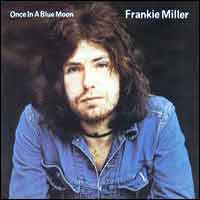 "This first album by Scotland's Frankie Miller features pub-rock favorites Brinsley Schwarz
as his backup band. That alone is reason enough to own this
record. Add to that a nice batch of songs (mostly originals) and you have
an enjoyable album." (Jim Worbois, All Music Guide)
"This first album by Scotland's Frankie Miller features pub-rock favorites Brinsley Schwarz
as his backup band. That alone is reason enough to own this
record. Add to that a nice batch of songs (mostly originals) and you have
an enjoyable album." (Jim Worbois, All Music Guide)
|
| Bruce Springsteen: "Greetings From Asbury Park" (Columbia, Jan. 1973) |
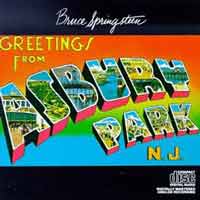 Das Debütalbum von Bruce hatte ich Mitte oder Ende der 70er mit meinem
alten Phillips-Tonbandgerät mitgeschnitten. Die Bänder existieren
lange nicht mehr, sodass ich auch diese akustischen Grüße ewig
nicht mehr gehört habe. Kürzlich kam mir das Album aber im MP3-Format
unter die Finger, wobei mir aufgefallen ist, was für ein tolles Album
ich da jahrelang verdrängt habe. Jedes der Lieder ist anders, jedes
ist klasse. Im Nachhinein nicht nachvollziehbar, warum Bruce nicht bereits
mit diesem Album den großen Durchbruch schaffte. Merkwürdigerweise
bin ich trotzdem selber nie zum großen Springsteen-Fan geworden,
obwohl ich "Born To Run"
und besonders "Darkness On The
Edge Of Town" - und im Grunde auch dieses hier - für gr0ßartige
Alben halte. Aber irgend wie war mir der Mann ab den 80ern einfach zu
präsent. Oder seine Alben wurde (aus meiner Sicht) einfach nur schlechter.
Das Debütalbum von Bruce hatte ich Mitte oder Ende der 70er mit meinem
alten Phillips-Tonbandgerät mitgeschnitten. Die Bänder existieren
lange nicht mehr, sodass ich auch diese akustischen Grüße ewig
nicht mehr gehört habe. Kürzlich kam mir das Album aber im MP3-Format
unter die Finger, wobei mir aufgefallen ist, was für ein tolles Album
ich da jahrelang verdrängt habe. Jedes der Lieder ist anders, jedes
ist klasse. Im Nachhinein nicht nachvollziehbar, warum Bruce nicht bereits
mit diesem Album den großen Durchbruch schaffte. Merkwürdigerweise
bin ich trotzdem selber nie zum großen Springsteen-Fan geworden,
obwohl ich "Born To Run"
und besonders "Darkness On The
Edge Of Town" - und im Grunde auch dieses hier - für gr0ßartige
Alben halte. Aber irgend wie war mir der Mann ab den 80ern einfach zu
präsent. Oder seine Alben wurde (aus meiner Sicht) einfach nur schlechter.
(12.02.2009) |
| "Atlantis" (Vertigo, Feb. 1973 |
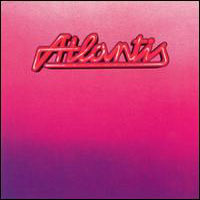 Atlantis waren im Grunde die runderneuerten Frumpy:
zu Sängerin Inga Rumpf, Keyboarder Jean-Jacques Kravetz
und Bassist Karl-Heinz Schott kamen Gitarrist Frank Diez
und Trommler Curt Cress, die Jahre später dann zur Créme
der Deutschrock-Mucker gehörten und oft bei solchen Herrschaften
wie Udo Lindenberg und Peter Maffay zu sehen und zu hören waren.
Curti hielt es damals aber nicht lange bei Atlantis und war bereits bei
der anstehenden Englandtournee durch niemand anderen als Udo Lindenberg
ersetzt worden, der beim zum Jahresende erscheinenden Nachfolgealbum "It's
Getting Better" aber seinen Platz schon wieder für Ringo
Funk (Ex-Jeronimo, falls das jemanden interessiert) geräumt hatte.
Die Platte verkaufte sich damals kurioserweise schlechter und war weniger
beliebt als das zeitgleich veröffentlichte posthume Livealbum von
Frumpy, was Frau Rumpf und ihren treuen Gesellen sicherlich mit
lachendem (wegen der zusätzlichen Einnahmen) und weinendem Auge (wegen
der offensichtlichen Missachtung der musikalischen Weiterentwicklung der
Band durch die Kundschaft) gesehen haben.
Atlantis waren im Grunde die runderneuerten Frumpy:
zu Sängerin Inga Rumpf, Keyboarder Jean-Jacques Kravetz
und Bassist Karl-Heinz Schott kamen Gitarrist Frank Diez
und Trommler Curt Cress, die Jahre später dann zur Créme
der Deutschrock-Mucker gehörten und oft bei solchen Herrschaften
wie Udo Lindenberg und Peter Maffay zu sehen und zu hören waren.
Curti hielt es damals aber nicht lange bei Atlantis und war bereits bei
der anstehenden Englandtournee durch niemand anderen als Udo Lindenberg
ersetzt worden, der beim zum Jahresende erscheinenden Nachfolgealbum "It's
Getting Better" aber seinen Platz schon wieder für Ringo
Funk (Ex-Jeronimo, falls das jemanden interessiert) geräumt hatte.
Die Platte verkaufte sich damals kurioserweise schlechter und war weniger
beliebt als das zeitgleich veröffentlichte posthume Livealbum von
Frumpy, was Frau Rumpf und ihren treuen Gesellen sicherlich mit
lachendem (wegen der zusätzlichen Einnahmen) und weinendem Auge (wegen
der offensichtlichen Missachtung der musikalischen Weiterentwicklung der
Band durch die Kundschaft) gesehen haben.
Zurück zur Musik: aufgenommen Ende 1972 in England mit dem Produzenten
John Burns (Genesis), poppiger und gleichzeitig jazziger (bzw.
funkiger!) als Frumpy, wie immer toller
Gesang von Inga, tolles Gitarrenspiel, tolle Tastenklänge von Jean-Jacques
und Gastmusiker Jean Roussel (sonst bei Cat Stevens, u.a., auch
Franzose wie Herr Kravetz?). Teilweise klingt's wie Traffic,
was vielleicht auch daran liegt, dass deren Congamann Rebop Kwaku Baah
mit im Studio war.

 Mehr ...
Mehr ...
|
Atlantis' debut album follows firmly in the footsteps of the earlier
Frumpy, with one major difference: shorter songs. Just three of the seven
tracks break the five-minute barrier, only one — the defiantly Deep
Purple jazz-rocky "Living at the End of Time" — approaches
ten. But Atlantis rises regardless. The closing ballad, "Words of
Love," essentially predicts Heart's entire career, while the funky
overtures of "Get Up," colliding with some of Rumpf's finest,
gutsiest vocals, would have made a sensational FM radio favorite. The
latter portion of "Living at the End of Time," once the band
drops the jazz-rock elitism, is spellbindingly fairyland folky, and both
"Rock'n'Roll Preacher" and "Maybe It's Useless" show
a Free influence which is quite spectacular. And that, if there is a downside,
is where the disappointments lie. At their best, Frumpy's forte lay in
their ability to fly off at monstrous tangents without ever losing sight
of such notions as melody, cohesion, and discipline. The tangents are
less pronounced here, the exploration is less bold and forthright. But
the performances are as strong as ever, the songwriting is even stronger,
and Inga Rumpf draws out some of her strongest vocals yet to power the
band to some brilliant highs.
(by Dave Thompson , All
Music Guide)
|
|
| "The Byrds" (Elektra/Asylum, Feb. 1973) |
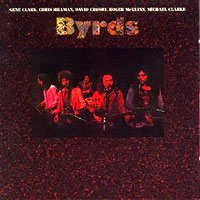 McGuinns letzte Byrdsbesetzung hatte gerade ihr Abschiedskonzert gegeben (Clarence
White, der kurz darauf bei einem Autounfall verstarb, Chris Hillman
und Joe Lala als Ersatz für die gekündigten Skip Battin
und Gene Parsons), als durch David Geffen (der damals für
das neue Asylum-Label alle möglichen Leute unter Vertrag nahm - sogar
Bob Dylan) das Angebot für
eine Byrdsplatte in Originalbesetzung (Roger McGuinn, David
Crosby, Gene Clark, Chris Hillman und Michael Clarke)
kam. Obwohl diese Platte sicher nicht den Vergleich mit den alten standhält
und alle bis auf den Trommler Michael Clarke je 2 Songs beitragen, die
meist schwächer als vergleichbare Titel von Soloplatten sind, fallen
3 Coverversionen positiv auf "For Free" von Joni Mitchell,
"Cowgirl In The Sand" und "See The Sky About To Rain"
von Neil Young. Nicht zuletzt wegen der schlechten Kritiken wurde
diese Reunion nicht verlängert. Aus der zeitlichen Distanz finde
ich aber, dass die Platte durchaus ihren Charme hat.
McGuinns letzte Byrdsbesetzung hatte gerade ihr Abschiedskonzert gegeben (Clarence
White, der kurz darauf bei einem Autounfall verstarb, Chris Hillman
und Joe Lala als Ersatz für die gekündigten Skip Battin
und Gene Parsons), als durch David Geffen (der damals für
das neue Asylum-Label alle möglichen Leute unter Vertrag nahm - sogar
Bob Dylan) das Angebot für
eine Byrdsplatte in Originalbesetzung (Roger McGuinn, David
Crosby, Gene Clark, Chris Hillman und Michael Clarke)
kam. Obwohl diese Platte sicher nicht den Vergleich mit den alten standhält
und alle bis auf den Trommler Michael Clarke je 2 Songs beitragen, die
meist schwächer als vergleichbare Titel von Soloplatten sind, fallen
3 Coverversionen positiv auf "For Free" von Joni Mitchell,
"Cowgirl In The Sand" und "See The Sky About To Rain"
von Neil Young. Nicht zuletzt wegen der schlechten Kritiken wurde
diese Reunion nicht verlängert. Aus der zeitlichen Distanz finde
ich aber, dass die Platte durchaus ihren Charme hat. |
| "Guru Guru" (Brain, Feb. 1973) |
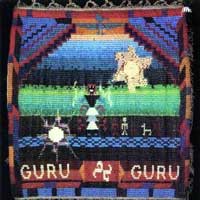 Viertes Album von Deutschlands bestem Gitarrentrio und bereits das zweite für
das Kultlabel Brain. Weil die Band im nächsten Jahr zu Atlantic
wechselte, was wohl als eine große Ehre angesehen wurde, aber kommerziell
gnadenlos in die Hose ging, brachte Brain dann den 10-DM-Billigsampler
"This Is Guru Guru" als Kombination jeweils der Hälfte
von Album Nr. 3 (dem genialen "Känguru")
und diesem hier heraus, den ich mir stattdessen kaufte: damals kosteten
normale LPs immerhin 22 DM und der "Elektrolurch" war ja schließlich
dabei! Deshalb steht dieses Album mit dem wunderschönen Cover erst
jetzt, mit 30 Jahren Verspätung, als CD-Wiederveröffentlichung
in meinem Plattenschrank! So weit ich weiß haben die drei Atlantic-Platten
von 1974/75 immer noch nicht den Sprung in das CD-Zeitalter geschafft.
Viertes Album von Deutschlands bestem Gitarrentrio und bereits das zweite für
das Kultlabel Brain. Weil die Band im nächsten Jahr zu Atlantic
wechselte, was wohl als eine große Ehre angesehen wurde, aber kommerziell
gnadenlos in die Hose ging, brachte Brain dann den 10-DM-Billigsampler
"This Is Guru Guru" als Kombination jeweils der Hälfte
von Album Nr. 3 (dem genialen "Känguru")
und diesem hier heraus, den ich mir stattdessen kaufte: damals kosteten
normale LPs immerhin 22 DM und der "Elektrolurch" war ja schließlich
dabei! Deshalb steht dieses Album mit dem wunderschönen Cover erst
jetzt, mit 30 Jahren Verspätung, als CD-Wiederveröffentlichung
in meinem Plattenschrank! So weit ich weiß haben die drei Atlantic-Platten
von 1974/75 immer noch nicht den Sprung in das CD-Zeitalter geschafft.
(April 2004) |
| Gypsy: "Brenda & The Rattlesnake" (United Artists, Feb. 1973) |
 Lost And Found!
Lost And Found!
|
| Little Feat: "Dixie Chicken" (Warner, Feb. 1973) |

Album #3 dieser Klasseband hatte ich doch bislang glatt in meiner Favoritenliste vergessen!
"Alles fügte sich zusammen bei Little Feats
drittem Album. Die erweiterte Besetzung gab der Band ein geschmeidigeres,
rhythmisches Fundament, über dem Slide-Gitarrist Lowell George
einige seiner stärksten Nummern entfalten konnte. Gemeinsam entwickelten
sie diesen maßgeschneiderten erdig-schweren, bluesigen Studiosound.
Im Titelstück, aber auch in "Fat Man In A Bathtub" und
"Two Trains" verarbeiteten Little Feat komplizierteste Rhythmen
mit klagendem Backgroundgesang und scharfzüngigen Wortspielen zu
einer absolut überzeugenden Soulrock-Melange. In vielerlei Hinsicht
ist Dixie Chicken ein naher Verwandter des ein Jahr älteren Exile
On Main Street von den Stones. Wenn auch etwas verschlossener daherkommend
als das Stones-Meisterwerk, sind doch die Highlights auf Dixie Chicken
ohne weiteres auf gleichem Niveau." (Steve Stolder , Amazon-Redaktion)
|
| Traffic: "Shoot Out At The Fantasy Factory" (Island, Feb. 1973) |
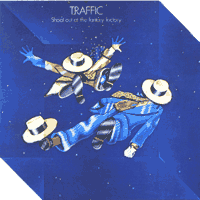 Dieses Traffic-Album scheint außer mir keiner zu mögen - so what.
Dieses Traffic-Album scheint außer mir keiner zu mögen - so what.
|
| John Martyn: "Solid Air" (Island, Feb. 1973) |
 Für mich eine der besten Martyn-Platten. Vor allem der Titelsong hat es mir
angetan. In der Begleitung überzeugen Danny Thompson am Kontrabass,
sowie Fairport Conventions Dave Pegg (bg)
und Dave Mattacks (dr). Von den Liedern seien noch "May You
Never", "Don't Want To Know About Evil" und "Man In
A Station" erwähnt, die später von Eric Clapton,
Santana, Dr. John und Ian Matthews
gecovert wurden.
Für mich eine der besten Martyn-Platten. Vor allem der Titelsong hat es mir
angetan. In der Begleitung überzeugen Danny Thompson am Kontrabass,
sowie Fairport Conventions Dave Pegg (bg)
und Dave Mattacks (dr). Von den Liedern seien noch "May You
Never", "Don't Want To Know About Evil" und "Man In
A Station" erwähnt, die später von Eric Clapton,
Santana, Dr. John und Ian Matthews
gecovert wurden.
|
| Fairport Convention: "Rosie" (Island, März 1973) |
 1972 war ein hartes Jahr für die Band. Nach "Babacombe
Lee" hatte das einzige verbliebene Urmitglied Simon Nicol
die Band verlassen und ließ drei frustrierte Daves zurück (Swarbrick,
Mattacks und Pegg), doch schließlich fand man guten
Ersatz mit zwei Nicht-Engländern: dem amerikanischen Gitarrenvirtuosen
Jerry Donahue und dem australischen Sänger und Akustikgitarristen
Trevor Lucas. Lucas war der Ehemann von Ex-Mitglied Sandy
Denny und spielte mit Sandy und Jerry auch schon in der kurzlebigen
Band Fotheringay zusammen. Insgesamt
wurde der Stil der Band wieder etwas offener, mit etwas weniger Folk.
Kein Nachteil. Das Titelstück ist eine der schönsten Lieder,
die Dave Swarbrick je geschrieben hat.
1972 war ein hartes Jahr für die Band. Nach "Babacombe
Lee" hatte das einzige verbliebene Urmitglied Simon Nicol
die Band verlassen und ließ drei frustrierte Daves zurück (Swarbrick,
Mattacks und Pegg), doch schließlich fand man guten
Ersatz mit zwei Nicht-Engländern: dem amerikanischen Gitarrenvirtuosen
Jerry Donahue und dem australischen Sänger und Akustikgitarristen
Trevor Lucas. Lucas war der Ehemann von Ex-Mitglied Sandy
Denny und spielte mit Sandy und Jerry auch schon in der kurzlebigen
Band Fotheringay zusammen. Insgesamt
wurde der Stil der Band wieder etwas offener, mit etwas weniger Folk.
Kein Nachteil. Das Titelstück ist eine der schönsten Lieder,
die Dave Swarbrick je geschrieben hat. |
| "Christmas At The Patti" (United Artists, März 1973) |
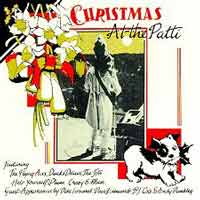 Das war wohl eine tolle Weihnachtfete damals am 19.12.1972 in Cardiff/Wales,
als sich Man, Dave Edmunds
und andere Bands aus deren Dunstkreis versammelt hatten. Mit dabei waren
noch: Help Yourself, Ducks
Deluxe und die damals von Man abtrünnigen Deke
Leonard und Martin Ace. Das ganze wurde auf einem heute sehr
raren 10"-Doppelalbum festgehalten.
Das war wohl eine tolle Weihnachtfete damals am 19.12.1972 in Cardiff/Wales,
als sich Man, Dave Edmunds
und andere Bands aus deren Dunstkreis versammelt hatten. Mit dabei waren
noch: Help Yourself, Ducks
Deluxe und die damals von Man abtrünnigen Deke
Leonard und Martin Ace. Das ganze wurde auf einem heute sehr
raren 10"-Doppelalbum festgehalten.

 Mehr ...
Mehr ...
|
"On the 19th December 1972 the Man band and their
friends and ladies organized a Christmas party at the Patti Pavillion
in Swansea and as it was a good excuse to get a lot of people into one
place at one time we took the opportunity to take the mobile down to Swansea
as well, in the hopes that if anything vaguely sane came out of the party
we could preserve it for posterity and do a special 'cheapo, limited-edition'
album for the people who couldn't be there.
The party started at six and came to something of a premature end when
the Swansea Constabulary decided enough was enough at midnight. Wally
Hot Stuff and a Legion of Charlies started things off followed by Ducks
Deluxe, a newly-formed rock band who should be releasing records of their
own before long.
Help Yourself, who have been friends of Man's since the legendary "All
Good Clean Fun" tour ow Switzerland a couple of years ago, were next
on with former Man member Deke Leonard on guitar, and the 'very famous'
B.J. Cole adding steel-guitar licks here and there.
Next came the 'nostalgia' spot with three well-known groups from South
Wales's rock past re-forming for the occasion. First up were The Jets
(one of Swansea's finest) led by 'Plum Hollis' who, until recently has
been Joe Cocker's road-manager, along with Terry Williams from Man, Martin
Ace, the bass, another former Man member, and Deke on lead guitar who
after three numbers, with the addition of two legendary Welsh rock guitarists
Mickey Gee and Dave Edmunds, became Plum Crazy with Dave Edmunds or, if
you prefer, Love Sculpture with "Plum" (if you're confused consult
Man's family tree in "Be Good to Yourself").
The last of the re-formed bands was the Eyes of Blue, Phil Ryan's old
group, who played a very tasty set. Unfortunately, "Gazzy",
former lead singer now with Wild Turkey, was in the U.S.A. and "Pugwash",
the Eyes drummer now of Gentle Giant, was on tour with the Groundhogs,
so it wasn't possible to have the whole group back together, and rather
than be dishonest, we left the recording, hopefully, until another day.
Martin Ace and his wife George, better known as the Flying Aces, followed
'oldies but goodies' time with a very short first appearance in public.
Time was fast running out and the Aces only performed two songs, one of
which "Welcome to the Party" was, as Martin said, 'especially
written for the occasion'.
To finish off an amazing evening Man arrived on stage, and after a couple
of numbers had be joined by Dave Edmunds playing slide-guitar and Stan
Pfeiffer, who joined in on the vocals at the edn. Dead on midnight the
police stopped the show and the party was over. Man would have gone on
most of the night and the audience was ready to stay with them, but it
wasn't to be.
Happy Christmas! (Original Liner Notes by Andrew Lauder)
|
|
| Gram Parsons: "GP" (Reprise, März 1973) |
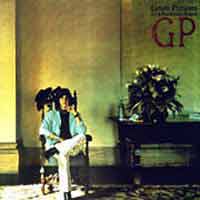
Grams Solodebüt nach dem Ausstieg bei den Flying
Burrito Brothers und einer fast zweijährigen Pause, die er
gerüchteweise kiffend bei den Aufnahmesessions der Stones für
"Exile On Mainstreet" in
Frankreich verbracht hatte, kann man als gelungen betrachten: er heuerte
die Musiker der Elvis Presley-Band an (alles Nashville-Spitzenkönner
wie James Burton und Glen D. Hardin) und wählte als
Gesangspartnerin Emmylou Harris. Im September 1973 verstarb er
leider kurz nach den Aufnahmen zum zweiten Album, welches dann erst
posthum erschien. Emmylou führte mit den o. g. Musikern als "Hot
Band" sein Erbe weiter. ähnlich wie bei Velvet Underground
verkauften sich beide Platten damals sehr schlecht, inspirierten aber
viele andere Musiker dazu, an der Verbindung von Country und Rock'n'Roll
weiter zu arbeiten, sodass Gram Parsons heute zurecht (?) als Urvater
dieses Genres gilt ("es wurden damals zwar nicht viele Platten
verkauft, aber jeder der es tat gründete anschließend eine
Band...").
ähnlich wie bei Tim Buckley, Jimi Hendrix und anderen
Künstlern hat der frühe Tod natürlich zur Legendenbildung
beigetragen. Zyniker würden sagen, er hatte durch den "Abgang"
auf dem künstlerischen Höhepunkt die "Glück",
keine schlechte Platten veröffentlichen zu können. Ich halte
das für Blödsinn: hört euch die Platten von Parsons an
und lasst euch von der wunderschönen Musik überzeugen (es
gibt übrigens beide Soloalben zusammen auf einer CD: das ist so,
als würde Atlantic "Led Zeppelin III" und "Led Zeppelin
IV" auf einer CD herausbringen!)
Anspieltipps: das von Waiting For Louise gecoverte "A
Song For You", "She", "Ashes In The Morning"
und "Still Feeling Blue". Produziert wurde die Platte von
Gram und dem ehemaligen Blind Faith/Traffic-Bassisten Ric Grech.

 Mehr ...
Mehr ...
| "This time around, Gram wasn't trying to get hippies
to play country music -- instead he was playing with a bunch of crackerjack
pickers and plunkers, including folks like Glen D. Hardin, James Burton
and Buddy Emmons (who would later form the backbone of Emmylou's early band),
as well as Barry Tashian (who once led the garage pop band, The Remains)
along with fiddle whiz Byron Berline. With the musical end of things so
well taken care of, all that's left to look at is the singing and songwriting.
Although Gram's most memorable songs aren't on here, there are lots of understated
gems. Really, it's the singing you have to be critical of -- Grams voice
cracks constantly and strays off key, and he has trouble figuring out his
phrasing as well. Likewise, Emmylou was a bit too eager to belt it out on
her first big break, and you have to wince now and then when she takes center
stage. But Gram's limitations are part of his mystique: that he would be
so flawed yet still persist and make such great music was a testament to
the creative forces that drove him. If you think about it, Parsons could
have easily been held up as a role model for the DIY-ers of the punk movement
that would come out of the rock world a couple of years later. And, needless
to say, Emmylou didn't take long to figure her way around a recording studio.
A great album which was cobbled together in improbable circumstances."
|
|
| John Cale: "Paris 1919" (Reprise, März 1973) |
|
 Eine wundervoll poetische Platte mit schönen Orchesterarrangements,
die damals dem ehemaligen Bassisten, Pianisten und Bratschenspieler
der schrägen Velvet Underground
kaum jemand zugetraut hatte. Vor allem nicht nach dem anstrengenden
Avantgarde-Vorgängeralbum "Academy In Peril". In der
Begleitband findet man mit Bill Payne, Lowell George und
Richie Hayward gleich drei Little Feat-Musiker:
eine nicht unbedingt nahe liegende, aber funktionierende Kombination.
Eine wundervoll poetische Platte mit schönen Orchesterarrangements,
die damals dem ehemaligen Bassisten, Pianisten und Bratschenspieler
der schrägen Velvet Underground
kaum jemand zugetraut hatte. Vor allem nicht nach dem anstrengenden
Avantgarde-Vorgängeralbum "Academy In Peril". In der
Begleitband findet man mit Bill Payne, Lowell George und
Richie Hayward gleich drei Little Feat-Musiker:
eine nicht unbedingt nahe liegende, aber funktionierende Kombination.
Anspieltipps: "Andalucia" (eines seiner besten Lieder!),
"Hanky Panky Nohow" und "Half Past France".
|
| Terry Callier: "What Color Is Love" (Cadet, März 1973) |
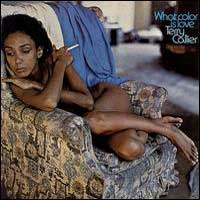 Gute Musik und ein hübsches Covergirl
Gute Musik und ein hübsches Covergirl
|
| Led Zeppelin: "Houses Of Holy" (Atlantic, März 1973) |
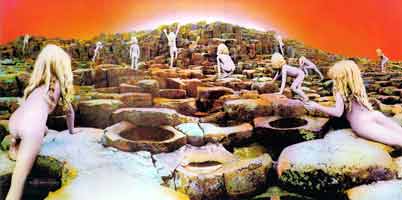 Das erste Album, das ich von Led Zep damals wahrgenommen habe und deshalb
für mich auch wichtiger als die Alben 1-4. Enthält mit "Rain
Song", "Ocean", "The Song Remains The Same" und
dem Reggae "D'yer Make'er" ein paar echte Killertracks. Außerdem
ist das ein geniales Cover.
Das erste Album, das ich von Led Zep damals wahrgenommen habe und deshalb
für mich auch wichtiger als die Alben 1-4. Enthält mit "Rain
Song", "Ocean", "The Song Remains The Same" und
dem Reggae "D'yer Make'er" ein paar echte Killertracks. Außerdem
ist das ein geniales Cover. |
| Terry Reid: "River" (Atlantic, März 1973) |
|
 Zu Terry Reid "Karriere" kann man nur sagen: was für
eine Verschwendung von Talent! Einer der besten britischen Rocksänger
hat es nach einem Hitalben in den späten 60ern in England seit
den 70ern bis heute in seiner Wahlheimat USA nur zu vier Platten gebracht,
die teilweise genial (wie diese) und teilweise nicht ganz so genial
waren, aber in jedem Fall kommerzielle Flops. In der 73er Truppe spielte
übrigens David Lindley seine unnachahmliche Slidegitarre!
Zu Terry Reid "Karriere" kann man nur sagen: was für
eine Verschwendung von Talent! Einer der besten britischen Rocksänger
hat es nach einem Hitalben in den späten 60ern in England seit
den 70ern bis heute in seiner Wahlheimat USA nur zu vier Platten gebracht,
die teilweise genial (wie diese) und teilweise nicht ganz so genial
waren, aber in jedem Fall kommerzielle Flops. In der 73er Truppe spielte
übrigens David Lindley seine unnachahmliche Slidegitarre!
Eine kleine Anekdote am Rande: Jimmy Page wollte Terry Reid
als Sänger für die späten Yardbirds gewinnen.
Dieser lehnte aber wegen seiner "Solokarriere" ab und empfahl
stattdessen den damals völlig unbekannten Robert Plant.
Dieser wurde zwar nicht der neue Yardbirds-Sänger, aber ...

 Mehr ...
Mehr ...
|
River was a looser and rootsier affair than Terry Reid's first records,
taken from a sprawl of sessions in London and California that generated
enough material for several albums. The very looseness that gives the
effort some charm is the same quality, however, that keeps it from being
a major work. The songs mostly sound unfinished, as if they're friendly
jams in which Reid and the musicians (including, most notably, David Lindley
on half the album and percussionist Willie Bobo on the title track) are
working out some song ideas or twisting around some riffs. It often brings
to mind those parts of songs where the likes of Van Morrison, Tim Buckley,
or Robert Plant sing-scat improvised-sounding vocal passages. The difference
is that, for the most part, those singers used such sections to embellish
solid songs. On River, the quasi-stream-of-consciousness vocal ramblings
are the songs. The first four of the seven songs are very much in a funky,
laid-back blues-rock groove, prominently featuring Lindley on steel, slide,
and electric guitars. Reid, and the album itself, really begin to find
more of an individual voice on "River," where beguiling Latin-Brazilian
elements are introduced in the guitar, melody, and rhythm. The final two
cuts, "Dream" and "Milestones," back Reid's vocals
only with acoustic guitar, and have a romantic melancholy that likewise
makes them highlights of this highly personal but uneven record.
(by Richie Unterberger, All
Music Guide)
|
|
| King Crimson: "Larks' Tongue In Aspic" (Island/E.G., März 1973) |
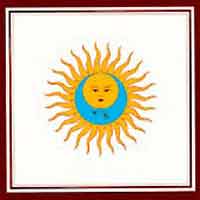 Auf dem fünften Album versammelte Robert Fripp eine komplett neue
Truppe um sich: Bill Bruford (dr), John Wetton (voc,bg),
David Cross (vio) und Jamie Muir (perc). Auch der Texter
Peter Sinfield war nicht mehr dabei. Diese Besetzung hielt relativ
lange (zumindest der Kern Fripp/Bruford/Wetton war auch auf dem nächsten
Album "Red" zu hören) und produzierte hier ein schräg/schönes Werk.
Auf dem fünften Album versammelte Robert Fripp eine komplett neue
Truppe um sich: Bill Bruford (dr), John Wetton (voc,bg),
David Cross (vio) und Jamie Muir (perc). Auch der Texter
Peter Sinfield war nicht mehr dabei. Diese Besetzung hielt relativ
lange (zumindest der Kern Fripp/Bruford/Wetton war auch auf dem nächsten
Album "Red" zu hören) und produzierte hier ein schräg/schönes Werk.

 Mehr ...
Mehr ...
King Crimson reborn yet again -- the then-newly configured band makes its debut with a violin (courtesy of David Cross) sharing center stage with Robert Fripp's guitars and his Mellotron, which is pushed into the background. The music is the most experimental of Fripp's career up to this time -- though some of it actually dated (in embryonic form) back to the tail-end of the Boz Burrell-Ian Wallace-Mel Collins lineup. And John Wetton was the group's strongest singer/bassist since Greg Lake's departure three years earlier. What's more, this lineup quickly established itself as a powerful performing unit, working in a more purely experimental, less jazz-oriented vein than its immediate predecessor. "Outer Limits music" was how one reviewer referred to it, mixing Cross' demonic fiddling with shrieking electronics, Bill Bruford's astounding dexterity at the drum kit, Jamie Muir's melodic and usually understated percussion, Wetton's thundering yet melodic bass, and Fripp's guitar, which generated sounds ranging from traditional classical and soft pop-jazz licks to hair-curling electric flourishes.
(by Bruce Eder, All Music Guide)
|
| Pink Floyd: "Dark Side Of The Moon" (EMI/Harvest, März 1973) |
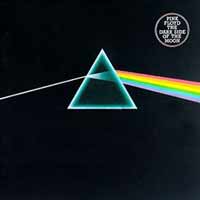 Kürzlich aus völlig unerfindlichen Gründen für mich wieder entdeckt:
Pink Floyd in den frühen bis mittleren 70ern. Vor allem mein
Lieblinxalbum "Wish You Were Here",
das erste, das ich mir damals angeschafft hatte, dann vielleicht etwas
überraschend "Relics",
die Resteverwertung von 1971 mit den frühen Singles von Syd Barrett,
aber eben auch diesen ersten "Megaseller". Wenn man das Album
nicht zu oft hört, dannist es wunderschön. Leider lief es damals
permanent und überall und hat mich, wie ich eben so bin, schnell
genervt.
Kürzlich aus völlig unerfindlichen Gründen für mich wieder entdeckt:
Pink Floyd in den frühen bis mittleren 70ern. Vor allem mein
Lieblinxalbum "Wish You Were Here",
das erste, das ich mir damals angeschafft hatte, dann vielleicht etwas
überraschend "Relics",
die Resteverwertung von 1971 mit den frühen Singles von Syd Barrett,
aber eben auch diesen ersten "Megaseller". Wenn man das Album
nicht zu oft hört, dannist es wunderschön. Leider lief es damals
permanent und überall und hat mich, wie ich eben so bin, schnell
genervt.
(05.01.2009) |
| Eagles: "Desperado" (Elektra/Asylum, April 1973) |
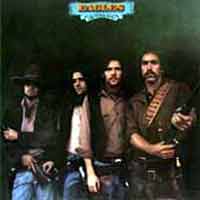 Der zweite Streich der Adler, immer noch toll (weil immer noch mit Bernie Leadon!),
noch vor ihrer Superstarperiode ab "Hotel California".
Neben dem wunderschönen Titelsong (von Don Henley gesungen)
liebe ich besonders heiß und innig Glenn Freys "Tequila
Sunrise".
Der zweite Streich der Adler, immer noch toll (weil immer noch mit Bernie Leadon!),
noch vor ihrer Superstarperiode ab "Hotel California".
Neben dem wunderschönen Titelsong (von Don Henley gesungen)
liebe ich besonders heiß und innig Glenn Freys "Tequila
Sunrise".

 Mehr ...
Mehr ...

If Don Henley was the sole member of the Eagles underrepresented on their debut album, Eagles, with only two lead vocals and one co-songwriting credit, he made up for it on their follow-up, the "concept" album Desperado. The concept had to do with Old West outlaws, but it had no specific narrative. On Eagles, the group had already begun to marry itself to a Southwest sound and lyrical references, from the Indian-style introduction of "Witchy Woman" to the Winslow, AZ, address in "Take It Easy." All of this became more overt on Desperado, and it may be that Henley, who hailed from Northeast Texas, had the greatest affinity for the subject matter. In any case, he had co-writing credits on eight of the 11 selections and sang such key tracks as "Doolin-Dalton" and the title song. What would become recognizable as Henley's lyrical touch was apparent on those songs, which bore a serious, world-weary tone. Henley had begun co-writing with Glenn Frey, and they contributed the album's strongest material, which included the first single, "Tequila Sunrise," and "Desperado" (strangely never released as a single). But where Eagles seemed deliberately to balance the band's many musical styles and the talents of the band's members, Desperado, despite its overarching theme, often seemed a collection of disparate tracks -- "Out of Control" was a raucous rocker, while "Desperado" was a painfully slow ballad backed by strings -- with other bandmembers' contributions tacked on rather than integrated. Randy Meisner was down to two co-writing credits and one lead vocal ("Certain Kind of Fool"), while Bernie Leadon's two songs, "Twenty-One" and "Bitter Creek," seemed to come from a different record entirely. The result was an album that was simultaneously more ambitious and serious-minded than its predecessor and also slighter and less consistent.
(by William Ruhlmann, All Music Guide)
|
| Pete Sinfield: "Still" (Manticore, Mai 1973) |


 Mehr ...
Mehr ...
Pete Sinfield ist den meisten Musikfans am besten bekannt durch die Lyrics, die er für King Crimson und Emerson Lake & Palmer schrieb. »Still« ist sein Debut-Solo-Album, das ursprünglich 1973 auf ELPs eigenem Label Manticore erschien und als Gastmusiker so illustre Kollegen wie Greg Lake, Ian Wallace, Mel Collins, John Wetton und Keith Tippet vorweisen kann.
As expected, Pete Sinfield's only solo attempt has the fingerprints of King Crimson covering every track, and the end result is an obvious but rather gratifying piece of early progressive rock. With fellow Crimsonites Greg Lake, Mel Collins, and John Wetton helping him out, Sinfield manages to capture a sturdy-enough progressive air across the length of the album, complemented by periodic injections of classical, rock, and jazz movements. While Sinfield's vocal contributions are a little uninviting, he makes up for it with the assistance of Greg Lake for the title track, which is a spoken-word poem set to Lake's singing. "The Song of the Sea Goat" is another well-crafted piece that applies classical tendencies borrowed from Vivaldi, and Collins comes alive with some exquisite flute playing throughout "The Piper," one of the album's strongest cuts. To Sinfield's credit, his surreal lyrics are mindful and well written, with a strong regard for prog rock's fantastical milieu, and because of this the album maintains its strength when the music itself begins to falter in some areas, such as on "Will It Be You" and "Envelopes of Yesterday." Tracks like "Wholefood Boogie" and "Under the Sky" are delightful emissions of keyboard-built progressive music that are wisely infused with mild doses of blues and synth-guided rock. Although the pieces that make up Still aren't as overwhelming as most of King Crimson's repertoire at the time, they do help illustrate Sinfield's talents as an individual, since his membership within his former band was seemingly overshadowed by the other personnel. Still isn't a crucial segment of progressive rock's uprising of the early '70s, but it does make for an entertaining sidebar for anyone interested in King Crimson's stock. The album was later reissued as Stillusion, with a different track sequence and revised liner notes.
(by Mike DeGagne, All Music Guide)
|
| Kevin Ayers: "Bananamour" (EMI/Harvest, Mai 1973) |
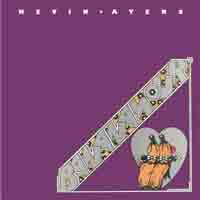
Damals ist dieses doch recht schräge Album noch komplett an mir vorbei
gegangen: somit hier also eine "späte Entdeckung". Ayers
spielte mal Bass bei Soft Machine, war aber für deren Entwicklung
hin zum Jazzrock nicht zu haben. Er schied aber wohl nicht im Streit,
denn seine ehemaligem Kollegen Robert Wyatt und Mike Ratledge
sind hier als Gäste dabei. Stattdessen wandelte er sich zum Singer/Songwriter
mit viel schön/schrägem britischen Charme und Humor, wodurch
seine markante Stimme wesentlich besser zum Tragen kam (schön tief
und wohl sehr sexy - soweit ich das als Mann beurteilen kann!). Unter
den Songs ragen das 8minütige "Decadence", Nico
gewidmet und auf's heftigste nach den Velvet
Underground klingend, das folkige "Shouting In A Bucket Blues"
mit treibender Akustikgitarre von Herrn Ayers und einem schönen
Gitarrensolo von Steve Hillage, sowie die 6/8-Soulballade "When
Your Parents Go To Sleep" (scharfe Bläser, die in meiner remasterten
CD so richtig reinknallen, und ein affenscharfer Chor mit 2 Mädelz
und einem Burschen: klingt verdammt nach Otis Redding - also
eine verdammt hohe Messlatte!) heraus.
Einziger nervender Punkt und auch eine Premiere: meine erste CD mit
Kopierschutz: als wenn mit Kevin Ayers-Raubkopien in großem Stil
Geschäfte zu machen wären! Zumindest läuft die CD nach
anfänglichem Ruckeln in meinem PC.
|
| Paul Kantner, Grace Slick & David Freiberg: "Baron von Tollbooth & The Chrome Nun" (RCA/Grunt, Mai 1973) |
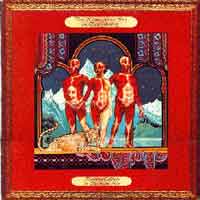 Die Platte habe ich mir eigentlich nur wegen des tollen Covers und Titels
gekauft, da ich kein so großer Jefferson
Airplane-Fan bin, als dass ich auch alle "Nebenprojekte"
der Leute besitzen muss. Es stellt sich aber heraus, dass es fast ein
"richtiges" Airplane-Album, sogar eins der besseren, ist. Immerhin
war David Freiberg (Ex-Quicksilver
Messenger Service) zuletzt auch JA-Mitglied (als Ersatz für Marty
Balin). Bei einzelnen Songs sind sogar die JA-Kollegen und Hot
Tuna-Separatisten Jorma Kaukonen und Jack Casady dabei.
Die meisten Gitarrenparts werden aber vom damals hyperfleißigen
Jerry Garcia und dem späteren Jefferson Starship-Crewmitglied
Craig Chaquico gespielt.
Die Platte habe ich mir eigentlich nur wegen des tollen Covers und Titels
gekauft, da ich kein so großer Jefferson
Airplane-Fan bin, als dass ich auch alle "Nebenprojekte"
der Leute besitzen muss. Es stellt sich aber heraus, dass es fast ein
"richtiges" Airplane-Album, sogar eins der besseren, ist. Immerhin
war David Freiberg (Ex-Quicksilver
Messenger Service) zuletzt auch JA-Mitglied (als Ersatz für Marty
Balin). Bei einzelnen Songs sind sogar die JA-Kollegen und Hot
Tuna-Separatisten Jorma Kaukonen und Jack Casady dabei.
Die meisten Gitarrenparts werden aber vom damals hyperfleißigen
Jerry Garcia und dem späteren Jefferson Starship-Crewmitglied
Craig Chaquico gespielt. |
| Tom Waits: "Closing Time" (Elektra/Asylum, Mai 1973) |
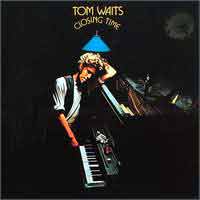 Waits Debüt hatte noch nichts von dem wüsten Stil der späteren
Jahre (z.B. "Swordfishtrombones"), ist aber trotzdem eine gelungene
Singer/Songwriterplatte mit vielen bekannten Liedern: "Ol' 55"
(von den Eagles gecovert), "Martha"
(einer der wenigen Songs, den Tim Buckley je gecovert hat!) und
"Rosie" (haben die Beat Farmers mal aufgenommen).
Waits Debüt hatte noch nichts von dem wüsten Stil der späteren
Jahre (z.B. "Swordfishtrombones"), ist aber trotzdem eine gelungene
Singer/Songwriterplatte mit vielen bekannten Liedern: "Ol' 55"
(von den Eagles gecovert), "Martha"
(einer der wenigen Songs, den Tim Buckley je gecovert hat!) und
"Rosie" (haben die Beat Farmers mal aufgenommen).
|
| "Copperhead" (Columbia, Mai 1973) |
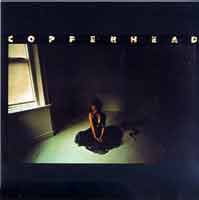 Copperhead gab's nur eine Saison. Es war der Versuch, um den Gitarrenhexer John
Cippolina eine erfolgreiche Truppe aufzubauen. Woran die ganze Sache
dann trotz dieser einen tollen Platte scheiterte, ist mir unklar: auf
jeden Fall wurden sie vor dem (großen?) Durchbruch von ihrer Plattenfirma
wie eine heiße Kartoffel wieder fallen gelassen und das war's dann.
Copperhead gab's nur eine Saison. Es war der Versuch, um den Gitarrenhexer John
Cippolina eine erfolgreiche Truppe aufzubauen. Woran die ganze Sache
dann trotz dieser einen tollen Platte scheiterte, ist mir unklar: auf
jeden Fall wurden sie vor dem (großen?) Durchbruch von ihrer Plattenfirma
wie eine heiße Kartoffel wieder fallen gelassen und das war's dann. |
| Dr. John: "In The Right Place" (Atlantic, Mai 1973) |
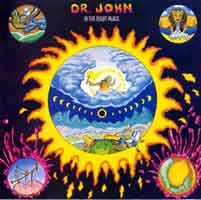 Dr. John aus New Orleans war bekannt als der Voodoo-Priester des Rock,
aber eigentlich ein ziemlich guter Blues- und Soulpianist und -sänger.
Auf dieser Platte war er weg von den Verkleidungsmätzchen der Vorjahre
und lieferte mit dem Produzenten Allen Toussaint und den Meters
(Organist Art Neville, Bassist George Porter, Gitarrist
Leo Nocentelli und Trommler Zigaboo Modeliste) als Begleitband
eine überzeugende Platte mit zwei seiner wichtigsten heutigen Konzertklassiker
ab: "Right Place, Wrong Time" und "Such A Night".
Dr. John aus New Orleans war bekannt als der Voodoo-Priester des Rock,
aber eigentlich ein ziemlich guter Blues- und Soulpianist und -sänger.
Auf dieser Platte war er weg von den Verkleidungsmätzchen der Vorjahre
und lieferte mit dem Produzenten Allen Toussaint und den Meters
(Organist Art Neville, Bassist George Porter, Gitarrist
Leo Nocentelli und Trommler Zigaboo Modeliste) als Begleitband
eine überzeugende Platte mit zwei seiner wichtigsten heutigen Konzertklassiker
ab: "Right Place, Wrong Time" und "Such A Night".

 Mehr ...
Mehr ...
The file texte/DrJohn-RightPlace.htm does not exist
|
| Gong: "Flying Teapot" (Byg/Virgin, Mai 1973) |
 Teil 1 "The Radio Gnome Invisible Trilogy".
Teil 2, "Angel's Egg", kam schon wenige Monate später.
Teil 1 "The Radio Gnome Invisible Trilogy".
Teil 2, "Angel's Egg", kam schon wenige Monate später.

 Mehr ...
Mehr ...
|
Produced by Giorgio Gomelsky, notable for his work with the Yardbirds,
Brian Auger, and Magma, this relatively early Gong project is a great
representation of the Daevid Allen-era Gong. Though not as intricate as
its follow-up companion piece, Angel's Egg, The Flying Teapot is more
of a true prog/space rock outing, where hippie-trippy lyrics and space
whispering abound, as evidenced in the opening track, "Radio Gnome
Invisible." The following cut, "Flying Teapot," is the
sprawling highlight of the album. At times reminiscent of some early Weather
Report jams, though not as jazzy, the tune features prominent bass, standout
percussion/drums, and space whispering courtesy of Smyth. Improvisational
groaning and percussion bring this jam to a close. "Pothead Pixies"
is a fun pop (pot?) tune which probably received very little, if any,
airplay due to the lyrics, followed by Blake's brief synth interlude,
"The Octave Doctors and the Crystal Machine." "Zero the
Hero and the Witch's Spell," another lengthy composition, features
Malherbe's sax playing, which, at this early point in the Gong evolution,
is credited for most of the jazz sounds heard in the music (remember,
Pierre Moerlen has yet to join the band). This cut becomes quite heavy
near its end before making a clever transition into the final cut, "Witch's
Song/I Am Your Pussy." Here you hear Smyth's strange, sexually explicit
lyrics, which she embellishes with ethereal voicings and cackling. This,
combined with a jazzy sax from Malherbe and some very groovy musical lines
near the closing, make for another fun tune.
(by David Ross Smith, All
Music Guide)
|
|
| Can: "Future Days" (United Artists/Spoon, Juni 1973) |
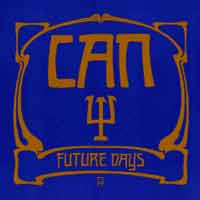 Die dritte Produktion Deutschlands bester Rockband mit dem japanischen "Sänger"
Damo Suzuki war m. E. die letzte Großtat der Band. Danach
ließen sie ein wenig nach (was allerdinx bei Musikern solchen Kalibers
immer noch mehr ist, als andere je schaffen werden!).
Die dritte Produktion Deutschlands bester Rockband mit dem japanischen "Sänger"
Damo Suzuki war m. E. die letzte Großtat der Band. Danach
ließen sie ein wenig nach (was allerdinx bei Musikern solchen Kalibers
immer noch mehr ist, als andere je schaffen werden!). |
| Van Morrison: "Hard Nose The Highway" (Warner, Juni 1973) |
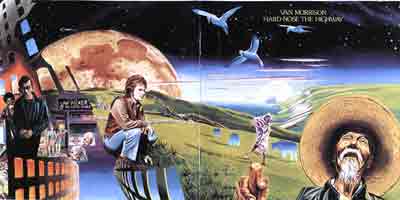 Dieses Morrison-Album hat es mir nicht leicht gemacht! Gekauft habe ich es erst
lange nachdem ich die beiden Killeralben Tupelo
Honey (von 1971) und Veedon Fleece
(von 1974) schon als Doppelalbum hatte (vielleicht kennt der eine
oder andere von euch ja noch diese "Twoofer"-Doppelalben: "Two
Originals Of ..."). Auf jeden Fall schien für mich dazwischen
lange Zeit erstmal kein Platz für mehr Van Morrison zu sein. Als
ich mir die Platte dann irgendwann doch mal billig gekauft habe (wahrscheinlich
bei Zweitausendeins"), schreckte mich zuerst der klassische Chor
in der Eröffnungsnummer "Snow In San Anselmo" ab. Danach
kommt aber die schöne Singleauskopplung "Wild Love", die
auch auf Tupleo Honey gepasst hätte.
Und im Titelstück läuft Van schließlich doch noch zu Höchstform
auf. Insgesamt vielleicht nicht Vans Meisterwerk - aber immer noch besser
als das, was die meisten anderen "Künstler" so rauslassen!
Und wie gefällt euch das schöne Covergemälde? So was gibt's
heute leider nicht mehr!
Dieses Morrison-Album hat es mir nicht leicht gemacht! Gekauft habe ich es erst
lange nachdem ich die beiden Killeralben Tupelo
Honey (von 1971) und Veedon Fleece
(von 1974) schon als Doppelalbum hatte (vielleicht kennt der eine
oder andere von euch ja noch diese "Twoofer"-Doppelalben: "Two
Originals Of ..."). Auf jeden Fall schien für mich dazwischen
lange Zeit erstmal kein Platz für mehr Van Morrison zu sein. Als
ich mir die Platte dann irgendwann doch mal billig gekauft habe (wahrscheinlich
bei Zweitausendeins"), schreckte mich zuerst der klassische Chor
in der Eröffnungsnummer "Snow In San Anselmo" ab. Danach
kommt aber die schöne Singleauskopplung "Wild Love", die
auch auf Tupleo Honey gepasst hätte.
Und im Titelstück läuft Van schließlich doch noch zu Höchstform
auf. Insgesamt vielleicht nicht Vans Meisterwerk - aber immer noch besser
als das, was die meisten anderen "Künstler" so rauslassen!
Und wie gefällt euch das schöne Covergemälde? So was gibt's
heute leider nicht mehr! |
| Pink Fairies: "Kings Of Oblivion" (Polydor, Juni 1973) |
 Dies ist bereits das dritte Album des britische Heavy-Blues-Rock-Trios,
aber das erste mit dem neuen Sänger/Gitarristen Larry Wallis.
Eine Band, die "Pink F." heißt und auf dem Cover fliegende
Schweine hat: höre ich da jemanden "geistigen Diebstahl"
rufen? Bedenke er doch bitte das Erscheinungsjahr dieser "Könige
der Vergessenheit". Nomen est omen. Leider.
Dies ist bereits das dritte Album des britische Heavy-Blues-Rock-Trios,
aber das erste mit dem neuen Sänger/Gitarristen Larry Wallis.
Eine Band, die "Pink F." heißt und auf dem Cover fliegende
Schweine hat: höre ich da jemanden "geistigen Diebstahl"
rufen? Bedenke er doch bitte das Erscheinungsjahr dieser "Könige
der Vergessenheit". Nomen est omen. Leider.
(13.07.2008)

 Mehr ...
Mehr ...
|
The third and final Pink Fairies studio album, Kings of Oblivion, welcomed
guitarist Larry Wallis to the brew, bringing with him some of the band's
most remarkable -- and concise -- material yet. The opening "City
Kids," famously recut by Motörhead during Wallis' sojourn with
that band, is as dynamic an opener as the Pink Fairies ever had, while
the album's two epics, "I Wish I Was a Girl" and "Street
Urchin," similarly catch the band as they made a sharp turn away
from the rockin' riff jam basics that scarred their second LP, What a
Bunch of Sweeties, and moved instead into the affirmative guttercat stance
that so effectively predicted the rudiments of punk rock. Indeed, if any
album could be said to have been born ahead of its time, Kings of Oblivion,
conceived in 1973 but sounding just like 1977, is it. In common with the
rest of the remastered Pink Fairies albums, Kings of Oblivion divides
its bonus tracks between unfamiliar versions of familiar material (most
pressingly, an urgent alternate mix of "City Kids") and non-album
material. This includes two versions of the loping "Well Well Well"
and the country rock-ish "Hold On" dating from 1972, and a single
cut with Wallis' short-lived predecessor, Mick Wayne, and it's gratifying
to have them on CD at last. Truly, though, Kings of Oblivion could exist
just as happily without the extras; greeted at the time as the Pink Fairies'
best album, it remains a tightly coiled, furiously adrenalined beast,
the summation of everything that the Pink Fairies promised and all that
subsequent reunions have continued to deliver.
(by Dave Thompson, AMG)
|
|
| Carlos Santana & John McLaughlin: "Love Devotion Surrender" (Columbia, Juni 1973) |
 Auch ich konnte damals bei Veröffentlichung mit dem Album nichts anfangen,
denn es geht hier beim gemeinsamen Album der Gitarrenstars aus den Sparten
Rock und Jazz um eine Hommage an den großen John Coltrane,
von dem "A Love Supreme"
und das wunderschöne "Naima"
gespielt werden. Gleich vier Drummer sind zu hören: Billy
Cobham und Jan Hammer vom Mahavishnu
Orchestra, Mike Shrieve von Santana sowie Jazzer Don Alias.
Wer sich jetzt wundert, warum Jan Hammer nicht hinter den Keyboards saß,
der sollte wissen, das die Orgel von einem der allerbesten bedient wird:
Larry Young. Laßt Euch auch nicht von der
Guru-Frömmerlei abschrecken, an der ich selber eigentlich nichts
störendes finde, solange hier nicht bekehrt werden soll, denn es
geht um nichts als Musik. OK - die weißen Anzüge sehen ziemlich
beknackt aus. Aber: was soll's?
Auch ich konnte damals bei Veröffentlichung mit dem Album nichts anfangen,
denn es geht hier beim gemeinsamen Album der Gitarrenstars aus den Sparten
Rock und Jazz um eine Hommage an den großen John Coltrane,
von dem "A Love Supreme"
und das wunderschöne "Naima"
gespielt werden. Gleich vier Drummer sind zu hören: Billy
Cobham und Jan Hammer vom Mahavishnu
Orchestra, Mike Shrieve von Santana sowie Jazzer Don Alias.
Wer sich jetzt wundert, warum Jan Hammer nicht hinter den Keyboards saß,
der sollte wissen, das die Orgel von einem der allerbesten bedient wird:
Larry Young. Laßt Euch auch nicht von der
Guru-Frömmerlei abschrecken, an der ich selber eigentlich nichts
störendes finde, solange hier nicht bekehrt werden soll, denn es
geht um nichts als Musik. OK - die weißen Anzüge sehen ziemlich
beknackt aus. Aber: was soll's?
(04.09.2009) |
| Gila: "Bury My Heart At Wounded Knee" (Warner, Juli 1973) |
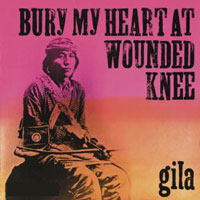 Lost & Found!
Lost & Found!
(13.07.2008)

 Mehr ...
Mehr ...
|
Whereas the first record was psychedelic space rock acid jams, on their second album, Gila, now consisting of mostly Popol Vuh members, offered something far more sedate. Though Conny Veit was always the leader of Gila, this one comes off much more like a solo effort. The record is a concept album inspired by the book of the same name by Dee Alexander Brown that brought the plight of the North American Indians to international attention. Complex multi-tracked acoustic guitar melodies create a shimmering, even haunting beauty in a lushly Baroque setting, while some of the lyrics are taken from various Native American texts. "The Buffalo Are Coming," with its long instrumental section as well as Native American styled rhythms and chanting, is the high point. Otherwise the vocals distract somewhat from the music, and the whole thing comes off as too much with a smooth new age vibe, especially when compared to the acid-damage blastoff of the earlier Gila album.
(by Rolf Semprebon, All
Music Guide)
|
|
| Krokodil: "Sweat And Swim" (Bellaphon/Bacillus, Juli 1973) |
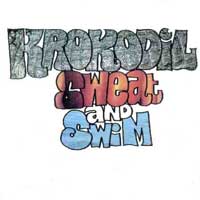 Fünftes und letztes Album der besten Schweizer Rockband. Und wie schon bei "An
Invisible World Revealed", ihrer letzten Arbeit für Liberty,
ein Album ohne Grenzen und kommerzielle Kompromisse, dieses mal sogar
als Doppelalbum. Die Spannbreite ist für Krautrockbands jener Zeit
(wir wollen, weil es Schweizer sind, natürlich nicht von einer Deutschrockband
sprechen!) sehr breit: zwischen 17-minütigen Bluesrockjams und kurzen
Folksongs ist alles möglich. Neben den guten eigenen Songs gibt es
sogar drei Coverversionen, ungewöhnlich sowohl für die Band,
also auch für das ganze Genre damals: man musste ja immer "kreativ"
und "eigenständig" sein. Da durfte man ja schließlich
nicht covern. Auch nicht Elvis Presley ("That's Alright Mama",
eigentlich ein Blues von Arthur Crudup), Bob Dylan ("Talking
World War III Blues") und Kris Kristofferson ("Billy
Dee"). Auf Anraten der Plattenfirma wurde diese Tatsache auf dem
Cover auch etwas "verschleiert": nach dem Hinweis "all
titles written by Krokodil, published by Bellver, except..."
erfolgt für die oben genannten drei Lieder nur der Hinweis auf den
jeweiligen Musikverlag. Es wird also nicht wirklich gelogen!
Fünftes und letztes Album der besten Schweizer Rockband. Und wie schon bei "An
Invisible World Revealed", ihrer letzten Arbeit für Liberty,
ein Album ohne Grenzen und kommerzielle Kompromisse, dieses mal sogar
als Doppelalbum. Die Spannbreite ist für Krautrockbands jener Zeit
(wir wollen, weil es Schweizer sind, natürlich nicht von einer Deutschrockband
sprechen!) sehr breit: zwischen 17-minütigen Bluesrockjams und kurzen
Folksongs ist alles möglich. Neben den guten eigenen Songs gibt es
sogar drei Coverversionen, ungewöhnlich sowohl für die Band,
also auch für das ganze Genre damals: man musste ja immer "kreativ"
und "eigenständig" sein. Da durfte man ja schließlich
nicht covern. Auch nicht Elvis Presley ("That's Alright Mama",
eigentlich ein Blues von Arthur Crudup), Bob Dylan ("Talking
World War III Blues") und Kris Kristofferson ("Billy
Dee"). Auf Anraten der Plattenfirma wurde diese Tatsache auf dem
Cover auch etwas "verschleiert": nach dem Hinweis "all
titles written by Krokodil, published by Bellver, except..."
erfolgt für die oben genannten drei Lieder nur der Hinweis auf den
jeweiligen Musikverlag. Es wird also nicht wirklich gelogen!
Aufgenommen wurde in Vierkanal-Quadrophonie, 1973 der letzte Schrei und
heute im Zeitalter von Dolby-5-Punkt-Dingenskirchen längst vergessen,
im damaligen "Hightec" Studio von Dieter Dierks, zur
Unterstützung holte man sich den Keyboarder Veit Faiden, den
Gitarristen Rainer Marz und auch Ex-Sänger/Geiger Hardy
Hepp hinzu. Insgesamt eine schöne Rockplatte, die ich lange nicht
mehr gehört habe!
(20.01.2005)

 Mehr ...
Mehr ...
Unter solch einem Haufen Platten nach stundenlangem Hören noch an sich selbst zu denken und sowas wie eine "Lieblings-LP" herauszufinden, ist nicht einfach. Aber bei Krokodils Doppelalbum SWEAT AND SWIM ... machte mir die Suche einfach. Endlich mal eine Gruppe, die sich dem Rhythm & Blues verschrieben hat. Jede Menge echter Ohrwürmer sind auf der Platte, z.B. die Auftaktnummer "Talking Worid War III Blues". Drei Harmonien hat das Stück, aber die bekommen durch die monotone Wiederholung eine unbeschreibliche Faszination. Vor allen Dingen aber ist wichtig, wer sie wie wiederholt. Walti Anselmos Sprechgesang mit einer verrücktmachend spröden Stimme vorgetragen, sein Gitarrenspiel (hier zusammen mit Gast Rainer Marz), Moyo Weidelis jammernde Mundharmonika, Terry Stevens Bass-Stakkatos und Düde Dürsts tour de force auf dem Schlagzeug, das alles zusammen ist so technisch perfekt, hat soviel Swing und zeugt von soviel Phantasie, daß man sich an den Kopf' fasst und sich fragen muß, weshalb denn dais Krokodil bei uns immer noch im Schatten dahinvegetiert - Schade, der Platz hier reicht leider nicht aus, sich weiter zu begeistern. Bei dieser Platte würde ich es gerne tun. Doch ein Stück muss ich noch erwähnen, nämlich "Linger", das die gesamte Seite 3 einnimmt. Ganz langsam, mit einem langen Flötensolo von Moyo Weideli, schleicht es sich in den Kopf, um dann immer schneller werdend mit raisenden Gitarren und heulendem Synthesizer dort zu explodieren. Wen's interessiert, das Ganze ist übrigens in echtem Vierkanal aufgenommen. Ich hab's bei einem reichen Mann getestet, und das macht die Platte tatsächlich noch besser. Nur, wer hat schon Geld zuviel?
(Sounds, 1973)
15er 140g-Vinyl-Reissue, Klappcover. Von 1973. Damals z.B. in der „Sounds“ hoch gelobt, sind die Schweizer nun ziemlich vergessen. Im Zentrum steht das 18-minütige Linger, das ganz zart beginnened sich immer mehr hypnotisch verdichtet, de Gitarren- teilweise von Flöten-Dominanz und sanftem Gesang abgelöst – ob man das jetzt Psyche, Prog oder Kraut nennt, ist egal. Später wird daraus ein Boogie-Guitar-Jam ähnlich Man (an die auch der leise Beginn erinnert). Ansonsten: Neben dem wunderbaren poetischen Kris Kristofferson-Cover Baby Dee (purer Songwriter-Country!) und einem langen Roots-Rocker viel Blues/R´n´B-Einfluß, gern in rockender/abziehender Form, mal lakonisch in Lou Reed-Nähe, auch kleine Psyche/Prog-Spritzerchen, Wah-Wah. Oft unterstützt eine Harmonica die Gitarren.
(dvd, Glitterhouse 2015)
|
| Deke Leonard: "Iceberg" (United Artists, Juli 1973) |
 Der Ausstieg des Man-Gitarristen im letzten Jahr brachte 2 sehr
schöne, aber nicht sonderlich erfolgreiche Soloalben. Er fehlte deshalb
kurioserweise auf den beiden besten Man-Alben: "Be
Good To Yourself, At Least Once A Day" von 1972 und dem im September
1973 erscheinenden "Back Into The Future"),
was aber keine falschen Rückschlüsse bedeuten soll, denn diese
beiden Soloalben sind durchaus gelungen. Es gab auch wohl keinen Krach
untereinander, denn die alten Man-Kollegen sind alle mit dabei, genauso
wie die Musiker von Help Yourself,
mit denen er bei der Weihnachtsparty "Christmas
At The Patti" spielte. Im nächsten Jahr brachte das Personalkarussell
Deke dann wieder zurück zu seiner Stammband und er blieb diesmal
dabei ...
Der Ausstieg des Man-Gitarristen im letzten Jahr brachte 2 sehr
schöne, aber nicht sonderlich erfolgreiche Soloalben. Er fehlte deshalb
kurioserweise auf den beiden besten Man-Alben: "Be
Good To Yourself, At Least Once A Day" von 1972 und dem im September
1973 erscheinenden "Back Into The Future"),
was aber keine falschen Rückschlüsse bedeuten soll, denn diese
beiden Soloalben sind durchaus gelungen. Es gab auch wohl keinen Krach
untereinander, denn die alten Man-Kollegen sind alle mit dabei, genauso
wie die Musiker von Help Yourself,
mit denen er bei der Weihnachtsparty "Christmas
At The Patti" spielte. Im nächsten Jahr brachte das Personalkarussell
Deke dann wieder zurück zu seiner Stammband und er blieb diesmal
dabei ...

 Mehr ...
Mehr ...
|
Released in July 1973, Iceberg was the first of Deke Leonard's solo career.
It was recorded at Rockfield, Olympic and Mayfair studios between October
1972 and February 1973.
His departure from the Manband did at least give Deke a chance to produce
a record the way he wanted to, and for him to involve a wider range of
guest musicians to help him out. This added freedom resulted in a much
more song-oriented album than Man would produce, and spawned some perennial
live favourites as well. Deke's memory of this time is pretty clear; "I
loved every second. I had total freedom. I didn't have to consult anybody.
If I liked it, I did it."
Photography and art direction were by Pierre Tubbs and the gatefold cover
was originally overlayed onto a silvered background. The silvering and
the gatefold were lost with later re-issues. It features a Bristol Fighter
biplane from the Shuttleworth Collection. The distinctive guitar is Deke's
trusty zebra-striped and cutaway Telecaster, at the time sporting a Stratocaster
neck. Twenty years later the guitar was stolen from a dressing room in
Hamm, Germany, and Deke would very much like it back. The album was launched
at a one-off gig at The Imperial War Museum in London, with a road band
that comprised Deke, Brian Breeze, Paul Burton and Keith Hodge. When the
single 'A Hard Way To Live' was released in August 1973 critical reaction
was unanimously positive; "If you wanna boogie or even a drop of
jive, then you can't beat Deke. It could even be a hit. In fact I'll stake
my boots on it." said Chris 'no boots' Welch in Melody Maker. Despite
being voted onto the BBC Radio One playlist, airplay failed to convert
into sales for 'Hard Way To Live' when UA weren't ready with enough pressed
singles to ride the wave. Deke though was; "The closest Llanelli
will get to producing a rock music genius."
(www.manband-archive.com)
|
|
| The Allman Brothers Band: "Brothers And Sisters" (Capricorn, Aug. 1973) |
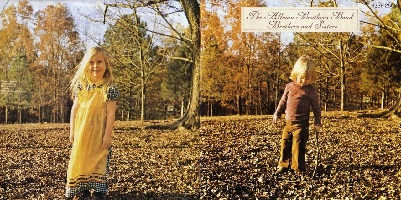 Slidegitarrengott Duane Allman und Bassist Berry Oakley waren beide im Harley-Himmel
und obwohl man mit dem Ende der Band rechnete, hatten sie plötzlich
mit Ramblin Man und dem Instrumentalsong Jessica (kennt wohl jeder von
WDR2) ihre größten Hits. Man hatte Duane Allman bewusst nicht
durch einen neuen Gitarristen ersetzt, sondern mit Chuck Leavell
einen begnadeten Pianisten in die Band genommen, Sänger Greg Alman
konzentrierte sich auf die Hammond und gelegentliche Ausflüge an
die akustische Gitarre. Bei den Trommlern (zwei wie bei den "seelenverwandten"
Grateful Dead!) blieb alles beim alten, am Bass mit Lamar Williams
natürlich ein neuer Mann. Der verbliebene Gitarrist Dickey Betts
aber übernahm die vakante Führungsrolle und so geriet dieses
vierte und erfolgreichste Album deutlich countrylastiger, ohne natürlich
das Southern Feeling zu verlieren. Eines der klassischen Allman Studioalben
und #1 in US-Charts.
Slidegitarrengott Duane Allman und Bassist Berry Oakley waren beide im Harley-Himmel
und obwohl man mit dem Ende der Band rechnete, hatten sie plötzlich
mit Ramblin Man und dem Instrumentalsong Jessica (kennt wohl jeder von
WDR2) ihre größten Hits. Man hatte Duane Allman bewusst nicht
durch einen neuen Gitarristen ersetzt, sondern mit Chuck Leavell
einen begnadeten Pianisten in die Band genommen, Sänger Greg Alman
konzentrierte sich auf die Hammond und gelegentliche Ausflüge an
die akustische Gitarre. Bei den Trommlern (zwei wie bei den "seelenverwandten"
Grateful Dead!) blieb alles beim alten, am Bass mit Lamar Williams
natürlich ein neuer Mann. Der verbliebene Gitarrist Dickey Betts
aber übernahm die vakante Führungsrolle und so geriet dieses
vierte und erfolgreichste Album deutlich countrylastiger, ohne natürlich
das Southern Feeling zu verlieren. Eines der klassischen Allman Studioalben
und #1 in US-Charts. |
| "Maria Muldaur" (Reprise, Aug. 1973) |

An dieser Platte liebe ich das, was ich auch an vielen Emmylou Harris-
und Linda Ronstadt-Alben so schätze: Klasse Songs (durchweg
Fremdmaterial, meist unbekannt, sodass man neue und unbekannte alte
Songschreiber entdecken kann) und virtuose aber sehr relaxte Begleitmusiker,
die immer songdienlich spielen.

 Mehr ...
Mehr ...
|
From the sweet to the salacious to the poignant, Maria Muldaur's eponymous,
strong debut features savvy studio vets, talented guests, strong tunes,
and Muldaur's lissome pipes. The outstanding players include Ry Cooder,
David Grisman, Clarence White, and Mac Rebennack, better known as Dr.
John. A tasteful guitar solo by the underrated Amos Garrett elevates the
charming surprise hit single "Midnight at the Oasis." Although
she later gravitated to jazz and gospel, Muldaur's first outing is heavy
on songs derived from country and blues. A rousing "Work Song,"
borrowed from Kate & Anna McGarrigle, is only one of several highlights.
(by Mark Allan, All
Music Guide)
|
|
| "Ougenweide"(Polydor/Zebra, Aug. 1973) |
|
 Das Debütalbum, noch ohne Sängerin Minne Graw, aber im Prinzip ist alles
schon da, was diese Band ausmacht: historische Texte, teilweise in Alt-
oder Mittelhochdeutsch, unterlegt mit (damals) zeitgemäßem
Folk und Folkrock. Wichtigste Beteiligte waren damals nach meiner Einschätzung
Sänger, Schlagzeuger und "Übersetzer" Olaf Casalich
und Multiinstrumentalist Frank Wulff, der sich kompetent auf
nahezu allem versucht, was Saiten hat oder in das man hineinblasen kann.
Das Debütalbum, noch ohne Sängerin Minne Graw, aber im Prinzip ist alles
schon da, was diese Band ausmacht: historische Texte, teilweise in Alt-
oder Mittelhochdeutsch, unterlegt mit (damals) zeitgemäßem
Folk und Folkrock. Wichtigste Beteiligte waren damals nach meiner Einschätzung
Sänger, Schlagzeuger und "Übersetzer" Olaf Casalich
und Multiinstrumentalist Frank Wulff, der sich kompetent auf
nahezu allem versucht, was Saiten hat oder in das man hineinblasen kann.
(17.07.2010)
|
| Stevie Wonder: "Innervisions" (Tamla Motown, Aug. 1973) |


 Mehr ...
Mehr ...
|
"Stevie Wonder may be blind, but he reads the national
landscape, particularly regarding black America, with penetrating insight
on Innervisions, the peak of his 1972-73 run of albums -- including Music
of My Mind and Talking Book. Fusing social realism with spiritual idealism,
Wonder brings expressive color and irresistible funk to his synth-based
keyboards on "Too High" (a cautionary anti-drug song) and "Higher
Ground" (which echoes Martin Luther King Jr.'s message of transcendence).
The album's centerpiece is "Living for the City," a cinematic
depiction of exploitation and injustice. Just three days after Innervisions
was released, Wonder suffered serious head injuries and lay in a four-day
coma when the car he was traveling in collided with a logging truck."
(Rolling Stone)
Total album sales: Under 500,000 * Peak chart position:
4
|
|
| Tim Buckley: "Sefronia" (Discreet, Sept. 1973) |
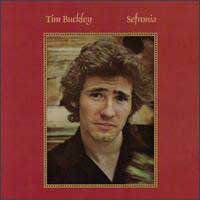 Das vorletzte Album. Und angeblich nicht mehr so toll. Mir gefällt es
aber immer noch gut genug: besser ein schwächeres Album von Tim Buckley
als ein gutes von so manch anderem "Künstler". Immerhin
mit der Studioversion von "The
Dolphins" von Fred Neil,
das er ja live schon seit längerem im Programm hatte. Und "Martha"
vom damals noch relativ unbekannten Songschreiber Tom Waits.
Das vorletzte Album. Und angeblich nicht mehr so toll. Mir gefällt es
aber immer noch gut genug: besser ein schwächeres Album von Tim Buckley
als ein gutes von so manch anderem "Künstler". Immerhin
mit der Studioversion von "The
Dolphins" von Fred Neil,
das er ja live schon seit längerem im Programm hatte. Und "Martha"
vom damals noch relativ unbekannten Songschreiber Tom Waits. |
| Kevin Coyne: "Marjory Razor Blade" (Virgin, Sept. 1973) |
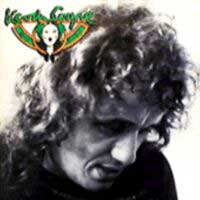 In der Grabbelkiste gefunden.
In der Grabbelkiste gefunden.
(28.01.2006)

 Mehr ...
Mehr ...
This obscure musician has made some unforgettable albums, like Case History and this sprawling masterpiece. His themes are often very dark (fellow Brit Nick Drake’s “Black Eyed Dog” comes to mind when I listen to Coyne) and deals with stuff like insanity, despair, abuse and all manner of deviancies. He’s also a sharp satirist, as demonstrated by Dog Latin, This Is Spain and Good Boy, in which he respectively sends up organised religion, holidays in Spain and the public school system. Eastbourne Ladies also falls into this category. Everybody Says is a beautiul acoustic ballad and Mummy is a sweeping wall-of-sound rocker. His voice is not unlike Van Morrison’s in its scope and expressive range, but while Van’s is likely to be affected by spiritual ecstacy, Coyne’s can be twisted with rage or anguish, as on the title track. Marlene is a catchy number with gorgeous organ and guitar, a galoping beat and a sinister undertone. Talking To No One and House On The Hill are anguished but moving ballads about alienation and insanity. Lonesome Valley is more of the same, but over an uptempo beat and complex vocal arrangement where his voice really shines. Other great tracks include I Want My Crown, Nasty and Chairman’s Ball. With his chosen subject matter, it’s no surprise that Coyne has remained obscure. Still, I think that fans of Leonard Cohen, Richard Thompson, Marianne Faithfull, Nick Drake, Nico, Lydia Lunch and especially Swans, will find much here to appreciate.
|
| Grateful Dead: "Wake Of The Flood" (Grateful Dead, Sept. 1973) |
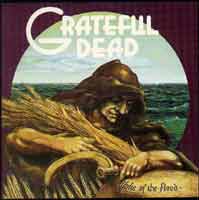 Die erste Veröffentlichung auf dem bandeigenen Plattenlabel - eine
wunderbare Platte (ich bin als verkappter "Deadhead" da aber
wohl nicht besonders objektiv). Deshalb hier nur ein paar Fakten: die
erste Platte nach dem Tod von Pigpen und auch die erste Studioproduktion
mit dem neuen Keyboarder Keith Godchaux, der hier auch zum ersten
und einzigen mal in seiner Deadzeit singt ("Let Me Sing Your Blues
Away"). Ebenfalls neu dabei seine Frau Donna Jean Godchaux als
Chorsängerin (sie tritt aber kaum in Erscheinung und war wegen ihrer
Rolle in der Band auch immer ein Diskussionspunkt für Fans). Von
Jerry Garcia gibt es mehrere gute Songs ("Half-Step Missisppi...",
"Stella Blue" und "Row Jimmy"), nur die Single "Eyes
Of The World" ist nach meiner Geschmack etwas schwächer. Von
Bob Weir hören wir eine mehrteilige "Weather Report
Suite", Bill Kreutzmann muss z. Z. ohne seinen Trommelpartner
Mickey Hart auskommen, Phil Lesh ist am Bass wie immer genial,
aber mal wieder ohne eigene Songs und Gesangsversuche. Ungewöhnlich
ist die große Anzahl von Gastmusikern (Doug Sahm, Matt
Kelly, Vassar Clements, Martin Fierro u.a.). Das Album
wurde übrigens von der Band Jazz Is Dead komplett gecovert
("Laughing Water", Zebra 1999)!
Die erste Veröffentlichung auf dem bandeigenen Plattenlabel - eine
wunderbare Platte (ich bin als verkappter "Deadhead" da aber
wohl nicht besonders objektiv). Deshalb hier nur ein paar Fakten: die
erste Platte nach dem Tod von Pigpen und auch die erste Studioproduktion
mit dem neuen Keyboarder Keith Godchaux, der hier auch zum ersten
und einzigen mal in seiner Deadzeit singt ("Let Me Sing Your Blues
Away"). Ebenfalls neu dabei seine Frau Donna Jean Godchaux als
Chorsängerin (sie tritt aber kaum in Erscheinung und war wegen ihrer
Rolle in der Band auch immer ein Diskussionspunkt für Fans). Von
Jerry Garcia gibt es mehrere gute Songs ("Half-Step Missisppi...",
"Stella Blue" und "Row Jimmy"), nur die Single "Eyes
Of The World" ist nach meiner Geschmack etwas schwächer. Von
Bob Weir hören wir eine mehrteilige "Weather Report
Suite", Bill Kreutzmann muss z. Z. ohne seinen Trommelpartner
Mickey Hart auskommen, Phil Lesh ist am Bass wie immer genial,
aber mal wieder ohne eigene Songs und Gesangsversuche. Ungewöhnlich
ist die große Anzahl von Gastmusikern (Doug Sahm, Matt
Kelly, Vassar Clements, Martin Fierro u.a.). Das Album
wurde übrigens von der Band Jazz Is Dead komplett gecovert
("Laughing Water", Zebra 1999)!

 Mehr ...
Mehr ...
After satisfying their nine-title/dozen-disc deal with Warner Brothers, the Dead began their own record labels: Grateful Dead Records (for group releases) and Round Records (for solo projects). Wake of the Flood was the first Dead disc issued entirely under the band's supervision -- which also included manufacturing and marketing. Additionally, the personnel had been altered as Ron "Pigpen" McKernan had passed away. The keyboard responsibilities were now in the capable hands of Keith Godchaux -- whose wife Donna Jean Godchaux also provided backing vocals. It had been nearly three years since American Beauty -- their previous and most successful studio album to date -- and, as always, the Dead had been honing the material in concert. A majority of the tracks had been incorporated into their live sets -- some for nearly six months -- prior to entering the recording studio. This gave the band a unique perspective on the material, much of which remained for the next 20-plus years as staples of their concert performances. However, the inspiration and magic of the Grateful Dead's music has always been a challenge to capture in the non-reciprocal confines of a studio. Therefore, while Wake of the Flood was certainly as good -- if not arguably better than -- most of their previous non-live efforts, it falls far short of the incendiary performances the band was giving during this era. There are a few tracks that do tap into some of the Dead's jazzier and exceedingly improvisational nature. "Eyes of the World" contains some brilliant ensemble playing -- although the time limitations inherent in the playback medium result in the track fading out just as the Dead start to really cook. Another highlight is Bob Weir's "Weather Report Suite," which foreshadows the epic proportions that the song would ultimately reach. In later years, the band dropped the opening instrumental "Prelude," as well as "Part One," choosing to pick it up for the extended "Let It Grow" section. The lilting Jerry Garcia ballad "Stella Blue" is another track that works well in this incarnation and remained in the Dead's rotating set list for the remainder of their touring careers.
(by Lindsay Planer, All Music Guide)
|
| Ian Matthews: "Valley Hi" (Elektra, Sept. 1973) |
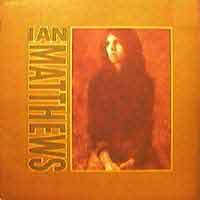 Nach der kurzen ersten Plainsong-Episode
zog es Ian nach Kalifornien. Dort nahm er unter der Produktionsaufsicht
von Ex-Monkee Michael Nesmith diese Platte mit einer seiner besten
Eigenkompositionen ("Keep On Sailing") auf. Seine größte
Stärke lag aber in der Interpretation von Liedern anderer Autoren:
"These Days" (Jackson Browne), "Seven Bridges Road"
(Steve Young) und weitere Lieder von Richard Thompson, Randy Newman, Don
Gibson und Michael Nesmith.
Nach der kurzen ersten Plainsong-Episode
zog es Ian nach Kalifornien. Dort nahm er unter der Produktionsaufsicht
von Ex-Monkee Michael Nesmith diese Platte mit einer seiner besten
Eigenkompositionen ("Keep On Sailing") auf. Seine größte
Stärke lag aber in der Interpretation von Liedern anderer Autoren:
"These Days" (Jackson Browne), "Seven Bridges Road"
(Steve Young) und weitere Lieder von Richard Thompson, Randy Newman, Don
Gibson und Michael Nesmith. |
| Man: "Back Into The Future" (United Artists, Sept. 1973) |
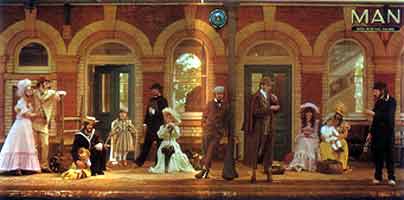 Dieses Doppelalbum ist eine der bekanntesten Man-Platten geblieben. Eine
Platte live, die andere im Studio zeigten Micky Jones, Terry
Williams, Phil Ryan, Will Youatt und den Neuzugang Tweke
Lewis (Ex-Wild Turkey) auch
künstlerisch klar im oberen grünen Bereich. Nur Deke Leonard
war nicht dabei (er kehrte aber zum nächsten Album "Rhinos,
Winos + Lunatics" von seinem erfolglosen Soloausflug "Iceberg"
zurück). Von dieser Platte stammt der Konzertklassiker "C'mon".
Dieses Doppelalbum ist eine der bekanntesten Man-Platten geblieben. Eine
Platte live, die andere im Studio zeigten Micky Jones, Terry
Williams, Phil Ryan, Will Youatt und den Neuzugang Tweke
Lewis (Ex-Wild Turkey) auch
künstlerisch klar im oberen grünen Bereich. Nur Deke Leonard
war nicht dabei (er kehrte aber zum nächsten Album "Rhinos,
Winos + Lunatics" von seinem erfolglosen Soloausflug "Iceberg"
zurück). Von dieser Platte stammt der Konzertklassiker "C'mon".

 Mehr ...
Mehr ...
|
08er Reissue, remastered von den Originaltapes. Die 73er Doppel-LP (CD 1) gilt für viele als ihre beste, auch für mich! Das Problem aller Man-Alben, das "Füllmaterial", beschränkt sich auf 2 Stücke auf (Studio-)LP 1. Die enthält aber auch das schlicht großartige total eingängige Titelstück, dessen massiver Pop-Appeal auch anderswo aufblitzt, viel ganz starken Gesang, feinste Harmony-Stimmen, auffällig gut kombinierte/harmonierende Gitarren/Keyboards (incl. einiger Slide-Parts), neben 4 kürzeren 2 knapp 8-minütige typische kraftvolle gute Man-Rocker. Und dann Seite 3 (live wie die 4.), das beste, was es von Man auf Tonträger gibt: Zunächst singt (höchst beeindruckend!) ein großer walisischer Männerchor ein Traditional, dann 19 Min. Gänsehaut, auch beim 20. Hören: DIE Version ihres besten Songs, C´Mon. Der hinreißende Spannungsaufbau… die berauschenden Gitarren über die volle Distanz… der wunderwunderschöne lange Mittelteil, dream-like, in höheren Sphären schwebend (klasse Keyboards! Wieder der Männerchor!)… die tollen Vocals… Purer Genuß, ohne Längen!! Seite 4: Klassischer 21-Min.-Jam, z.T. "Spunk Rock"-basiert, straight/durchgehend treibend, voller punktierter Orgel, jagender Gitarrenduelle, viel besser als vorherige Versuche. Unveröff. Bonus (noch nicht gehört): 2 Studioouttakes sowie das komplette o.g. Konzert, u.a. mit Bananas. Pflicht.
(glitterhouse.de)
|
|
|
Rock music is littered with bands that wrecked on the studio/live double
album concept; Man is rare in that their attempt, despite the departure
of Clive John, brought them their first real success. The band's tight
performance and increasingly ambitious musical experimentation made Back
Into the Future the first Man album to chart in the U.K.; when it hit
#23, it was to be the band's high-water mark. Despite the band's live
reputation, the studio album probably holds greater interest for listeners
today. The title track is a lyrical evocation of the album's charming
cover art -- a staged before-and-after shot of a railway station in its
Edwardian prime, and then in modern decrepitude. The song's wistful glance
at the past blurs with dabs of modern psychedelia, and it conveys the
post-Sergeant Pepper fascination of British rockers with the costumed
grandeur of Empire past. But it is "Ain't Their Fight," with
its echoing vocals and windmilling guitar riffs, that stands out as one
of the band's most satisfying tracks.
Most of the rest of the album is comprised of lengthy instrumentals,
but the opening "Never Say Nups to Nepalese" is worth noting
for its gloriously crashing crescendo, cheerfully lifted from Pink Floyd's
"Echoes." And while the live set uses a male choir to haunting
effect in the slow psychedelic jam of "C'mon," it's more typified
by the indulgent 21-minute boogie marathon of "Jam Jelly Up Tight."
Much like the third record of George Harrison's All Things Must Pass,
it must have seemed a great idea when stoned, but it's interminable today.
Nonetheless, the album stands up as a fine artifact of the band's heyday.
(by Paul Collins, All
Music Guide)
|
|
| Poco: "Crazy Eyes" (Epic, Sept. 1973) |
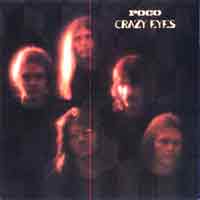 Schönes Album der Band, die in ihrem Marktsegment "Countryrock" immer
im Schatten der Eagles stand und zweimal den
Bassisten abtreten musste. Sänger/Gitarrist Richey Furay
war mal bei Buffalo Springfield
und gründete zusammen mit Pedalsteeler Rusty Young und Drummer
George Grantham die Band. Bassist Timothy B. Schmitt kam
für den zu den Eagles abgewanderten
Randy Meisner und löste ihn später auch dort wieder
ab (Poco = Farmteam der Eagles?), Gitarrist Paul Cotton war für
Jim Messina (zusammen mit Furay in der letzten Buffalo Springfield-Besetzung
und später mit "Loggins & Messina" erfolgreich) dazu
gestoßen. Erwähnenswert sind zwei schöne Coverversionen,
die zu meinen absoluten Lieblingssongs gehören: "Brass
Buttons" von Gram Parsons (dessen eigene Version erst
im nächsten Jahr auf "Grievous
Angel" posthum veröffentlicht wird) und das wunderschöne
"Magnolia" von J.J.Cale.
Schönes Album der Band, die in ihrem Marktsegment "Countryrock" immer
im Schatten der Eagles stand und zweimal den
Bassisten abtreten musste. Sänger/Gitarrist Richey Furay
war mal bei Buffalo Springfield
und gründete zusammen mit Pedalsteeler Rusty Young und Drummer
George Grantham die Band. Bassist Timothy B. Schmitt kam
für den zu den Eagles abgewanderten
Randy Meisner und löste ihn später auch dort wieder
ab (Poco = Farmteam der Eagles?), Gitarrist Paul Cotton war für
Jim Messina (zusammen mit Furay in der letzten Buffalo Springfield-Besetzung
und später mit "Loggins & Messina" erfolgreich) dazu
gestoßen. Erwähnenswert sind zwei schöne Coverversionen,
die zu meinen absoluten Lieblingssongs gehören: "Brass
Buttons" von Gram Parsons (dessen eigene Version erst
im nächsten Jahr auf "Grievous
Angel" posthum veröffentlicht wird) und das wunderschöne
"Magnolia" von J.J.Cale.
|
| Popol Vuh: "Seligpreisung" (Kosmische Musik, Sept. 1973) |
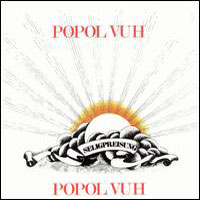
|
| Lou Reed: "Berlin" (RCA, Sept. 1973) |
 Das Album nach "Transfomer"
- eine schwere Hypothek, da "Walk On The Wild Side" kaum zu
toppen war. Trotzdem eine gute Scheibe.
Das Album nach "Transfomer"
- eine schwere Hypothek, da "Walk On The Wild Side" kaum zu
toppen war. Trotzdem eine gute Scheibe. |
| Jesse Colin Young: "Song For Juli" (Warner, Sept. 1973) |
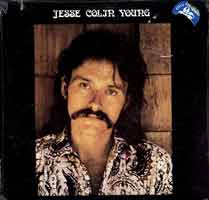 Wenn ich einem Marsmenschen erklären müsste, was gute Laidback-Musik
ist, würde ich ihm möglicherweise das zweite Soloalbum des ehemaligen
Sängers der Youngbloods
(kennt die überhaupt noch jemand?) vorspielen.
Wenn ich einem Marsmenschen erklären müsste, was gute Laidback-Musik
ist, würde ich ihm möglicherweise das zweite Soloalbum des ehemaligen
Sängers der Youngbloods
(kennt die überhaupt noch jemand?) vorspielen. |
| Neil Young: "Time Fades Away" (Reprise, Sept. 1973) |
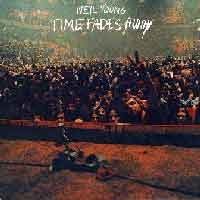
Nach der kommerziell erfolgreichen "Harvest"
erschreckte Neil Young viele Fans mit den folgenden Platten. Auch ich
konnte damals mit "Time Fades Away" nichts anfangen. Erst
im Nachhinein wurde mir die Qualität dieses Albums klar. Die fast
durchweg neuen Songs wurden alle live aufgenommen, was wohl auch für
das damalige Publikum gewöhnungsbedürftig war, die natürlich
lieber die "Hits" gehört hätten. Nur "Journey
Through The Past", eine schöne Klavierballade, kannte der
eine oder andere schon, der den merkwürdigen gleichnamigen "Spielfilm"
von Neil Young gesehen oder den ebenso merkwürdigen Soundtrack
gehört hatten. Gibt's immer noch nicht auf CD!
Nachtrag: Inzwischen sind das Meisterwerk "On
The Beach", der Flickenteppich "American
Stars 'N Bars" sowie die eher unwichtigen Alben "Reactor"
und "Haws & Doves" als Silberlinge erschienen. Nur "Time
Fades Away" und der krude Soundtrack "Journey Through The
Past" fehlen auch weiterhin!
(August 2003)
|
| Atlantis: "It's Getting Better" (Vertigo, Okt. 1973) |
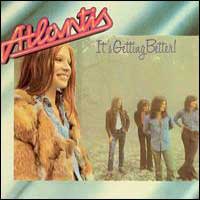 Kaum mehr als ein halbes Jahr ist vergangen seit dem Debütalbum "Atlantis"
- und es geht tatsächlich noch besser! Inga Rumpf ist gesanglich
in Topform und nicht nur auf dem Cover in übergröße neben
ihren Jungs. Aber auch die haben es natürlich drauf an ihren Instrumenten.
Besonders schön gefallen mir die fast jazzigen Passagen auf dem Fender-Rhodes
E-Piano von Monsieur Kravetz. Auch Dieter Bornschlegel,
der Nachfolger von Frank Diez an der Gitarre (und bald darauf selber schon
wieder weg vom Fenster...), macht seine Sache sehr gut.
Kaum mehr als ein halbes Jahr ist vergangen seit dem Debütalbum "Atlantis"
- und es geht tatsächlich noch besser! Inga Rumpf ist gesanglich
in Topform und nicht nur auf dem Cover in übergröße neben
ihren Jungs. Aber auch die haben es natürlich drauf an ihren Instrumenten.
Besonders schön gefallen mir die fast jazzigen Passagen auf dem Fender-Rhodes
E-Piano von Monsieur Kravetz. Auch Dieter Bornschlegel,
der Nachfolger von Frank Diez an der Gitarre (und bald darauf selber schon
wieder weg vom Fenster...), macht seine Sache sehr gut.
Atlantis waren vielleicht sogar besser als ihre Vorgängerband Frumpy,
bekamen aber leider nie die gleiche Anerkennung. Vielleicht weil sie ganz
bewusst nicht versuchten "deutsch" zu klingen, also "krautrockig",
sondern eher "international"? Das höchste Lob von Snobs
war damals: "für eine deutsche Band ganz gut!". Auch ich
muss zugeben, dass ich mich dieser Haltung nicht ganz entziehen konnte
und kann aus der Distanz heraus jetzt klar sagen: tolle Band. Sie hätten
richtig groß werden können.
(Dez. 2006) |
| Brinsley Schwarz: "Please Don't Ever Change" (United Artists, Okt. 1973) |
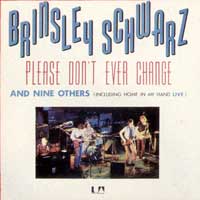 Zwar nicht mein Lieblinxalbum der Pubrockband um den Sänger, Bassisten
und Songschreiber Nick Lowe, aber eben trotzdem ein gutes Album
...
Zwar nicht mein Lieblinxalbum der Pubrockband um den Sänger, Bassisten
und Songschreiber Nick Lowe, aber eben trotzdem ein gutes Album
... |
| Jackson Browne: "For Everyman" (Asylum, Okt. 1973) |
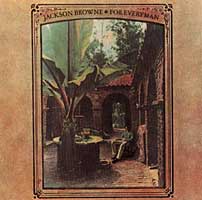 Jacksons zweiter Geniestreich, besser produziert als der Vorgänger, gute bis
sehr gute Songs (z.B. "Take It Easy", die Kollaboration mit
Eagle Glenn Frey oder "These Days", das Nico
schon ein paar Jahre vorher mit Jackson aufnahm). In der Begleitband erstmalig
sein langjähriger musikalischer Partner David Lindley.
Jacksons zweiter Geniestreich, besser produziert als der Vorgänger, gute bis
sehr gute Songs (z.B. "Take It Easy", die Kollaboration mit
Eagle Glenn Frey oder "These Days", das Nico
schon ein paar Jahre vorher mit Jackson aufnahm). In der Begleitband erstmalig
sein langjähriger musikalischer Partner David Lindley. |
| Caravan: "For Girls Who Grew Plumb At Night" (Decca/Deram, Okt. 1973) |
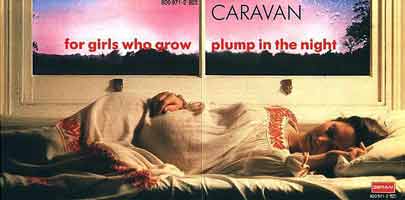 Die einzige englische Band aus der "Progrock"-Ecke neben Van
Der Graaf Generator, für die ich mich wirklich erwärmen
kann. Wahrscheinlich tut man der Band aus Canterbury mit diesem Etikett
aber sowieso nur Unrecht.
Die einzige englische Band aus der "Progrock"-Ecke neben Van
Der Graaf Generator, für die ich mich wirklich erwärmen
kann. Wahrscheinlich tut man der Band aus Canterbury mit diesem Etikett
aber sowieso nur Unrecht.

 Mehr ...
Mehr ...
After the musical uncertainty of Waterloo Lily, Caravan returned with their most inspired recording since In the Land of the Grey and Pink. The splendidly titled For Girls Who Grow Plump in the Night is several steps ahead in terms of fresh musical ideas that wholly incorporate the band's trademark humor within the otherwise serious and challenging sonic structures. Two of the more dominant reasons for the change in Caravan's sound were the return of keyboardist Dave Sinclair and the addition of violist Peter Geoffrey Richardson. Die-hard fans gladly welcomed Sinclair back, however, Richardson was met with heckles from enthusiasts during live appearances. They were soon silenced as his place on For Girls Who Grow Plump in the Night easily ranks among Caravan's watershed moments. There are perhaps none better than the mesmerizing counterpoint melodies he weaves during the "L'Auberge Du Sanglier" suite. While not completely abandoning their jazz leanings, For Girls Who Grow Plump In The Night is considerably focused back into the rock genre. Ironically, the album also features some rather elaborate orchestration. In context, it is quite effective in creating emphasis -- especially on the leadoff track "Memory Lain, Hugh," as well as the dreamy mid-tempo "The Dog, The Dog, He's At It Again." The remastered CD also includes five additional tracks. The first four are demos featuring the band without orchestra and with some notable differences, such as the distinct lead guitar opening to "Memory Lain, Hugh." "Derek's Long Thing" is another instrumental piece penned by keyboardist Derek Austin -- one of the two transitional Caravan members chosen to replace Steve Miller. A must-own for inclined parties.
(by Lindsay Planer, All Music Guide)
|
| Genesis: "Selling England By The Pound" (Charisma, Okt. 1973) |
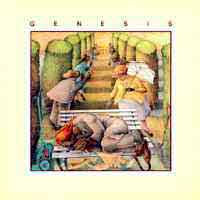 Leute, bitte nicht wundern! Diese Platte hat wenig mit der furchtbaren Hitfabrik aus
den 80ern und 90ern, mit und ohne Phil Collins, zu tun. Der trommelte
damals zwar schon bei der Band (sogar ziemlich gut!), durfte auch bei
einem Luied singen, Hauptsänger war aber Peter Gabriel, von
dem ich zwar auch kein Fan bin, der aber immerhin kein Hitparadenfuzzi
mit Seichtigkeiten im Programm ist. Man nennt so was heutzutage Progressive-Rock
- und da kann ich eigentlich auch überhaupt nicht drauf: Trotzdem
mag ich diese Platte, wenn vielleicht auch nur aus nostalgischen Gründen.
Wie auch immer: inzwischen kann ich das zugeben, ohne mich zu genieren.
Leute, bitte nicht wundern! Diese Platte hat wenig mit der furchtbaren Hitfabrik aus
den 80ern und 90ern, mit und ohne Phil Collins, zu tun. Der trommelte
damals zwar schon bei der Band (sogar ziemlich gut!), durfte auch bei
einem Luied singen, Hauptsänger war aber Peter Gabriel, von
dem ich zwar auch kein Fan bin, der aber immerhin kein Hitparadenfuzzi
mit Seichtigkeiten im Programm ist. Man nennt so was heutzutage Progressive-Rock
- und da kann ich eigentlich auch überhaupt nicht drauf: Trotzdem
mag ich diese Platte, wenn vielleicht auch nur aus nostalgischen Gründen.
Wie auch immer: inzwischen kann ich das zugeben, ohne mich zu genieren.

 Mehr ...
Mehr ...
Genesis proved that they could rock on Foxtrot but on its follow-up Selling England by the Pound they didn't follow this route, they returned to the English eccentricity of their first records, which wasn't so much a retreat as a consolidation of powers. For even if this eight-track album has no one song that hits as hard as "Watcher of the Skies," Genesis hasn't sacrificed the newfound immediacy of Foxtrot: they've married it to their eccentricity, finding ways to infuse it into the delicate whimsy that's been their calling card since the beginning. This, combined with many overt literary allusions -- the Tolkeinisms of the title of "The Battle of Epping Forest" only being the most apparent -- gives this album a storybook quality. It plays as a collection of short stories, fables, and fairy tales, and it is also a rock record, which naturally makes it quite extraordinary as a collection, but also as a set of individual songs. Genesis has never been as direct as they've been on the fanciful yet hook-driven "I Know What I Like (In Your Wardrobe)" -- apart from the fluttering flutes in the fade-out, it could easily be mistaken for a glam single -- or as achingly fragile as on "More Fool Me," sung by Phil Collins. It's this delicate balance and how the album showcases the band's narrative force on a small scale as well as large that makes this their arguable high-water mark.
(by Stephen Thomas Erlewine, All Music Guide)
|
| John Martyn: "Inside Out" (Island, Okt. 1973) |
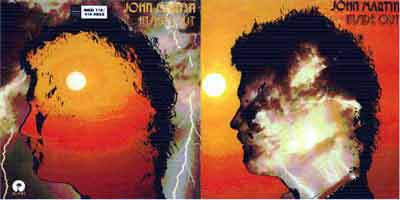 Dieses schöne John Martyn-Album sollte allmählich mal neu auf CD veröffentlicht
werden, denn meine alte Kassettenkopie gibt langsam aber sicher ihren
Geist auf!
Dieses schöne John Martyn-Album sollte allmählich mal neu auf CD veröffentlicht
werden, denn meine alte Kassettenkopie gibt langsam aber sicher ihren
Geist auf! |
| New Riders On The Purple Sage: "Panama Red" (Columbia, Okt. 1973) |
 Das "Hitalbum" der Band. Eigentlich war die Band ja nur als Testfeld
für die Pedalsteel-Experimente von Jerry Garcia gedacht, doch
dann kam das beim Publikum so gut an, dass mehr daraus wurde. Der viel
beschäftigte Jerry wurde deshalb auch auf dem nächsten Album
durch Buddy Cage ersetzt. Herausragend zwei Songs, die Peter
Rowan für die Band schrieb: der Titelsong und "Lonesome
L.A. Cowboy". Neben dem Sänger John Dawson taten sich
jetzt auch den anderen Bandmitglieder (Gitarrist David Nelson,
Drummer Spencer Dryden und vor allem Bassist Davd Torbert)
als Songschreiber hervor.
Das "Hitalbum" der Band. Eigentlich war die Band ja nur als Testfeld
für die Pedalsteel-Experimente von Jerry Garcia gedacht, doch
dann kam das beim Publikum so gut an, dass mehr daraus wurde. Der viel
beschäftigte Jerry wurde deshalb auch auf dem nächsten Album
durch Buddy Cage ersetzt. Herausragend zwei Songs, die Peter
Rowan für die Band schrieb: der Titelsong und "Lonesome
L.A. Cowboy". Neben dem Sänger John Dawson taten sich
jetzt auch den anderen Bandmitglieder (Gitarrist David Nelson,
Drummer Spencer Dryden und vor allem Bassist Davd Torbert)
als Songschreiber hervor. |
| Walter Wegmüller/Die Kosmischen Kuriere: "Tarot" (Ohr, Okt. 1973) |
 Lost & Found!
Lost & Found!
(03.08.2008) |
| Billy Cobham: "Spectrum" (Atlantic, Nov. 1973) |
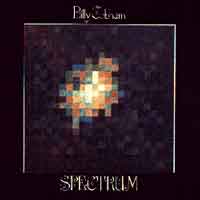 Das Solodebüt des angeblich besten Jazzrockdrummers aller Zeit - und deshalb eigentlich
für mich erst Recht kein Grund, diese Platte zu mögen, weil
Jazzrock ja nie so ganz mein Ding war und ist. Aber dieser Platte (die
schon seit Mitte der 70er besitze!), ist einfach klasse, daran führt
kein Weg vorbei. Das liegt zum einen an den guten Komposition (eine Nummer
wurde später sogar von Massive
Attack zum Hit verarbeitet!) und der Produktion von Mr. Cobham (während
sein virtuoses Schlagzeugspiel oft einen Tacken übertrieben ist),
zum anderen aus der tollen Band, die eben Jazz UND Rock drauf hatte: Jan
Hammer aus alten Mahavishnu-Orchestra-Tagen an E-Piano und Synthesizer,
L.A.-Studiobassist Lee Sklar, der Mann mit dem ZZ-Top-Rauschebart,
den man damals eher von Jackson Browne- und James Taylor-Platten und heute
von Phil Collins-Konzerten kennt, dazu der damals gerade mal 22jährige
Gitarrist Tommy Bolin, der wenig später Richie Blackmore bei
Deep Purple ersetzte (auf "Come And Taste The Band" von
1975) und ein Jahr danach den frühen Drogentod starb.
Das Solodebüt des angeblich besten Jazzrockdrummers aller Zeit - und deshalb eigentlich
für mich erst Recht kein Grund, diese Platte zu mögen, weil
Jazzrock ja nie so ganz mein Ding war und ist. Aber dieser Platte (die
schon seit Mitte der 70er besitze!), ist einfach klasse, daran führt
kein Weg vorbei. Das liegt zum einen an den guten Komposition (eine Nummer
wurde später sogar von Massive
Attack zum Hit verarbeitet!) und der Produktion von Mr. Cobham (während
sein virtuoses Schlagzeugspiel oft einen Tacken übertrieben ist),
zum anderen aus der tollen Band, die eben Jazz UND Rock drauf hatte: Jan
Hammer aus alten Mahavishnu-Orchestra-Tagen an E-Piano und Synthesizer,
L.A.-Studiobassist Lee Sklar, der Mann mit dem ZZ-Top-Rauschebart,
den man damals eher von Jackson Browne- und James Taylor-Platten und heute
von Phil Collins-Konzerten kennt, dazu der damals gerade mal 22jährige
Gitarrist Tommy Bolin, der wenig später Richie Blackmore bei
Deep Purple ersetzte (auf "Come And Taste The Band" von
1975) und ein Jahr danach den frühen Drogentod starb.

 Mehr ...
Mehr ...
Drummer Billy Cobham was fresh from his success with the Mahavishnu Orchestra when he recorded his debut album, which is still his best. Most of the selections showcase Cobham in a quartet with keyboardist Jan Hammer, guitarist Tommy Bolin, and electric bassist Lee Sklar. Two other numbers include Joe Farrell on flute and soprano and trumpeter Jimmy Owens with guitarist John Tropea, Hammer, bassist Ron Carter, and Ray Barretto on congas. The generally high-quality compositions (which include "Red Baron") make this fusion set a standout, a strong mixture of rock-ish rhythms and jazz improvising.
(by Scott Yanow, All Music Guide)
|
| Elliott Murphy: "Aquashow" (Polydor, Nov. 1973) |
 Das Debüt eines der unterbewertetsten Singer/Songwriter aus den USA.
Er hatte damals wie viele seiner Kollegen (z.B. Loudon
Wainwright III) den Stress, der neue "Bob Dylan" sein zu
müssen. Was er natürlich nicht war. Seine wahren Fans hat er
inzwischen in Europa gefunden, wo er nun schon lange lebt und regelmäßig
schöne, aber kommerziell unbedeutende Alben herausbringt.
Das Debüt eines der unterbewertetsten Singer/Songwriter aus den USA.
Er hatte damals wie viele seiner Kollegen (z.B. Loudon
Wainwright III) den Stress, der neue "Bob Dylan" sein zu
müssen. Was er natürlich nicht war. Seine wahren Fans hat er
inzwischen in Europa gefunden, wo er nun schon lange lebt und regelmäßig
schöne, aber kommerziell unbedeutende Alben herausbringt.

 Mehr ...
Mehr ...
| With all the praise accorded every other artist anointed
with the "new Dylan" tag, Elliott Murphy burst onto the scene
in 1973 wearing the mantle proudly. His debut, Aquashow, came on like the
son of Blonde on Blonde, but with the streetwise poetic bent of Lou Reed.
And, as is the case with most 24-year-olds armed with pen, paper, guitar,
and harmonica, he has plenty to say. There is the tendency to wield a heavy
hand when it comes to his takes on love, fame, growing up, and the underbelly
of middle-class life, but Murphy, whose insights cut deeper than the majority
of writers his age, is successful more often than not. If the irony of "How's
the Family" or the overstated "Marilyn Monroe died for our sins"
are a bit much, tracks such as "Hangin' Out," "Scrapbook
Graveyard," and "Last of the Rock Stars" more than make up
for it, painting a vivid picture of disenfranchised youth - searching yet
self-destructive. Still, as good as Murphy can be lyrically, it's the music
that first draws you in. From his own electric guitar, and a rhythm section
made up of brother Matthew Murphy and Byrd Gene Parsons, to Highway 61 Revisited
pianist Frank Owens' organ and piano, Murphy creates some of the most convincing
Dylan-esque folk-rock to come along since 1966. In and out of print over
the years, Aquashow, thanks to a keen eye, intelligence, and a sparse, straightforward
sound that stays clear of trends, remains a minor classic. - Brett Hartenbach
|
|
| Nektar: "Remember The Future" (Bellaphon/Bacillus, Nov. 1973) |
 Diese Platte hatte ich lange vergessen und erst kürzlich wieder entdeckt.
Vier in Hamburg ansässige Engländer zeigten mit den beiden ganzseitigen
Teilen der Suite "Remember The Future" (solch überlange
Songmonster galten damals als sehr stilvoll!) ihren bekannteren Kollegen
von Pink Floyd und Yes, wo der Hammer hängt.
In Deutschland waren sie damit die kleinen Könige und konnten in
England und den USA zumindest einen Achtungserfolg erzielen. Bei allen
berechtigten Berührungsängsten gegenüber dem, was man heute
"Progrock" nennt, ist das hier aber trotzdem eine schöne
Platte, mit in der großen Suite versteckten wunderschönen kleinen Popsongs!
Diese Platte hatte ich lange vergessen und erst kürzlich wieder entdeckt.
Vier in Hamburg ansässige Engländer zeigten mit den beiden ganzseitigen
Teilen der Suite "Remember The Future" (solch überlange
Songmonster galten damals als sehr stilvoll!) ihren bekannteren Kollegen
von Pink Floyd und Yes, wo der Hammer hängt.
In Deutschland waren sie damit die kleinen Könige und konnten in
England und den USA zumindest einen Achtungserfolg erzielen. Bei allen
berechtigten Berührungsängsten gegenüber dem, was man heute
"Progrock" nennt, ist das hier aber trotzdem eine schöne
Platte, mit in der großen Suite versteckten wunderschönen kleinen Popsongs!

 Mehr ...
Mehr ...
Mit ihrem unverwechselbaren Psychedelic- / Prog-Rock-Mix zählt die britische Formation Nektar bis zum heutigen Tage zu den führenden Formationen des Genres. So konnte man sich letztjährig im Rahmen des Burg-Herzberg-Festivals (Juli 2010) von den überragenden Live-Qualitäten der Band überzeugen, die seit ihrer Gründung mehr als zwanzig Longplayer veröffentlichte, darunter das 1973 auf dem Label Bacillus erschienene Konzeptalbum „Remember The Future“.
Das Werk, das in den USA seinerzeit Goldstatus erreichte, zählt bis heute den erfolgreichsten und beliebesten Veröffentlichungen der Band. Kompositorisch auf höchstem Niveau, fusionieren auf dieser (für Nektar-Verhältnisse) vergleichsweise sanften zweiteiligen Suite symphonische Progressive-Rock-Klänge und psychedelisch groovender Spacerock (inklusive luftigem West-Coast-Flair) zu einem perfekt strukturierten, epischen Meisterwerk. Stehen bei Part 1 vornehmlich die opulenten Keyboardsounds von Allan Freeman im Mittelpunkt des musikalischen Geschehens, so dominieren die virtuos rockenden Soloexkursionen von Gitarrist Roye Albrighton den zweiten Teil ihres vierten Longplayers.
Das Prog-Rock-Meisterwerk der Briten aus dem Jahr 1973 ist natürlich wie geschaffen für eine Vinyl-Wiederveröffentlichung. Zwei (mehrteilige) Tracks, jeder jeweils eine LP-Seite lang, eine aufklappbare LP-Hülle mit lesbaren Texten und Musik, bei der Roye Albrighton (g, voc), Allan Freeman (keys, voc), Derek Moore (b, voc) und Ron Howden (dr, voc) nur so vor Kreativität strotzen.
(Good Times, Oktober / November 2011)
()
|
| Bonnie Raitt: "Takin' My Time" (Warner, Nov. 1973) |
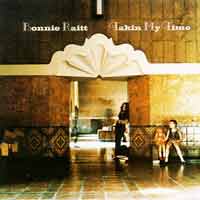

 Mehr ...
Mehr ...
| Featuring a diverse and eclectic range
of material and some of the best performances of her recording career, Bonnie
Raitt's 1973 album Takin My Time is an evocative tour de force from one
of contemporary music's most inventive and influential performers. Featuring
songs by Mose Allison, Jackson Browne, Randy Newman and blues legend Fred
McDowell, Takin My Time also boasts an all-star musical lineup which includes
Taj Mahal and various members of Little Feat. Born and raised in Los Angeles,
Bonnie Raitt grew up in a vibrantly musical family. Her father, Broadway
singing star John Raitt, was an avid music collector and by age 12 his daughter
was already picking out songs on the guitar, demonstrating an early affinity
for the blues. It was an affinity that carried on through her college years
at Radcliffe, where she played regularly in campus clubs and coffee houses.
In 1969 Raitt left school to pursue a musical career. Playing with such
artists as Howlin' Wolf, Mississippi Fred MeDowell and Sippie Wallace, she
quickly garnered a glowing reputation on the East Coast folk and blues circuit.
A year later she recorded her debut album, Bonnie
Raitt, for Warner Bros. Records, cutting material by Wallace, Stephen
Stills and Paul Seibel. Raitt's wide-ranging musical tastes were also reflected
on her second LP, 1972's Give
It Up. Dividing her time between touring and recording, Raitt established
herself as both a polished performer and promising songwriter. Her instrumental
abilities also set her apart: in addition to piano and electric guitar,
she was one of the few women at the time to master bottleneck guitar playing.
Early in 1973, Raitt returned to the studio with producer John Hall to record
her third LP. A full complement of friends and session musicians included
Little Feat's Lowell George, Bill Payne and Paul Barrere, drummer Jim Keltner,
sax master Ernie Watts, fretless bass virtuoso Freebo and Taj Mahal on guitar,
harp and backing vocals. Ranging stylistically from the calypso of "Wah
She Go Do," to the pure blues of the Fred McDowell medley "Write
Me A Few Of Your Lines/ Kokemo Blues," Takin My Time also spotlights
material from such promising young tunesmiths as Eric Kaz ("Cry Like
A Rainstorm"), Randy Newman ("Guilty") and Jackson Browne
("I Thought I Was A Child"). |
|
| Santana: "Welcome" (Columbia, Nov. 1973) |
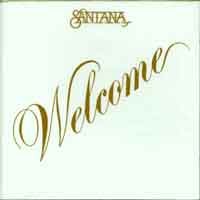 Das jazzigste Album der Band hatte damals viele "normale" Fans eher
überfordert, dabei ist es doch eine wunderschöne Platte. Fest
dabei als Sänger und Jodler (!) ist Leon Thomas, der schon
auf dem Meisterwerk "Karma"
von Saxophonist Pharoah Sanders seine Stimme erhoben hatte. Weitere
Gäste aus der Jazzecke: John McLaughlin, Airto Moreira,
Flora Purim und Herbie Mann. Da verwundert es vielleicht
auch nicht mehr, dass das Titelstück von John Coltrane stammt.
Das jazzigste Album der Band hatte damals viele "normale" Fans eher
überfordert, dabei ist es doch eine wunderschöne Platte. Fest
dabei als Sänger und Jodler (!) ist Leon Thomas, der schon
auf dem Meisterwerk "Karma"
von Saxophonist Pharoah Sanders seine Stimme erhoben hatte. Weitere
Gäste aus der Jazzecke: John McLaughlin, Airto Moreira,
Flora Purim und Herbie Mann. Da verwundert es vielleicht
auch nicht mehr, dass das Titelstück von John Coltrane stammt. |
| Ringo Starr: "Ringo" (Apple, Nov. 1973) |


 Mehr ...
Mehr ...
With Ringo, Ringo Starr finally put his solo career in gear in 1973, after serving notice with back-to-back Top Ten singles in 1971 and 1972 that he had more to offer than his eccentric first two solo albums. Ringo was a big-budget pop album produced by Richard Perry and featuring Ringo's former Beatles bandmates as songwriters, singers, and instrumentalists. On no single track did all four appear, though George Harrison played the guitars on the John Lennon-penned leadoff track "I'm the Greatest," with Lennon playing piano and singing harmony. But it wasn't only the guests who made Ringo a success: Ringo advanced his own cause by co-writing two of the album's Top Ten singles, the number one "Photograph" and "Oh My My." The album's biggest hit was a second chart-topper, Ringo's cover of the old Johnny Burnette hit "You're Sixteen." Songs like "Have You Seen My Baby," a Randy Newman song with guitar by Marc Bolan, and Ringo and Vini Poncia's "Devil Woman" were just as good as the hits. Ringo's best and most consistent new studio album, Ringo represented both the drummer/singer's most dramatic comeback and his commercial peak. The original ten-track 1973 album got even better in 1991 as a 13-track CD reissue, the bonus tracks including the 1971 gold single "It Don't Come Easy" and its B-side, "Early 1970," a telling depiction of Ringo's perspective on the Beatles breakup.
(by William Ruhlmann, All Music Guide)
In der Grabbelkiste gefunden!
(07.07.2009) |
| Embryo: "We Keep On" (BASF, Dez. 1973) |
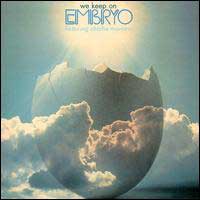 Jetzt nicht wundern, aber in den frühen 70ern hat sich auch dieser
Chemiegigant aus Ludwigshafen mal für ein paar Jahre als Plattenfirma
versucht! Vielleicht um den eigenen Vinylabsatz zu erhöhen? Oder
weil man sich sagte: "Wir können Vinyl machen, also sind
wir ja auch eine Plattenfirma!"? Keine Ahnung - ist ja auch egal.
Auf jeden Fall gab es damals zum Teil recht obskures Zeug aus Ludwigshafen:
ich erinnere mich an das inzwischen ultra rare, aber nicht unbedingt gelungene
Debütalbum von Conny Veits Band Gila, außerdem hatte
man das Stuttgarter Jazzlabel MPS von Joachim-Ernst Behrend
im Vertrieb. Aber ich schweife ab! Auch die deutschen "Ethno-Jazz-Rocker"
Embryo haben dort mal veröffentlicht. Zwar hab ich "We Keep
On" damals nicht gehört (ich besaß nur 2 Billig-Kompilationen
vom Brain-Label), aber es jetzt als CD-Wiederveröffentlichung
von einem Plattenlabel aus Andorra (!) neu für mich entdeckt.
Jetzt nicht wundern, aber in den frühen 70ern hat sich auch dieser
Chemiegigant aus Ludwigshafen mal für ein paar Jahre als Plattenfirma
versucht! Vielleicht um den eigenen Vinylabsatz zu erhöhen? Oder
weil man sich sagte: "Wir können Vinyl machen, also sind
wir ja auch eine Plattenfirma!"? Keine Ahnung - ist ja auch egal.
Auf jeden Fall gab es damals zum Teil recht obskures Zeug aus Ludwigshafen:
ich erinnere mich an das inzwischen ultra rare, aber nicht unbedingt gelungene
Debütalbum von Conny Veits Band Gila, außerdem hatte
man das Stuttgarter Jazzlabel MPS von Joachim-Ernst Behrend
im Vertrieb. Aber ich schweife ab! Auch die deutschen "Ethno-Jazz-Rocker"
Embryo haben dort mal veröffentlicht. Zwar hab ich "We Keep
On" damals nicht gehört (ich besaß nur 2 Billig-Kompilationen
vom Brain-Label), aber es jetzt als CD-Wiederveröffentlichung
von einem Plattenlabel aus Andorra (!) neu für mich entdeckt.
Wie bei einer "richtigen Jazzplatte" sollte man hier Aufnahmezeitpunkt
(Dez. 1972) und Besetzung erwähnen: neben Bandgründer und einzigem
Dauermitglied Christian Burchard (Schlagzeug, Vibraphon) sind das
Langzeitgitarrist Roman Bunka, Keyboarder Dieter Miekautsch
und der damals in Deutschland beheimatete Saxofonist Charlie Mariano.
Da alle damaligen Embryoplatten eine hohe musikalische Qualität hatten,
ist der "internationale Durchbruch" , den die Band angeblich
mit diesem Album schaffte, sicherlich auf dieses prominente (Teilzeit-)Bandmitglied
zurückzuführen. Guter Hippie-Kiffer-Jazzrock!
(24.06.2004)

 Mehr ...
Mehr ...
|
We Keep On is the German art/jazz rock band Embryo's most successful
recording. It's also one of their best. In late 1972, saxophonist Charlie
Mariano joined Embryo along with guitarist Roman Bunka. Mariano's already
encyclopedic knowledge of world music forms was a welcome addition to
the band; they sought to fuse jazz and space rock -- à la their
countrymen Can -- with the various rhythms and harmonic sensibilities
of folk musics across the globe. Bunka also played the Turkish saz and
was a great, if unconventional, vocalist. Embryo's leader, Christian Burchard,
took up everything from drums to marimba to Mellotron on this set to complement
pianist Dieter Miekautsch's Rhodes and clavinet work. And Mariano played
not only sax and flute but nagasuram and bamboo flutes as well. Here,
on "Ehna, Ehna, Abu Lele," West African rhythms danced with
jazz rock and wove something entirely new from the roots of both. On "Hackbrett-Dance,"
saz, marimba, and percussion became something out of time and space that
might have come from any North African nation, but found a place in the
tripped-out world of psychedelic space music as well -- check the recordings
of Angus MacLise for a frame of reference here. But it is on the Miles-influenced
jazz-funk of "No Place to Go," which used the Jack Johnson groove
to achieve new rock ecstasies, that the album really comes into view for
its revolutionary contribution to the language of assimilation. The CD
version also contains two welcome bonus tracks from the session, a nearly
16-minute "Ticket to India" and an eight-and-a-half-minute extended
improv called "Flute, Saz and Marimba" that could have come
from one of Don Cherry's early-'70s recordings. Highly recommended.
(by Thom Jurek, All
Music Guide)
|
|
| Gong: "Angels Egg" (Virgin, Dez. 1973) |
 Teil 2 von "The Radio Gnome Invisible Trilogy".
Teil 2 von "The Radio Gnome Invisible Trilogy".

 Mehr ...
Mehr ...
|
The companion piece to The Flying Teapot, Angel's Egg is not your usual
progressive rock album. Very quirky, with many, mostly brief compositions,
the album is a tad less spacy than Teapot, with just a few psychedelic-inspired
lyrics, and it's very technically adept. Angel's Egg opens with a true
space rock cut (one of the few on the album), filled with the usual Smyth
space whispering and Allen voicings, then leads into the cleverly titled
"Sold to the Highest Buddha," with Hillage and Malherbe prominent
figures. The instrumental "Castle in the Clouds" finds Hillage
coming into his own, with a sound identical to his solo work. "Givin'
My Love to You" sounds like a bar song, with no music and a cluster
of seemingly drunken fellas trying to sing. The instrumental "Flute
Salad" gives way to "Oily Way," a showcase for Malherbe's
jazzy flute. "Inner Temple," an instrumental space rock track,
moves along with a jazz edge, provided by Didier's sax. The final three
tracks are the real highlights on Angel's Egg. "I Never Glid Before"
is a fantastic prog-rock tune, replete with blistering Hillage solo, primo
Allen lyrics and vocal, and the precise percussion of new bandmember Pierre
Moerlen. This eclectic composition travels through several movements and
time changes, and comes across as a perpetually progressing piece. The
imaginative and jazzy "Eat That Phone Book Coda" brings the
album to a close.
(by David Ross Smith, All
Music Guide)
|
|
| Gary Burton & Chick Corea: "Crystal Silence" (ECM, 1973) |
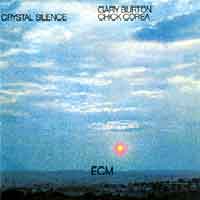 Die Platte klingt so, wie sie heißt: wunderbare Piano-Vibraphon-Duette von zwei Meistern.
Die Platte klingt so, wie sie heißt: wunderbare Piano-Vibraphon-Duette von zwei Meistern.

 Mehr ...
Mehr ...
|
Dieses Album der Pianisten Chick Corea und des Vibraphonisten Gary Burton
aus dem Jahr 1972 trug dazu bei, die Verbindung von moderner Kammermusik
und Jazz zu etablieren. Dank Coreas Wandlungsfähigkeit gehen Jazz-,
Folk- und Latin-Formen entspannt und nahtlos in klassische Komplexität
und Strenge über. In Burton findet er sein ideales Gegenüber.
Besonders bei "Señor Mouse" und "What Game Shall
We Play Today" wirken die beiden, als wäre ein Musiker an einem
einzigen, herrlich in sich vermischtem und akzentuiertem Instrument am
Werk. Corea steigt mit metallenem, eigenständig kristallinem Ton
und behutsamer Modulation in Höhen empor, und tollt dort herum, ohne
in die Banalität zurückzufallen. Burton agiert mit seiner außergewöhnlichen
Technik an vier Schlegeln zugleich musikalisch unmittelbar und herausragend.
Die Timbres und Klänge von Klavier und Vibraphon sind komplementär,
ebenso wie die freundschaftlichen Gemeinsamkeiten zweier unübertrefflicher
Musiker.
(Peter Monaghan, amazon)
|
|
|
Endlich gibt's den Klassiker auf CD. Jazz-Puristen lächeln zwar
über die dahinplätschernden Klänge des Duos - na und? Wie
Vibraphonist und Pianist die Kühle und Wärme ihrer Instrumente
kombinieren, wie sie ihre Soli gegenseitig untermalen, wie ihre Themen
ausschwingen, degradiert jegliches New Age.
© Audio
|
|
|
For Crystal Silence, the first of several partnerships between Chick Corea and vibraphonist Gary Burton in the 1970s, the two musicians selected an interesting array of material. The compositions on this record are all modern ones, either by Steve Swallow, Mike Gibbs, or Corea himself. It is a mostly down-tempo affair, which allows each player to stretch out and play highly melodic solos over the often difficult changes. In keeping with most ECM releases, there is a distinct presence of European elements to the improvisations. There are few overt blues or bebop phrases, Corea and Burton opting instead for modern melodies to fuel their improvisations. Burton has managed to internalize the Spanish and modal implications of Corea's tunes with little difficulty, and solos with joyful ease through such tracks as "Señor Mouse." Corea himself is absolutely burning. His solo contribution on the same track is both fiery and introspective, combining in one statement the poles for which he is best-known. The title track is also the centerpiece of the album, a nine-minute exploration of the Corea ballad that first appeared on his Return to Forever record in 1972. In keeping with the tradition of the great masters of the ballad form, time seems to disappear as Burton and Corea lovingly caress the song's simple melody and dance effortlessly around the chords, building intensity only to let it subside once more. Crystal Silence is a sublime indication of what two master improvisers can do given quality raw material, with the first side of this record being particularly flawless. Improvised music is rarely this coherent and melodic. Essential for fans of Corea, Burton, or jazz in general.
(Daniel Gioffre, All Music Guide)
|
|
| Commander Cody & His Lost Planet Airmen: "Country Casanova" (MCA/Paramount, 1973) |
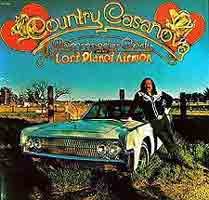 Auch auf ihrem dritten Album brachte diese achtköpfige Hippietruppe wieder
ihre ungewöhnliche Mischung aus Swing, Country und Rock'n'Roll. Wie
immer gab es ein tolles Cover!
Auch auf ihrem dritten Album brachte diese achtköpfige Hippietruppe wieder
ihre ungewöhnliche Mischung aus Swing, Country und Rock'n'Roll. Wie
immer gab es ein tolles Cover! |
| Country Gazette: "Don't Give Up Your Day Job" (United Artists, 1973) |
 Ein Wühltischentdeckung! Dieses Quartett, entstanden aus den Resten von
"Dillard & Clark",
stand für hochkarätigen Bluegrass kalifornischer Prägung,
also durchaus mit offenen Ohren für Rock und Pop, was sich auch in
der Songauswahl widerspiegelt: Lieder von Stephen Stills, Don McLean,
Elton John (der schrieb damals tatsächlich schöne Lieder!),
aber eben auch vom Meister Bill Monroe. Bekanntestes Bandmitglied dürfte
der Geiger Byron Berline gewesen sein, neben Banjospieler Alan
Munde, Bassist Roger Bush und Gitarrist Kenny Wertz.
Ein Wühltischentdeckung! Dieses Quartett, entstanden aus den Resten von
"Dillard & Clark",
stand für hochkarätigen Bluegrass kalifornischer Prägung,
also durchaus mit offenen Ohren für Rock und Pop, was sich auch in
der Songauswahl widerspiegelt: Lieder von Stephen Stills, Don McLean,
Elton John (der schrieb damals tatsächlich schöne Lieder!),
aber eben auch vom Meister Bill Monroe. Bekanntestes Bandmitglied dürfte
der Geiger Byron Berline gewesen sein, neben Banjospieler Alan
Munde, Bassist Roger Bush und Gitarrist Kenny Wertz. |
| Dobie Gray: "Drift Away" (MCA, 1973) |
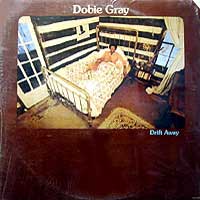 Schlimm genug, dass man das extra erwähnen muss: es gibt schwarze
Sänger, die sich sehr kompetent an Countrymusik (i.w.S.) versuchen.
Neben Ray Charles und Charlie Pride muss da unbedingt der
Texaner Dobie Gray genannt werden, der mit dem Titelsong, komponiert
von seinem Produzenten Mentor Williams, einen Welthit landet, der
viel gecovert wurde, u. a. von Humble
Pie und - so weit ich weiß - auch von den Rolling Stones.
Irgendwo habe ich auch mal gelesen, dass mit "Drift Away" eine
der ersten "Americana"-Platten aufgenommen wurde. Ob man diese
Album jetzt tatsächlich so hoch hängen muss, bleibt mal dahingestellt
- Außerdem scheinen die Unterschiede zwischen Country und Soul im
Süden der USA dann doch nicht so gross zu sein, wenn man etwa an
solche Sänger und Songschreiber wie Tony
Joe White, Eddie Hinton und
Donnie Fritts denkt (von dem hier
die wunderbare Ballade "We Had It All" gecovert wird).
Schlimm genug, dass man das extra erwähnen muss: es gibt schwarze
Sänger, die sich sehr kompetent an Countrymusik (i.w.S.) versuchen.
Neben Ray Charles und Charlie Pride muss da unbedingt der
Texaner Dobie Gray genannt werden, der mit dem Titelsong, komponiert
von seinem Produzenten Mentor Williams, einen Welthit landet, der
viel gecovert wurde, u. a. von Humble
Pie und - so weit ich weiß - auch von den Rolling Stones.
Irgendwo habe ich auch mal gelesen, dass mit "Drift Away" eine
der ersten "Americana"-Platten aufgenommen wurde. Ob man diese
Album jetzt tatsächlich so hoch hängen muss, bleibt mal dahingestellt
- Außerdem scheinen die Unterschiede zwischen Country und Soul im
Süden der USA dann doch nicht so gross zu sein, wenn man etwa an
solche Sänger und Songschreiber wie Tony
Joe White, Eddie Hinton und
Donnie Fritts denkt (von dem hier
die wunderbare Ballade "We Had It All" gecovert wird).
Begleitet wird Dobie Gray von der Créme de la Créme der
Nashville-Musikszene: David Briggs (keyb), Mike Leech (bg),
Reggie Young (g), Troy Seals (g), Kenny Buttrey (dr)
und Weldon Myrick (pedal steel). Es ist wohl kaum überraschend
, dass Briggs, Malone und Young auch bei Ton Joe
Whites aktuellem Album zu hören sind!
(11.04.2006)

 Mehr ...
Mehr ...
|
"Drift Away" may have been the best of single of its year,
but the supporting album doesn't quite meet that standard. Drift Away's
other tracks are pleasant enough, with Dobie Gray's mellow yet soulful
voice stealing the show. The sound is laid back L.A. rock scattered with
steel guitars and the occasional fiddle - an odd combination that works
on the better cuts like "L.A. Lady" and "Now That I'm Without
You." The fine ballads "We Had It All" and "Sweet
Lovin' Woman" round out this solid if unspectacular album.
(by J.P. Ollio, AMG)
|
|
| Some six years before Dobie Gray [nee: Lawrence Darrow
Brown] laid down his debut long-player Drift Away (1972), the vocalist had
established himself as a seemingly 'one-hit wonder' with "The 'In' Crowd,"
scoring additional attention with "See You at the 'Go-Go'" and "Out on the
Floor." While the latter pair barely made an impact on the charts Stateside,
both were considered classics throughout Europe -- especially among fans
within the U.K.'s Northern Soul community. Gray additionally tried his hand
at acting, resulting in participation in the Los Angeles cast of Hair and
as becoming a member of a jazz-rock outfit called Pollution. A fortuitous
collaborative partnership with Mentor Williams -- brother of noted composer/musician/actor
Paul Williams -- led to a deal with Decca/MCA and ultimately to a Mentor
Williams' tune that would become Gray's signature, "Drift Away," which also
soared into the Top Five of the Pop survey in March of 1973, giving Decca
their final Gold single prior to the label's collapse into their MCA Records
parent company. The entire effort reflects the same insouciant vibe of the
familiar title track with Gray's Nashville-based backing band featuring
Williams (guitar), Mike Leech (bass), Reggie Young (guitar), Troy Seals
(guitar), David Briggs (keyboards) and Kenny Malone (drums) with Weldon
Myrick (pedal steel guitar) and Buddy Spicher (fiddle) augmenting the lineup.
Williams, Seals and Jennings provide a wide array of material, ranging from
the driving "The Time I Loved You the Most," "Rockin' Chair" and the swampified
funk-blues of "Lay Back" to the stunningly poignant acoustic ballad "We
Had It All." "Sweet Lovin' Woman" is another refined love song with a slightly
countrified lilt that is perfectly matched to Gray's sensual expressiveness,
clearly pointing in the direction that Gray's subsequent endeavors would
take. In 2004, a remastered version of Drift Away was included along with
the other half-dozen LPs Gray recorded during the 1970s on Hip-O Select's
four-disc The Complete Dobie Gray (1969-1979) box set.
(by Lindsay Planer, All
Music Guide)
|
| |
|
| "Gryphon" (Transatlantic, 1973) |
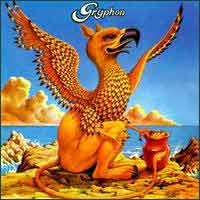 Gryphon waren eine sehr obskure Gruppe. Auf ihrer ersten Veröffentlichung
spielten sie in der Besetzung Richard Harvey (Blockflöte,
Keyboards), Brian Gulland (Fagott), Graeme Taylor (Gitarre)
und David Oberle (Perkussion) eine sehr von Klassik (bzw. Barock)
und Folk geprägte, aber eigenständige (meist) instrumentale
Musik, in der vor allem der virtuose Blockflötenspieler herausragte.
Es sollten bis 1977 noch 4 weitere Alben folgen, in der sich die Musik
hin zu so etwas wie "Progrock" entwickelte.
Gryphon waren eine sehr obskure Gruppe. Auf ihrer ersten Veröffentlichung
spielten sie in der Besetzung Richard Harvey (Blockflöte,
Keyboards), Brian Gulland (Fagott), Graeme Taylor (Gitarre)
und David Oberle (Perkussion) eine sehr von Klassik (bzw. Barock)
und Folk geprägte, aber eigenständige (meist) instrumentale
Musik, in der vor allem der virtuose Blockflötenspieler herausragte.
Es sollten bis 1977 noch 4 weitere Alben folgen, in der sich die Musik
hin zu so etwas wie "Progrock" entwickelte.

 Mehr ...
Mehr ...
The group's debut album. They were still a quartet at the time, without a full-time keyboard player. The material is essentially progressive folk-rock, elements of jazz and swing ("Over the Rainbow" even turns up interpolated in the arrangement of one number) juxtaposed with traditional folk songs ("The Unquiet Grave," ka "Dives and Lazarus"), works attributed to Henry VIII, and folk-style originals. Brian Gulland's and Richard Harvey's bassoon, krumhorn, and recorders are the dominant instruments. The instrumental tracks tend to overwhelm the tiny handful of vocal numbers, sung by Gulland, guitarist Graeme Taylor, and drummer David Oberle.
(by Bruce Eder, All Music Guide)
Gryphon was one of the more unusual of the folk-rock groups to come out of England in the 1970s, mostly because they didn't confine their musical genre-melding to folk-rock. Spawned at the Royal College of Music, they started out making a name for themselves in folk-rock, but their classical training and their approach to composition, recording, and performance soon took them into the much bigger field of progressive rock, and eventually had them playing gigs in front of arena-size audiences. Gryphon followed up this first release with Gryphon to Red Queen Three and Midnight Mushrumps, which are both available on the Talking Elephant label. As their reputation grew so did the sales and they became one of the foremost bands in the early to mid seventies in the cult area of medieval folk-rock. With the classical and progressive influences in their music along with the folk structure Gryphon appeal to a wide range of audience. This first album has not been available for nearly ten years and will be sought after by many fans across the musical spectrum.
(talkingelephant.co.uk)
|
| Claire Hamill: "October" (Island, 1973) |
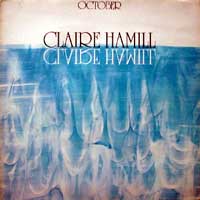 Bei den Aufnahmen zu ihrem zweiten und letzten Album für Islands
war Claire Hamill gerade erst 18 geworden. Paul Samwell-Smith (Ex-Yardbirds-Bassist
und Cat Stevens-Erfolgsproduzent) sorgte für einen Folksound, der
etwas kompakter daherkommt als auf dem Debüt "One
House Left Standing" von 1971. Nur der Bluesrocker "You
Got Me Running" von Jimmy Reed will für mich hier irgendwie
nicht hineinpassen. Nach Ende iher erstenSolo-Karriere, Ende der 70er,
Anfang der 80er, soll Claire mal bei Wishbone Ash mitgewirkt haben.
Danach wechselte sie in New-Age-Fach.
Bei den Aufnahmen zu ihrem zweiten und letzten Album für Islands
war Claire Hamill gerade erst 18 geworden. Paul Samwell-Smith (Ex-Yardbirds-Bassist
und Cat Stevens-Erfolgsproduzent) sorgte für einen Folksound, der
etwas kompakter daherkommt als auf dem Debüt "One
House Left Standing" von 1971. Nur der Bluesrocker "You
Got Me Running" von Jimmy Reed will für mich hier irgendwie
nicht hineinpassen. Nach Ende iher erstenSolo-Karriere, Ende der 70er,
Anfang der 80er, soll Claire mal bei Wishbone Ash mitgewirkt haben.
Danach wechselte sie in New-Age-Fach.
(22.04.2010)

 Mehr ...
Mehr ...
The ferociously talented Claire Hamill charmed her way onto Island Records, although initially label head Chris Blackwell was a bit put off by her tender age. But the 16-year-old with the crystalline voice and powerful pen was determined, Blackwell relented and ended up co-producing her 1971 debut album alongside her manager John McCoy. The bulk of the ten-song set was composed by either Hamill herself or co-written with her then boyfriend Mike Coles. Invariably romantic themes predominated, so did songs about growing up, as did thoughtful, introspective numbers, with a pair showcasing the artist's youthful sense of fun. But how to market this ferocious talent? As a singer/songwriter? as a folkie? or as a soft-rocker? McCoy and Blackwell never did decide and brought in a group of top-notch musicians to create a set that encompassed all angles. The cutesy "Baseball Blues" that opened the One House Left Standing set Hamill up as the British Melanie; oddly, though, it wasn't chosen as the single, instead Blackwell opted for the searching "When I Was a Child." The powerful "Alice in the Streets of Darlington" featured on the flipside, and is one of two bonus tracks included on the Esoteric reissue. Neither were particularly representative of the album, which leaned in a somewhat folkier direction. The comic book horror of "Flowers for Grandma" is presented as a medieval ballad, the affecting "The Man Who Cannot See Tomorrows Sunshine" is more pastoral, "Consummation" features a lovely Western tinge, while "Smile Your Blues Away" dances into a banjo-led, knees-up hoedown. But musically, the album's sole cover, Joni Mitchell's "Urge for Going," is the most astonishing, an epic seven-minute track that slides from folk into psychedelia and out into prog. There are also more lavish numbers, lush with strings and classical piano. The entire set is carefully crafted, deftly arranged, and beautifully played, while Hamill shines throughout. The only complaint one can make is that she tries too much. Intent on perfectly hitting every note, concentrating on her emotive vibrato, working hard on her enunciation, Hamill never relaxes a muscle, giving the entire set a rather brittle and forced feel. The difference is crystal clear when you hear her electric performance on the reissue's other bonus track, "Meet Me on the Corner," where she let down her hair with Stealers Wheel. Now if only she could have brought that sense of excitement to the actual album. Notwithstanding, this is a phenomenal set beautifully showcasing one of Britain's most astonishing talents.
(by Jo-Ann Greene, All Music Guide)
|
| Heads Hands & Feet: "Old Soldiers Never Die" (Atco, 1973) |
 Der Schwanengesang einer der besten britischen Bands der frühen 70er. Das wollte damals
kaum jemand hören. Sänger Tony Colton konzentrierte sich
fortan wieder auf seine Tätigkeit als Produzent (er hat auch alle
drei HHF-Alben vorzüglich in Szene gesetzt!), Bassist Chas Hodges
wechselte zum Klavier und wurde eine englische Pubrock-Semi-Legende im
Duo Chas & Dave (mit Dave Peacock). Nur den Leadgitarristen,
Keyboarder und zweiten Leadsänger Albert Lee wird der eine
oder andere von Euch durch sein späteres Mitwirken u.a. bei Emmylou
Harris, Eric Clapton, u.v.a., sowie durch gelegentliche Soloalben
kennen.
Der Schwanengesang einer der besten britischen Bands der frühen 70er. Das wollte damals
kaum jemand hören. Sänger Tony Colton konzentrierte sich
fortan wieder auf seine Tätigkeit als Produzent (er hat auch alle
drei HHF-Alben vorzüglich in Szene gesetzt!), Bassist Chas Hodges
wechselte zum Klavier und wurde eine englische Pubrock-Semi-Legende im
Duo Chas & Dave (mit Dave Peacock). Nur den Leadgitarristen,
Keyboarder und zweiten Leadsänger Albert Lee wird der eine
oder andere von Euch durch sein späteres Mitwirken u.a. bei Emmylou
Harris, Eric Clapton, u.v.a., sowie durch gelegentliche Soloalben
kennen.
(31.12.2007) |
| Garland Jeffreys (Atlantic, 1973) |
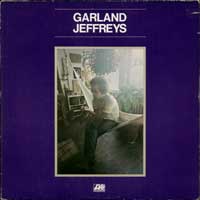 Das völlig unbekannte und titellose Debütalbum des New Yorker Singer/Songwriters,
der in seiner Heimat weitestgehend unbekannt, in Europa zumindest einem
kleineren Publikum bekannt ist: da gab's mal mit "Matador" einen
kleineren Hit und ein paar Fernsehauftritte, woher ich den Mann dann ja
auch kannte. 1973 gab's aber noch keinen "Matador" und dieser
erste Versuch, Singer/Songwriter-Musik mit Reggae zu mischen, war kommerziell
gesehen ein Fehlgriff. Dabei hatte Atlantic sogar die Produzentenlegende
Michael Cuscuna und die besten Studiocracks der Stadt finanziert
(u. a. Saitenzauberer David Bromberg, Dr. John, Jazzbassist Richard
Davis, Vibraphonist Mike Manieri, Saxofonist David "Fathead"
Newman, den Gospelchor The Persuasion, Bassist Chuck Rainey
und Drummer Bernard Purdie), ließ ihn danach aber wieder
fallen. Nach meinem Wissensstand gibt es die Platte auch immer noch nicht
auf CD, sodass ich mir jetzt erstmal eine CDR von meiner alten und schon
ein wenig zerkratzten Vinylplatte gemacht habe, die ich mal Ende der 70er/Anfang
der 80er für lächerliche 3,30 DM aus einer Grabbelkiste gezogen
habe. Erst jetzt weiß ich die Qualität dieser Aufnahmen richtig
zu schätzen!
Das völlig unbekannte und titellose Debütalbum des New Yorker Singer/Songwriters,
der in seiner Heimat weitestgehend unbekannt, in Europa zumindest einem
kleineren Publikum bekannt ist: da gab's mal mit "Matador" einen
kleineren Hit und ein paar Fernsehauftritte, woher ich den Mann dann ja
auch kannte. 1973 gab's aber noch keinen "Matador" und dieser
erste Versuch, Singer/Songwriter-Musik mit Reggae zu mischen, war kommerziell
gesehen ein Fehlgriff. Dabei hatte Atlantic sogar die Produzentenlegende
Michael Cuscuna und die besten Studiocracks der Stadt finanziert
(u. a. Saitenzauberer David Bromberg, Dr. John, Jazzbassist Richard
Davis, Vibraphonist Mike Manieri, Saxofonist David "Fathead"
Newman, den Gospelchor The Persuasion, Bassist Chuck Rainey
und Drummer Bernard Purdie), ließ ihn danach aber wieder
fallen. Nach meinem Wissensstand gibt es die Platte auch immer noch nicht
auf CD, sodass ich mir jetzt erstmal eine CDR von meiner alten und schon
ein wenig zerkratzten Vinylplatte gemacht habe, die ich mal Ende der 70er/Anfang
der 80er für lächerliche 3,30 DM aus einer Grabbelkiste gezogen
habe. Erst jetzt weiß ich die Qualität dieser Aufnahmen richtig
zu schätzen!
(18.02.2006) |
| Antonio Carlos Jobim: "Jobim" (Verve, 1973) |
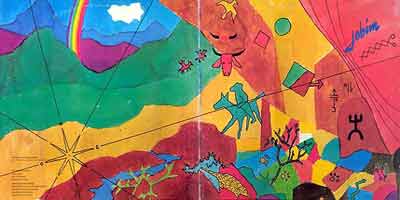 Warnung: die Platte ist mit einem Orchester aufgenommen! Sehr viele Geigen. Also
nix für harte Rock'n'Roller. Eher für Freunde schöner Melodien.
Und die gibt's bei Tom Jobim, einem der besten Songschreiber populärer
Musik, den es je gab (no kidding!), natürlich én masse!
Warnung: die Platte ist mit einem Orchester aufgenommen! Sehr viele Geigen. Also
nix für harte Rock'n'Roller. Eher für Freunde schöner Melodien.
Und die gibt's bei Tom Jobim, einem der besten Songschreiber populärer
Musik, den es je gab (no kidding!), natürlich én masse!
|
| Lava: "Tears Are Goin' Home" (Brain, 1973 ) |
 Lost & Found!
Lost & Found!
(15.07.2008)

 Mehr ...
Mehr ...
|
Led by German keyboard player Thomas Karrenbach's conservative playing style, Lava's first and only album failed to make it beyond the underground progressive scene, but its ingredients included many elements that were just as solid as the music coming from the more prominent groups at the time. The crux of Tears Are Goin' Home is built on a blues-rock sound, with instruments like the harmonica, conga, and bongo drums attaching themselves to the mainframe. What results is some straightforward progressive rock with fuzzy, distorted guitar tones pulling in Jurgen Kraaz's flute and organ accompaniment. With the opening track's blues sound resembling the Groundhogs in many places, the following cut, entitled "Crimes of Love," embarks on a kinder, gentler melody that mirrors the average rock ballad. Beyond the first two songs, the music begins to cultivate a distinct feel, with the mouth harp's cordial twang creating a countrified sound on "Would Be Better You Run" and the acoustic guitar dominating the momentum of "Holy Fool." The full ten minutes of "Piece of Peace" is an excellent coda, as the band spills prominent examples of each of their talents into one long finale. While there are minimal amounts of organ and piano interplay, Lava's sound is located mainly in the string work and in the singing, making this lone release a meritorious effort despite the band's unpromising future.
(by Mike DeGagne, All Music Guide)
|
|
|
Bonjour,
ich war um 1970 Regieassistent am Forum-Theater, Berlin, und habe Thomas Karrenbach und die "Lava"-Gruppe gut gekannt. Beim Klicken durch die "Lava"-Seiten im Internet bin ich nun überall auf Irrtümer gestoßen. Hier also, zur freien Weiterverbreitung, einige Klarstellungen und ergänzende Informationen:
Thomas Karrenbach war in erster Linie weder Sänger noch Keyboarder, sondern (wie auch Stefan Ostertag) Schauspieler am (von Klaus Hoser geleiteten) Forum-Theater, Berlin (größter Erfolg in "Und sie legten den Blumen Handschellen an"); er ist 1974 im Alter von 27 Jahren in Berlin an Magenkrebs gestorben.
Die Lava-Gruppe hat weder als Kollektiv noch als Kommune dauerhaft zusammengelebt. Man traf sich hin und wieder in der Kreuzberger Kellerwohnung von Brigitte und Edwin Wengoborski (Bühnenmeister am Forum-Theater) oder in der Villa, in Lichterfelde, der Filmproduktionsleiterin Regina Otto-Gundelach (u.a. 1971: "Liebe Mutter, mir geht es gut").
Bei diesen Treffen, die oft bis zu 10 Stunden dauerten und zu denen manchmal über 30 Leute kamen, wurde nicht nur kräftig gekifft (später auch freihändig eingeworfen, gesnifft und gespritzt), sondern auch "Musik" gemacht: Trommeln, Flöten, Gitarren, Spielen auf einem indischen Knieharmonium mit handbetriebenem Blasebalg; dazu wurde auch vokalisiert. Keiner beherrschte ein Musikinstrument: das war alles drogengestütztes Gewaber.
Aus diesen Sessions entstand das Lava-Album "Tears are Going Home". Die graphische Gestaltung der Hülle stammt von Brigitte Wengoborski.
Da diese Platte nicht den von den Beteiligten erwarteten weltweiten Sensationserfolg hatte, brach die Gruppe 1974 nach dem Tod von Thomas Karrenbach auseinander; es kam zu einigen Drogentoten aus ihrem Umkreis, darunter war auch die ehemalige Freundin von Thomas.
Weitere Informationen können sicherlich bei Edwin Wengoborski, Klaus Hoser, Christian Rateuke, Anke Oehme und Regina Otto-Gundelach eingeholt werden.
Alles in allem betrachte ich heute diese Lava-Zeit als ein eher trauriges Kapitel meiner Berliner Vergangenheit. Nach dem Auseinanderlaufen der Gruppe habe ich studiert und lebe seit nunmehr 20 Jahren in Frankreich.
Bien à vous,
Eckart Birnstiel
|
|
| Les McCann"Layers" (Atlantic, 1973) |


 Mehr ...
Mehr ...
|
rec. 11/72 rel. 1/74
by Steve Huey
This groundbreaking jazz synthesizer record is really unlike any other
Les McCann ever made. Aside from a three-man percussion section and electric
bassist Jimmy Rowser, Layers is entirely electronic, one of the first
jazz albums with such an emphasis. According to the liner notes, McCann's
ambition was to be the entire orchestra he heard in his head, and to that
end the record explores the sonic possibilities of the new ARP synthesizer
in great detail, though McCann also overdubs himself on electric piano
in spots. The variety of tones on the ARP gives McCann a lot to play with,
and he mimics woodwinds, horns, strings, slapped bass, and even the intonations
of human speech. McCann's kaleidoscopic array of tonal colors and contrasts
gives the album a rich, full sound, as does the recording process -- Layers
was the first album ever to be recorded in 32-track format. But what really
gives Layers its surprisingly warm, human dimension is how emotionally
engaged McCann sounds. He laid most of his parts down in only one take,
and allowed different sections to flow directly into one another, producing
two side-long continuous suites. The resulting stream-of-consciousness
feel -- not to mention the near-one-man format -- seems to free up McCann's
sense of personal expression; there's a pronounced mood of reflection
and nostalgia on the slower, spacier pieces, and on the funkier groove
numbers, McCann works his new instrument like a kid in a candy shop. It's
true that in some places, Layers is more about texture than theme development,
so traditional jazz fans likely won't find it much more than a curiosity.
In truth, it's pretty avant-garde -- not in its sound (we're not talking
Sun Ra's Atlantis), but certainly in its sensibility; this music is truly
forward-looking and ahead of its time.
|
|
| "Marshall Tucker Band" (Capricorn, 1973) |
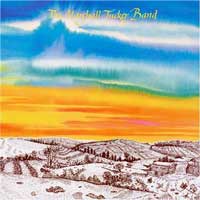 Lost And Found!
Lost And Found!
(23.11.2003)
|
| John Prine: "Sweet Revenge" (Atlantic, 1973) |
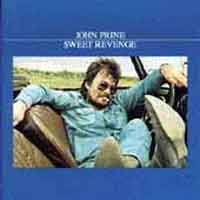 Bereits das dritte tolle Album des Mannes, der uns allen den "Angel From
Montgomery" brachte. Wie immer dabei als Gitarrist Steve Goodman,
selber ein vorzüglicher Songschreiber ("City Of New Orleans"),
dieses mal unterstützt von der vorzüglichen Nashville-Mafia
(Reggie Young, David Briggs, Kenny Malone, Grady
Martin, u.a.) , als Produzent wie immer dabei Atlantic-Legende Arif
Mardin.
Bereits das dritte tolle Album des Mannes, der uns allen den "Angel From
Montgomery" brachte. Wie immer dabei als Gitarrist Steve Goodman,
selber ein vorzüglicher Songschreiber ("City Of New Orleans"),
dieses mal unterstützt von der vorzüglichen Nashville-Mafia
(Reggie Young, David Briggs, Kenny Malone, Grady
Martin, u.a.) , als Produzent wie immer dabei Atlantic-Legende Arif
Mardin. |
| Willie Nelson: "Shotgun Willie" (Atlantic, 1973) |
 Das erste Album, mit dem sich Nelson nach seiner Rückkehr nach Texas
als sog. "Outlaw" einen Namen machen konnte, allerdings nur
ein kurzes Zwischenspiel beim Atlantic-Label, wohl nicht der ideale Ort
für Countrymusik, sei sie auch noch so sehr "outlaw", bevor
er dann bei Columbia mit "Red Headed
Stranger" voll durchstartete.
Das erste Album, mit dem sich Nelson nach seiner Rückkehr nach Texas
als sog. "Outlaw" einen Namen machen konnte, allerdings nur
ein kurzes Zwischenspiel beim Atlantic-Label, wohl nicht der ideale Ort
für Countrymusik, sei sie auch noch so sehr "outlaw", bevor
er dann bei Columbia mit "Red Headed
Stranger" voll durchstartete.
U.a. mit "She's Not For You" und "Whiskey River". |
| Danny O'Keefe: "Breezy Stories" (Atlantic, 1973) |
 Ein schreckliches Cover, aber eines der besten Alben eines der unterbewertetsten
amerikanischen Singer/Songwriter. Dieses mal wurde in New York mit absoluten
Topmusikern aufgenommen: u.a. Dr. John und Donny Hathaway
am Piano, den Gitarristen Hugh McCracken und David Bromberg,
den Schlagzeugern Bernard Purdie und Steve Mosley, den Bassisten
Richard Davis, Kenny Edwards und Hugh McDonald, Perkussionist
Airto Moreira, den Bluegrassspezialisten Kenny Kosek (Fiedel)
und Andy Statman (Mandoline). Produziert wie beim Vorgängeralbum
"O'Keefe" vom legendären Arif Mardin. Trotzdem liess
sich der Erfolg von "Good Time Charlie Got The Blues" nicht
wiederholen.
Ein schreckliches Cover, aber eines der besten Alben eines der unterbewertetsten
amerikanischen Singer/Songwriter. Dieses mal wurde in New York mit absoluten
Topmusikern aufgenommen: u.a. Dr. John und Donny Hathaway
am Piano, den Gitarristen Hugh McCracken und David Bromberg,
den Schlagzeugern Bernard Purdie und Steve Mosley, den Bassisten
Richard Davis, Kenny Edwards und Hugh McDonald, Perkussionist
Airto Moreira, den Bluegrassspezialisten Kenny Kosek (Fiedel)
und Andy Statman (Mandoline). Produziert wie beim Vorgängeralbum
"O'Keefe" vom legendären Arif Mardin. Trotzdem liess
sich der Erfolg von "Good Time Charlie Got The Blues" nicht
wiederholen. |
| Oregon: "Distant Hills" (Vanguard, 1973) |
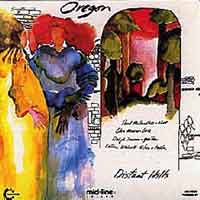 Oregon, die auch heute noch aktiv sind, spielen eine unvergleichliche Musik. Hier
finden Jazz, E-Musik, Weltmusik und was weiß ich noch alles (Europa,
Indien, USA) zu etwas Neuem zusammen. Man kann sich dieser Musik am ehesten
mit der Vorstellung der 4 absolut gleichberechtigten Musiker mit ihrem
jeweiligen Instrumenten nähern. Gleicher unter gleichen ist vielleicht
Ralph Towner (Ak. Gitarre, Piano, Trompete). Collin Walcott
spielt Perkussion und indische Instrumente (Sitar, Tablas). Glenn Moore
bedient den Kontrabass (und gelegentlich Piano und Flöte). Paul
McCandless spielt Oboe und Bassklarinette.
Oregon, die auch heute noch aktiv sind, spielen eine unvergleichliche Musik. Hier
finden Jazz, E-Musik, Weltmusik und was weiß ich noch alles (Europa,
Indien, USA) zu etwas Neuem zusammen. Man kann sich dieser Musik am ehesten
mit der Vorstellung der 4 absolut gleichberechtigten Musiker mit ihrem
jeweiligen Instrumenten nähern. Gleicher unter gleichen ist vielleicht
Ralph Towner (Ak. Gitarre, Piano, Trompete). Collin Walcott
spielt Perkussion und indische Instrumente (Sitar, Tablas). Glenn Moore
bedient den Kontrabass (und gelegentlich Piano und Flöte). Paul
McCandless spielt Oboe und Bassklarinette.

 Mehr ...
Mehr ...
DISTANT HILLS, Oregon's 1973 follow-up to MUSIC FROM ANOTHER PRESENT ERA, is as eclectic, genre-bending, and pleasurable as its predecessor. The unique talents of multi-instrumentalists Collin Walcott, Glen Moore, Ralph Towner, and Paul McCandless work together in a fashion that recalls the collective precision of 20th-century classical chamber music, yet with the range and improvisatory flair of jazz.
Like most of Oregon's output, DISTANT HILLS is marked by forays into trans-global sounds. The sitar-fueled "Dark Spirit," for example, conjures uneasy, snake-charmer dreams, and the bongos-and-violin duet of "Mi Chinita Suite" sounds like an avant-garde recital in the Amazon. The high, reedy keen of "Confession" and the dramatic shape-shifting of "Canyon Song" testify to the fact that although Oregon's music is quite accessible, at its root it is dedicated to vital experimentation.
(All Music Guide)
|
| Saunders, Garcia, Kahn, Vitt: "Live At Keystone" (Fantasy, 1973) |
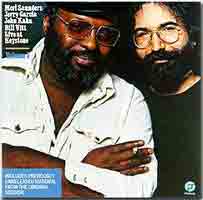 Jerry
Garcia spielte neben den Grateful Dead auch immer in anderen Bands: Bei
den "New Riders Of The Purple Sage"
gab's Countryrock, bei "Old And In
The Way" war es Bluegrass. Mit der Organisten Merl Saunders
spielte er Jazzstandards, Blues und Dylan-Songs. Mit dabei war damals
bereits John Kahn, später ständiger Bassist in der "Jerry
Garcia Band". Wir hören relaxte, manchmal etwas lang geratene
Improvisationen von Orgel und Gitarre über traditionellem Songmaterial. Jerry
Garcia spielte neben den Grateful Dead auch immer in anderen Bands: Bei
den "New Riders Of The Purple Sage"
gab's Countryrock, bei "Old And In
The Way" war es Bluegrass. Mit der Organisten Merl Saunders
spielte er Jazzstandards, Blues und Dylan-Songs. Mit dabei war damals
bereits John Kahn, später ständiger Bassist in der "Jerry
Garcia Band". Wir hören relaxte, manchmal etwas lang geratene
Improvisationen von Orgel und Gitarre über traditionellem Songmaterial.
|
| Judee Sill: "Heart Food" (Asylum, 1973) |
 Auch Judees zweites Album ist voll brillanter Musik. Eine Schande, dass
die damals kaum jemand gehört hat!!! Für mich ist Judee Sill
ganz klar die Entdeckung des Jahres, auch wenn sie schon lange nicht mehr
unter uns weilt...
Auch Judees zweites Album ist voll brillanter Musik. Eine Schande, dass
die damals kaum jemand gehört hat!!! Für mich ist Judee Sill
ganz klar die Entdeckung des Jahres, auch wenn sie schon lange nicht mehr
unter uns weilt...
(23.02.2006)

 Mehr ...
Mehr ...
Dass ein tragisches Leben eine triumphale Kunst hervorbringen kann und die Schönheit oft aus den hässlichsten Ecken des Lebens kommt, kann man natürlich nicht nur am Beispiel Hank Williams zeigen. Judee Sill, 1944 in Studio City/Los Angeles geboren, wurde nach dem frühen Tod ihres Vaters als Teenager von ihrem Stiefvater missbraucht, rebellierte gegen das Elternhaus, landete in der Besserungsanstalt, wo die die Kirchenorgel spielte, überfiel mit einer Affäre Schnapsläden und Tankstellen, verfiel LSD und Heroin, ging anschaffen und schlitterte von einer unheilvollen Beziehung in die nächste.
Sie schrieb aber auch einige der betörendsten und komplexesten Lieder der goldenen Songwriter-Ära. Ihr Debüt war 1971 eine der ersten Veröffentlichungen auf David Geffens neu gegründetem Label Asylum. Es war kein großer Erfolg. Aber die im letzten Moment noch auf dem Album platzierte, von Graham Nash produzierte Single „Jesus Was A Crossmaker“, die sie – inspiriert von Nikos Kanzantzakis Roman „The Last Temptation of Christ“ –, nach dem dramatischen Ende einer Affäre mit dem Songwriter J.D. Souther schrieb, wurde ein kleiner Radiohit und im Jahr darauf von den Hollies und Cass Elliott gecovert. Das brachte ihr immerhin eine Titelgeschichte im ROLLING STONE, die sich nicht wie das Porträt einer aufstrebenden Künstlerin, sondern eher wie die Westküsten-Version von Hubert Selbys „Last Exit To Brooklyn“ liest.
Der Nachfolger, den sie, wie schon den Großteil ihres Debüts, mit Joni Mitchells Toningenieur Henry Lewy aufnahm, sollte den kommerziellen Durchbruch bringen. Nicht mit Hitsingles, sondern mit purem Genie. Das Eröffnungsstück, „There's a Rugged Road“, klingt mit Fiddle und Pedal Steel noch wie eine clevere Country-Nummer, doch bereits mit „The Kiss“ – laut XTCs Andy Partridge der schönste Song, der je geschrieben wurde – hebt „Heart Food“ in Dimensionen ab, zu denen nur sehr wenige Songwriter:innen überhaupt einen Zugang haben (Brian Wilson vielleicht, bevor er Ende der Sechziger den Schlüssel verlor).
In „Heart Food“ stecken Folk und Gospel, Choräle und Fugen, Copland und Bach, Entrückung und Erlösung. „Songs from so deep/ While I'm sleepin', seep in/ Sweepin' over me/ Still the echo's achin'‘/ ,Leave us not forsaken‘“, barmt Sill im achtminütigen Schlussstück „The Donor“ und singt auf Dutzenden von Spuren das „Kyrie Eleison“.
Doch die Welt kannte kein Erbarmen – „Heart Food“ wurde wiederum kein Erfolg. Sill war frustiert, wollte nicht länger im Vorprogramm von „snotty rock bands“ auftreten und gab Labelchef Geffen, dem sie auf ihrem Debüt noch ihre Liebe gestanden hatte, die Schuld an allem. Ende 1973 wurde Sill mit einem Volkswagen, den sie sich von ihrem Ex-Lover Souther geliehen hatte, in einen Unfall verwickelt. Angeblich wurde sie von dem Schauspieler Danny Kaye angefahren, und John Wayne soll sie ins Krankenhaus gebracht haben. Ein Jahr später wurde sie Opfer häuslicher Gewalt, ein Lover stieß sie eine Treppe hinunter und sie und musste mehrfach am Rücken operiert werden. Die starken Schmerzen versuchte sie – eine Parallele zu Hank Williams – mit Drogen zu bekämpfen. „Alles ist verloren. Keine Hilfe mehr. Vielleicht kann die heilige Judy mir helfen? Bin auch in meinen Armen fixiert worden. Bin wieder schwer im Junkie-Dasein“, schrieb sie damals in ihr Tagebuch, in dem sich auch Ideen für neue Songs fanden.
Mit dem Bassisten Bill Plummer nahm sie 1974 noch unter starken Schmerzen im Studio von Ex-Monkee Michael Nesmith acht Demos auf. In dem neuen Song „Dreams Come True“, der dem nächsten Album den Titel geben sollte, sang sie: „Every way beauty is slain, it's seen/Though no word is uttered, a grave silence rings.“ Es sollte Sills letzte Studiosession bleiben, das Projekt wurde von Asylum auf Eis gelegt (und erschien 30 Jahre später in einem Mix von Jim O’Rourke).
Am 23. November 1973, einen Tag nach Thanksgiving, wurde Sill tot in ihrer Wohnung in North Hollywood aufgefunden. In ihrem Blut fand man eine tödliche Mischung aus Kokain und Codein. Sie war 35 Jahre alt.
„Once a crystal choir appeared/ While I was sleeping and called my name/ And when they came down nearer, saying, ,Dying is done‘/ Then a new song was sung until somewhere we breathed as one“, heißt es in „The Kiss“, dem schönsten Song, der je geschrieben wurde. Dass jeder, der mal in die faszinierende Welt von Judee Sill eingetaucht ist, bei Nennung ihres Namens als erstes an ihre strahlenden Lieder denkt und nicht an ihre tragische Lebensgeschichte, ist das beste Zeugnis ihres Genies.
(Maik Brüggemeier, ROLLING STONE-Wohnzimmer, Folge 42, 18.09.2023)
The second album Judee Sill made proved to be her last. A notoriously slow songwriter, this brief though enjoyable outing took its toll on Sill during its making, turning her back to her recently kicked heroin addiction and away from the desire to create more music. Instead of using an outside arranger for the strings (as she did on her previous album), Sill did all of the work herself. Her lack of formal training and the immense amount of orchestral overdubs certainly would have made such an outing a hardship for anyone. The album doesn't suffer much from its sometimes syrupy exterior, though -- the songs are almost as strong as any of those from her debut. To wit, Heart Food suffers only in comparison to its predecessor; otherwise, it's a stellar example of the kind of singer/songwriter fare the music industry was mining in the early '70s. The supporting cast of top L.A. studio musicians solidifies Sill's unique brand country-flavored pop, which moves from introspective meanderings to loping rock, often within a single song.
(by Alex Stimmel, All Music Guide)
Sometimes myths become reality, or apocryphal tales bear enough weight to be documented as fact. Heart Food, Judee Sill's legendary -- and up until now very rare -- second and final album, was recorded and released
in 1973 by Asylum Records when she was 29; she passed away six years later. Heart Food has been equated with Laura Nyro's classic New York Tendaberry, Essra Mohawk's Primordial Lovers, and Carole King's Tapestry as being a definitive moment in the work of female singer/songwriters. Part of this myth comes out of the reality that Heart Food has not been in print in more than 20 years. Rhino Handmade has issued the album on CD, along with its predecessor, Judee Sill [Expanded], for a limited time. The original (second) album is rounded out with nine extra tracks of live and demo material, is accompanied by a handsome package, a complete liner note essay by Michele Kort, and a slew of photographs. Now that it is available again, it is easy to see how that comparison by the critical pop establishment of the day was made: it's because it is accurate.
The beautifully rough edges on Sill's debut have all been smoothed out here by an engagement with subtle yet pervasive orchestration, stellar arrangements, tightly crafted songs that open up form the inside their musical frameworks, and draw on influences as varied as Tin Pan Alley to gospel and country to Mozart and Bach. The wildest thing is that Ms. Sill was responsible for all of it. She had complete artistic control and creative freedom in the studio -- those who know David Geffen's reputation will be surprised. And the cast of players bears out the confidence in Ms. Sill's abilities: Doug Dillard, Gloria Jones, Ray Kelly, Chris Ethridge, Spooner Oldham, Buddy Emmons, Jim Gordon, and many others.
Musically, Heart Food [Expanded] is a song suite whose songs all dovetail one another in relating an ache so deep in the gray matter of the soul that it threatens to burn the listener. One listen to "Down Where The Valleys Are Low" is enough to know that the hounds of hell have left their mark on the singer: "Push me on from the danger that's pullin' me and hold me so strong/Send a song on the wind to deliver me/Take me and rise, when the fire is on/Take the reins and the loneliness fillin' me/And make my fear fuel and the fuel hi-octane...." A church organ, a xylophone, and a Steve Cropper-ish lead guitar slowly hollow out the groove that is filled by a trio of backing vocalists doo-wopping gospel underneath, as Sill sings her heart out into a void only she can see through. Elsewhere, in the honky tonk, funky gospel of "Soldier of the Heart," Sill creates the entire tune in chorus form; each line is a testament: "The battlefield's so cold/Take my love as a token/I want to give it to you...." And as the band slips deeper into the openness of the rhythm track, Sill strides forth with her vocal into the very pit of loneliness and danger, and tries not only to be delivered herself, but to carry her listeners with her. This is naked music; there is no separation between artist and audience, no separation between forces of light and dark, everything is in this glorious pop maelstrom where life and death are just two sides of the same coin, and the desire for holiness and wholeness are nearly overwhelming in their intensity. But her approach is ecstatic, the neediness is in the words, but the music is pure, expressive joy. The bonus material, a series of outtakes and demos, bear out that the process was never effortless, but came easy to one who was adept at baring her soul. Heart Food deserves its rating as a classic because it has so few peers, and as music heard thirty years after the fact, its dignity remains unblemished; its innovation and creativity are still cause
for wonder and awe.
(about the Rhino-Handmade-Reissue by Thom Jurek , All
Music Guide)
|
| Shel Silverstein: "Freakin' At The Freakes Ball" (Columbia, 1973) |
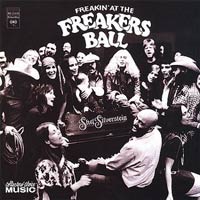

 Mehr ...
Mehr ...
|
Multimedia satirist Shel Silverstein had been perfecting his craft since the mid-'50s, releasing seven long-players since his debut, Hairy Jazz (1959). Some 13 years later, Silverstein made his way on to the album charts with Freakin' at the Freakers Ball (1972). Accompanied by the relatively unknown Dr. Hook & the Medicine Show, Silverstein turns his scatological mind toward the hippie counterculture. Their espousal of free love, copious drug use, and general antisocial promiscuity are rendered flaccid and otherwise ineffective throughout the dozen story-song fables. "I Got Stoned and I Missed It" takes a few fairly obvious digs at the futility inherent in substance abuse, while the ambiguity of "Thumbsucker" is awash in an undercurrent of sexual implications and understated humor. Similarly, "Don't Give a Dose to the One You Love Most" almost jovially references communicably transmitted diseases. The title cut "Freakin' at the Freakers Ball" pokes fun at "love-in" type assemblies, even inspiring annual events, that would devolve into free-for-alls held in the name of hedonism. The self-absorption and intemperance of the so-called Me Generation is brought to bear on both "All About You" and the slightly more gynocentric "Liberated Lady 1999," a track best described as an ode to the feminist movement. Less confrontational is the whimsical "Sahra Cynthia Sylvia Stout Would Not Take the Garbage Out," a bit of poetry that could have easily fit into his one of his numerous children's books. Below the surface lies clever alliteration of a tale decrying the laissez faire attitudes of an entire generation. [When the platter was issued on CD in 1999, three bonus selections were added, the single-only sides "A Front Row Seat to Hear Ole Johnny Sing" and "26 Second Song," as well as Silverstein's own version of "Everybody's Makin' It Big But Me," notably covered by Dr. Hook & the Medicine Show on their Bankrupt (1975) LP.]
(by Lindsay Planer, All
Music Guide)
|
Lost and Found! |
| Staple Singers: "Be What You Are" (Stax, 1973) |
 Viele kennen die Gruppe wahrscheinlich nur von ihrer Beteiligung beim
"Last Waltz", dem Abschiedskonzert
von The Band. Dieses Frühsiebzigeralbum hat einen schönen
Sound (viel E-Piano!) und ist halt eines der wenigen, das ich von Pops
Staples und seinen drei Töchtern kenne. Mavis Staples
singt wie immer überirdisch gut.
Viele kennen die Gruppe wahrscheinlich nur von ihrer Beteiligung beim
"Last Waltz", dem Abschiedskonzert
von The Band. Dieses Frühsiebzigeralbum hat einen schönen
Sound (viel E-Piano!) und ist halt eines der wenigen, das ich von Pops
Staples und seinen drei Töchtern kenne. Mavis Staples
singt wie immer überirdisch gut. |
| String Driven Thing: "The Machine That Cried" (Charisma, 1973) |
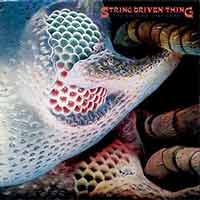 Diese "Saitengetriebene Angelegenheit" ist sicherlich nur eine
(eher unbedeutende) Fußnote in der Rockhistorie. Seit dem titellosen
Vorgängeralbum wurde der Folkrock der Geschwister (?) Chris
Adams (Gesang, Gitarre, Songwriting) und Pauline Adams (Engelsstimme),
dem Bassisten Colin Wilson und dem Geiger Graeme Smith um
einen Trommler erweitert. Die Platte habe ich übrigenz ca. 1975 auf
einem Flohmarkt in London erstanden, aber jahrelang nicht mehr gehört.
Kürzlich gab's dann die Reissue-CD bei Zweitausendeins in der Grabbelkiste,
sodass es mir nicht schwer fiel, erneut zuzuschlagen! Ergebnis: ein paar
sehr schöne Songs von Chris Adams, treibende Rhythmen - und diese
manchmal etwas nervige Geige von Mr. Smith, den ich dann später mal
mit Van Der Graaf live an der Essener PH gesehen habe (Hawkwind
und Van der Graaf im Doppelpack!). Auch da hatte er nicht gerade
"zurückhaltend" seine Geige bedient. Der Mann ist, soweit
ich das beurteilen kann, ein echter Könner auf seinem Instrument,
weiß aber scheinbar nicht immer, wann genug ist. Genau das, was
mich auch an vielen Jazzrockgitarrenalben nervt. Trotzdem eine gute Platte.
Diese "Saitengetriebene Angelegenheit" ist sicherlich nur eine
(eher unbedeutende) Fußnote in der Rockhistorie. Seit dem titellosen
Vorgängeralbum wurde der Folkrock der Geschwister (?) Chris
Adams (Gesang, Gitarre, Songwriting) und Pauline Adams (Engelsstimme),
dem Bassisten Colin Wilson und dem Geiger Graeme Smith um
einen Trommler erweitert. Die Platte habe ich übrigenz ca. 1975 auf
einem Flohmarkt in London erstanden, aber jahrelang nicht mehr gehört.
Kürzlich gab's dann die Reissue-CD bei Zweitausendeins in der Grabbelkiste,
sodass es mir nicht schwer fiel, erneut zuzuschlagen! Ergebnis: ein paar
sehr schöne Songs von Chris Adams, treibende Rhythmen - und diese
manchmal etwas nervige Geige von Mr. Smith, den ich dann später mal
mit Van Der Graaf live an der Essener PH gesehen habe (Hawkwind
und Van der Graaf im Doppelpack!). Auch da hatte er nicht gerade
"zurückhaltend" seine Geige bedient. Der Mann ist, soweit
ich das beurteilen kann, ein echter Könner auf seinem Instrument,
weiß aber scheinbar nicht immer, wann genug ist. Genau das, was
mich auch an vielen Jazzrockgitarrenalben nervt. Trotzdem eine gute Platte.

 Mehr ...
Mehr ...
While this group's name is often the impetus for String Driven Thing falsely acquiring a folk-rock classification, they were in actuality a boogie and psychedelia-laced rock & roll band who happened to have electric violin as their lead instrument. In 1973, when this album was initially released, very few rock bands featured the violin as prominently as they did. Violinist Grahame Smith helped blaze the trail for fiddlers like Ric Sanders and Robbie Steinhardt to openly strut their stuff within the confines of rock & roll. This album at times showed signs of creativity, but unfortunately its inconsistency was symptomatic of String Driven Thing's career. The slow soft rock numbers are the bane of this recording, while the manic psychedelic pieces like "Sold Down the River," "Heartfeeder," and "Night Club" showed this band at its finest. Too bad the former outnumbered the latter. The 1996 reissue contains three bonus tracks "If Only the Good," "It's a Game," and "Part of the City."
(by Dave Sleger, All Music Guide)
Originally released in 1973 by Charisma Records, "The Machine That Cried" was String Driven Thing's third LP and was released at the time in a form which omitted ten minutes of the epic 12-minute track, "River Of Sleep". This version (released in 1996) is the first to ever reflect the band's intentions when the album was recorded.
Based around the nucleus of vocalist/rhythm guitarist/songwriter Chris Adams, his wife Pauline Adams (vocals) and Grahame Smith (violin, later with Van Def Graaf Generator and Peter Hammill), String Driven Thing's early style was likened to that of the Byrds, and early songs written by Chris Adams shows the influence of Bob Dylan, but the introduction of Grahame Smith made the group's sound unique.
Soon after recording this album in 1973, String Driven Thing were the opening act for the "Foxtrot" tour by Genesis, but they allegedly stole the tour after winning five encores at a show in the English Home Counties, which was regarded as inappropriate behaviour for a support act.
With 8-page booklet containing both contemporary and current photographs of band members, and with three bonus tracks from the same period, two never previously on CD, "The Machine Cried" features an alternate version of the still much played single from the 1970s, "It's A Game".
British national daily "The Gaurdian" called this LP "a staggering achievement" in 1973, and "MOJO" magazine in 1996 described it as "a much hailed album".
|
| Sweet Smoke: "Darkness To Light" (EMI/Harvest 1973) |
 Sweet
Smoke waren 5 amerikanische Hippies, die in den frühen 70ern
ganz in meiner Nähe in Emmerich (!) gelebt und sogar
beim legendären Harvest-Label von Mutter EMI ein paar Platten
herausgebracht haben. Das Debütalbum "Just
A Poke", aufgenommen im September 1970, bestand aus zwei ganzseitigen
Jams (jeweils über 16 Minuten) und durfte damals in keinem guten
Kifferhaushalt fehlen - und auch wir haben diese Platte damals viel gehört. Sweet
Smoke waren 5 amerikanische Hippies, die in den frühen 70ern
ganz in meiner Nähe in Emmerich (!) gelebt und sogar
beim legendären Harvest-Label von Mutter EMI ein paar Platten
herausgebracht haben. Das Debütalbum "Just
A Poke", aufgenommen im September 1970, bestand aus zwei ganzseitigen
Jams (jeweils über 16 Minuten) und durfte damals in keinem guten
Kifferhaushalt fehlen - und auch wir haben diese Platte damals viel gehört.
Das zweite Album "Darkness To Light" vom Herbst 1972 war damals
an mir vorbeigegangen und gibt es
zusammen mit "Just A Poke" auf einer CD. Es hat deutlich
kürzere Stücke (zwischen 4 und 13 Minuten), klingt weniger nach
Grateful Dead und mehr nach Folk und Indien.
(23.05.2010) |
| McCoy Tyner: "Enlightenment" (Milestone, 1973) |
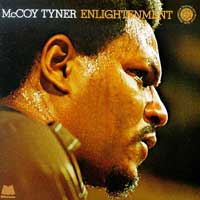 Tyner kennen viele nur als den Begleiter von John Coltrane. Für
mich ist er aber einer der besten Jazzpianisten überhaupt. Unglaublich,
welche Kraft und gleichzeitig Feinheit der Mann in sein Spiel legt! Während
sich seine Kollegen Hancock und Corea in den Spät60ern/Früh70ern
vermehrt um Elektrifizierung kümmerten, blieb Tyner beim Konzertflügel,
ohne dabei irgendwie altmodisch zu klingen.
Tyner kennen viele nur als den Begleiter von John Coltrane. Für
mich ist er aber einer der besten Jazzpianisten überhaupt. Unglaublich,
welche Kraft und gleichzeitig Feinheit der Mann in sein Spiel legt! Während
sich seine Kollegen Hancock und Corea in den Spät60ern/Früh70ern
vermehrt um Elektrifizierung kümmerten, blieb Tyner beim Konzertflügel,
ohne dabei irgendwie altmodisch zu klingen.
"Enlightenment" ist zwar "nur" ein Livedoppelalbum
vom piekfeinen Montreux-Jazzfestival, aber es enthält keine netten
Standards, sondern eine extra komponierte "Enlightenment Suite".
Die Begleitband ist vorzüglich: der damals knapp 20jährige Saxofonist
Azar Lawrence in bester Coltrane-Manier, am Bass Joony Booth
(kenn ich nicht weiter) und am Schlagwerk der "Jazzrockfusionstar"
Alphonse Mouzon. Starkes Teil!

 Mehr ...
Mehr ...
This is one of the great McCoy Tyner recordings. The powerful, percussive, and highly influential pianist sounds quite inspired throughout his appearance at the 1973 Montreux Jazz Festival. Azar Lawrence (on tenor and soprano) is also quite noteworthy and there is plenty of interplay with bassist Juney Booth and drummer Alphonse Mouzon. But Tyner is the main star, whether it be on his three-part "Enlightenment Suite," "Presence," "Nebula," or the 25-minute "Walk Spirit, Talk Spirit."
(by Scott Yanow, All Music Guide)
|
| Marcos Valle: "Previsao Do Tempo" (Odeon, 1973) |
 Lost & Found! Brazil!
Lost & Found! Brazil!
(03.03.2013)

 Mehr ...
Mehr ...
Mit den Texten auf Englisch und Portugiesisch. Zehn Jahre, nachdem das Debüt von Marcos Valle („Samba Demais") Liebhaber brasilianischer Musik mit dem unglaublichen Talent der Valle-Brüder bekannt machte, half eine neue Richtung und eine neue Backing Band dem Sänger dabei, seine musikalische Palette auszuweiten.
Groovy Funk und Jazz-Fusion, die Hilfe der Band Azimuth (später Azymuth), Synthies, Fender Rhodes und elektronische Sounds ließen den Samba, Bossa Nova und Baiao von Valle zusammen mit der Inspiration aus schwarzer amerikanischer Musik und dem Psych Rock früherer Alben neue Dimensionen erschließen. Obwohl sich Valle nicht komplett vom Sound seiner Vergangenheit entfernte, bringen der Gesang, die Grooves und die tiefgründigen Songs auf „Previsao Do Tempo" den Hörer dazu, sich frei zu fühlen und nachzudenken.
„Previsao Do Tempo" erschien ursprünglich 1973 und mauserte sich schnell zum Liebling der Valle-Jünger. Neue und alte Fans werden den einfachen Zugang zu diesem ehemals kaum zu findenden brasilianischen Klassiker lieben.
„Previsao Do Tempo" ist ein Highlight in der Valle-Diskographie und ein willkommener Neuzugang in jeder südamerikanisch angehauchten Plattensammlung. File after Os Mutantes and before Caetano Veloso.
While Garra had seen all of Marcos Valle's talented parts -- songwriting, production, singing, and performing -- coalesce into the most beautiful whole ever seen in Brazilian music, Previsão do Tempo represented a slight pulling back from those lofty heights. Easygoing and relaxed where Garra had been nearly giddy with joy, the album still didn't lack for career-topping moments -- most of them due to the sunny groove produced by Valle with his backing band (soon to break away and form the boundary-pushing Azymuth). With Valle on Fender Rhodes and Jose Roberto Bertrami on Mini-Moog and ARP, the album is more electronic than electric, but with soloists as talented as these, and a lifetime of musical instincts to draw on, the results are absolutely pristine. (Only Stevie Wonder was capable of coaxing the same type of warm, fluid grooves from his coterie of synthesizers, and integrating them so flawlessly into his productions.) As could be expected, narrative songwriting takes a backseat. In its place are loose, aqueous, funk-filled jams with synth and electric bass leading the way. Garra is still the peak of Marcos Valle's '70s output, but Previsão do Tempo is its own masterpiece, one where a listener plays connect-the-dots to hear the beauty inside.
(by John Bush, All Music Guide)
|
| Velvet Underground: "Squeeze" (Polydor, 1973) |
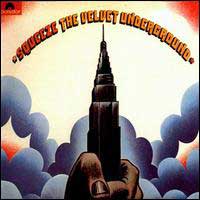 Vor einiger Zeit konnte ich eine digitale Kopie dieses extrem obskuren
und raren Albums auftreiben, das gerne in fast allen Geschichten über
Velvet Undergriound vergessen wird. Im Grund ist das auch keine wirkliches
Velvet Underground-Album, sondern eher eine nette Folkrock-Soloplatte
von Doug Yule, begleitet nur von - bitte nicht lachen - Ian
Paice - von Deep Purple am Schlagzeug!
Vor einiger Zeit konnte ich eine digitale Kopie dieses extrem obskuren
und raren Albums auftreiben, das gerne in fast allen Geschichten über
Velvet Undergriound vergessen wird. Im Grund ist das auch keine wirkliches
Velvet Underground-Album, sondern eher eine nette Folkrock-Soloplatte
von Doug Yule, begleitet nur von - bitte nicht lachen - Ian
Paice - von Deep Purple am Schlagzeug!
Wenn man also mal Alles im Zusammenhang mit VU aussen vor lässt
- ist das eine kleine, nette, wenn auch sicherlich unwichtige Platte aus
den frühen 70ern, der im Grunde viel Unrecht angetan wurde!

 Mehr ...
Mehr ...
After Lou Reed left the Velvet Underground, bassist Doug Yule took control
of the group. Retaining the name "The Velvet Underground," Yule
assembled several new lineups of the band and toured the U.S. By the time
Yule's VU recorded their first album, the band featured Boston-based vocalist
Willie Alexander and was playing a set of conventional pop/rock songs.
Squeeze, the only album recorded with a bastardized version of the Velvet
Underground, was released in 1973 to uniformly terrible reviews; Yule
broke up the band shortly after its release. Over the years, Squeeze has
not only become increasingly rare -- after all, not many copies of the
record were pressed -- it has disappeared from the official Velvet Underground
discography, and Yule's attempt to prolong the band's career has virtually
been forgotten.
(by Stephen Thomas Erlewine, All Music Guide)
Background
By 1972, the Velvet Underground had established a
considerable cult following. Their post-Reed years
have since been derided by some purists, but the
surviving reviews of the era are among the best the
band ever received. There are sadly few live
recordings from late '70 to '73 known to exist, but
the ones that do (including, happily the final VU show)
reveal a tight, inventive and haunting band. They
added a distinctly prog touch to 'Oh! Sweet Nuthin'
for instance; and while their new material sounded
influenced by the Beatles and country-rock, it had the
distinct Velvet Underground edge. Steve Sesnick, the
ill-regarded manager of the band beginning in '67,
made his final move with the arrangement of
"Squeeze". The album would be recorded with Yule
and Ian Paice of Deep Purple, that was how it came
down, it was not Yule's decision to exclude anyone
else in the band. It effectively ended Maureen
Tucker's membership however and is still a highly
contentious move. Yule still regrets it to this day,
although by all accounts Maureen was planning to
leave the band anyway to take care of her child full
time. She has expressed no bitterness over the split.
Whether or not her absence from the sessions hurts
the music is debatable. The new directions may not
have been too suitable for her minimalist style; Ian
Paice, on the other hand, is a master of rock and prog
drumming. He sounds absolutely restrained compared
to his Mark 2 and beyond Purple work, but not
relaxed. There's an uncharacteristic nervousness to
his drumming on "Squeeze" which compliments
Yule very well. There was no intention for Paice to
stay with the VU, he was only in the band for these
sessions. He never played a gig with the VU.
"Squeeze" was slated for a fall '72 UK release on
their own Loaded Records imprint, distributed by
Polydor. A new lineup was assembled for a UK
tour to coincide with the release of the album and
negotiations were underway for US distribution.
Sessions
Little is known about the "Squeeze" sessions, held in the summer of '72
in London and under a considerably tight budget (maybe where the title comes in).
Yule has been rarely interviewed (see links) but
has never mentioned any musician other than
Paice. But as mentioned previously, there is
that unidentified female vocalist, who is quite
impressive.
(Some sources claim her to be his wife, or at the
very least, his girlfriend at the time.)
There were no specific liner notes.
In a recent interview Paice said that he may not
be the only drummer on "Squeeze", but without
session documentation we can't verify anything.
What is known is that Doug Yule played the bulk
of the music himself; these were challenging, but
fun sessions for the artist. The criticism usually
lobbed at "Squeeze" is that it could have been a
Doug Yule solo album, not the music.
AND...as for the claim that "Squeeze" has only
been issued once, there appears to be some
debate there. A few dozen people claim to have
French copies dating from the '80's, and this now
does appear to be true. There is a definite
possibility that certain unscrupulous record
companies reissued the record, either illegally or
claiming squatters rights in territories with less
stringent copyright laws. Not only is this
scenario possible, it is also likely.
Today there is no hard evidence who owns the rights to the masters. If Polygram reissued the
album 20 years ago, who had the rights then?
www.bobchaos.com
|
| Tony Joe White: "Homemade Ice Cream" (Warner, 1973) |
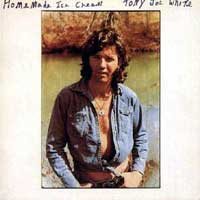 Viele kennen den Mann nur von seinem Hit aus den 60ern "A Rainy Night In
Georgia", den wohl so gut wie jeder Crooner schon aufgenommen hat,
oder von seiner Zusammenarbeit als Autor und Gitarrist mit Tina Turner
in den 80ern: da trägt z.B. das Lied "Steamin' Windows"
sicherlich zu seiner Alterssicherung bei. In den frühen 70ern hat
er für Warner drei wunderbar relaxte Alben aufgenommen: "Tony
Joe White." (1971) mit Produzent Peter Asher (Ex-Peter &
Gordon, erfolgreich mit James Taylor und Linda Ronstadt), "The Train
I'm On" (1972) mit den Atlantic-Legenden Jerry Wexler und
Tom Dowd an den Reglern und eben "Home Made Icecream"
(1973), produziert von White selbst zusammen mit Tom Dowd. Die
Begleitband war zu dieser Zeit das Maß aller Dinge in den Studios
von Memphis und Nashville: Norbert Putnam am Bass, David Briggs
an Hammond-B3 und diesem fantastisch klingenden E-Piano, Reggie Young
an der Gitarre und Kenny Malone am Schlagzeug. Nicht zu unterschätzen
ist natürlich Whites eigenes Spiel auf der Gitarre (da hat er ganz
klar seinen eigenen Ton!) und an der Mundharmonika. Das Coverfoto mit
tierischem Backenbart (steht ihm besser als den deutschen Fußballern
bei der WM 74!) und dem lässig geknoteten Jeanshemd erinnert mich
aber auch ein wenig an die Sex- und sonstigen Trashfilme aus dieser Zeit,
die lange Zeit dauernd nachts bei den Privaten liefen. Da kann Tony Joe
natürlich garnix für.
Viele kennen den Mann nur von seinem Hit aus den 60ern "A Rainy Night In
Georgia", den wohl so gut wie jeder Crooner schon aufgenommen hat,
oder von seiner Zusammenarbeit als Autor und Gitarrist mit Tina Turner
in den 80ern: da trägt z.B. das Lied "Steamin' Windows"
sicherlich zu seiner Alterssicherung bei. In den frühen 70ern hat
er für Warner drei wunderbar relaxte Alben aufgenommen: "Tony
Joe White." (1971) mit Produzent Peter Asher (Ex-Peter &
Gordon, erfolgreich mit James Taylor und Linda Ronstadt), "The Train
I'm On" (1972) mit den Atlantic-Legenden Jerry Wexler und
Tom Dowd an den Reglern und eben "Home Made Icecream"
(1973), produziert von White selbst zusammen mit Tom Dowd. Die
Begleitband war zu dieser Zeit das Maß aller Dinge in den Studios
von Memphis und Nashville: Norbert Putnam am Bass, David Briggs
an Hammond-B3 und diesem fantastisch klingenden E-Piano, Reggie Young
an der Gitarre und Kenny Malone am Schlagzeug. Nicht zu unterschätzen
ist natürlich Whites eigenes Spiel auf der Gitarre (da hat er ganz
klar seinen eigenen Ton!) und an der Mundharmonika. Das Coverfoto mit
tierischem Backenbart (steht ihm besser als den deutschen Fußballern
bei der WM 74!) und dem lässig geknoteten Jeanshemd erinnert mich
aber auch ein wenig an die Sex- und sonstigen Trashfilme aus dieser Zeit,
die lange Zeit dauernd nachts bei den Privaten liefen. Da kann Tony Joe
natürlich garnix für. |
| David Wiffen: "Coast To Coast Fever" (United Artists, 1973) |

Ein völlig unbekannt gebliebener Singer/Songwriter, für den ich
mich kürzlich zu interessieren begann, weil wir sein bekanntestes
Lied "Lost My Driving Wheel" jetzt bei W4L im Repertoire
haben, das schon von vielen Künstlern gecovert wurde: The Byrds
(auf dem Album "Farther Along" von 1971), Roger McGuinn
(solo), Tom Rush, Cowboy Junkies
und Ray Wylie Hubbard (auf dem neuen Album "Delirium Tremolo"
von 2005). Leider stammt das Lied von seinem anderen Album von 1971,
das ich aber leider bisher nirgendwo auftreiben konnte. Wird sicherlich
noch ein hartes Stück Arbeit. Ach ja: "Coast To Coast Fever"
ist zwar ohne jenes Lied, aber trotzdem eine wunderschöne, folkige
Singer/Songwriter-Perle. Stimmlich erinnert der in England geborene
und in Kanada beheimatete Davd Wiffen ein wenig an jenen Tom
Rush und an David Blue. So
was mag ich im Moment sehr. Produzent der Platte war Bruce Cockburn,
der in den 60ern mit Wiffen zusammen in einer Band gewesen sein soll.
(26.03.2006)
Das Suchen nach dem Debütalbum "David
Wiffen" hat dann doch nicht solange gedauert ...
(06.05.2006)
|
| Larry Young: "Lawrence Of Newark" (Perception, 1973) |
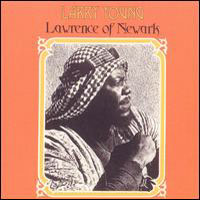 Larry Young war einer der besten Orgelspieler des Jazz. Nachzuhören
auf diesem eher unbekannten Album aus den 70ern, das unter der Mitwirkung
des Gitarristen James 'Blood" Ulmer entstand. Bekannt wurde
er neben seinem Blue Note-Meisterwerk "Unity" besonders durch
die Mitwirkung in der ersten Besetzung von Tony Wiliams Lifetime,
sowie auf dem Album "Love Devotion Surrender"
von Carlos Santana und John McLaughlin.
Larry Young war einer der besten Orgelspieler des Jazz. Nachzuhören
auf diesem eher unbekannten Album aus den 70ern, das unter der Mitwirkung
des Gitarristen James 'Blood" Ulmer entstand. Bekannt wurde
er neben seinem Blue Note-Meisterwerk "Unity" besonders durch
die Mitwirkung in der ersten Besetzung von Tony Wiliams Lifetime,
sowie auf dem Album "Love Devotion Surrender"
von Carlos Santana und John McLaughlin.
(27.06.2009)

 Mehr ...
Mehr ...
The late Larry Young was an organist whose fairly brief career had lots of highs and very few middles or lows. Take this session from 1973 — his first non-Blue Note date as a leader and post-Lifetime — as a for instance. It is startling for its fresh look at how the organ is used in jazz and in improvisation, period. On Lawrence of Newark, Young enlisted a host of younger New York session cats who were hanging around the fringes of the funk and avant-garde scenes — James Blood Ulmer, trumpeter Charles MacGee, Cedric Lawson, and about a dozen others all jumped into Young's dark and freaky musical stew. Made up of only five tracks, rhythm is the hallmark of the date as evidenced by the conga and contrabass intro to "Sunshine Fly Away." Deirdre Johnson's cello opens up a droning modal line for Young to slide his organ over in what passes for a melody but is more of an idea for a theme and a trio of variations. Armen Halburian's congas echo the accents at the end of the drum kit and Young's own tapering pronouncements moving back and forth between two and four chords with a host of improvisers inducing a transcendent harmonic hypnosis. The centerpiece of the album is "Khalid of Space Pt. 2: Welcome." Sun Ra's edict about all of his musicians being percussionists holds almost literally true in Young's case. The soprano saxophonist sounds as if it could be Sonny Fortune (billed as "mystery guest"), but he's way out on an Eastern modal limb. Young's right hand is punching home the counterpoint rhythm as Abdul Shadi runs all over his kit. Blood Ulmer is accenting the end of each line with overdriven power chords, and various bells, drums, congas, and djembes enter and depart the mix mysteriously. Young is digging deep into the minor and open drone chords, signaling — à la Miles — changes in intonation, tempo, and frequency of rhythmic attack. And the cut never loses its pocket funk for all that improvisation. It's steamy, dark, brooding, and saturated with groove. The CD reissue has fine sound and sells for a budget price; it should not be overlooked. The DJs just haven't discovered this one yet. Awesome.
(by Thom Jurek, All Music Guide)
|
| Townes van Zandt: "The Late Great Townes van Zandt" (Tomato, 1973) |
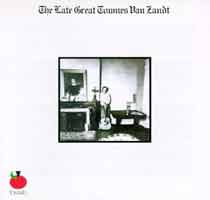 Das letzte Studioalbum vor der langen Pause bis 1978 enthält zwei der
bekanntesten Songs von TVZ: "Poncho & Lefty" (1977 von Emmylou
Harris veredelt und 1982 im Duett von Willie Nelson und Merle
Haggard zu Hit-Ehren gekommen) und "If I Needed You" (1981
von Emmylou und 1998 von Lyle Lovett aufgenommen). Dazu kommen
das wunderschöne "No Lonesome Tune", die Coverversion von
Guy Clarks "Don't Let The Sunshine Fool You" und "Heavenly
Houseboat Blues", die Zusammenarbeit mit dessen Frau Suzanna Clark.
Das letzte Studioalbum vor der langen Pause bis 1978 enthält zwei der
bekanntesten Songs von TVZ: "Poncho & Lefty" (1977 von Emmylou
Harris veredelt und 1982 im Duett von Willie Nelson und Merle
Haggard zu Hit-Ehren gekommen) und "If I Needed You" (1981
von Emmylou und 1998 von Lyle Lovett aufgenommen). Dazu kommen
das wunderschöne "No Lonesome Tune", die Coverversion von
Guy Clarks "Don't Let The Sunshine Fool You" und "Heavenly
Houseboat Blues", die Zusammenarbeit mit dessen Frau Suzanna Clark.
|
 Das Album des Jahres
Das Album des Jahres weitere Highlights ...
weitere Highlights ...  Eigentlich waren die Beach Boys damals auf dem Tiefpunkt ihre Karriere
(Brian Wilson war ein hilfloses Drogenwrack), als irgend jemand die verrückte
Idee hatte, in Holland ein Platte aufzunehmen, wozu ein ganzes Studio
in Einzelteilen von Kalifornien in die Nähe von Hilversum geschafft
wurde (ihr solltet mal den interessanten Bericht
über das Entstehen der Platte lesen!). Trotz all der widrigen Umstände
entstand eine wunderschöne Platte - und sogar Brian Wilson
war dabei. Sie enthält mit "Sail On Sailor" eines meiner
absoluten Lieblingsstücke von ihm. Neben dem harten Kern um Brian,
Carl Wilson, Dennis Wilson, Mike Love und Alan
Jardine gehörten zu dieser Zeit auch die beiden südafrikanischen
Musiker Ricky Fataar (Schlagzeug) und Blondie Chaplin (Gitarre)
fest zur Band.
Eigentlich waren die Beach Boys damals auf dem Tiefpunkt ihre Karriere
(Brian Wilson war ein hilfloses Drogenwrack), als irgend jemand die verrückte
Idee hatte, in Holland ein Platte aufzunehmen, wozu ein ganzes Studio
in Einzelteilen von Kalifornien in die Nähe von Hilversum geschafft
wurde (ihr solltet mal den interessanten Bericht
über das Entstehen der Platte lesen!). Trotz all der widrigen Umstände
entstand eine wunderschöne Platte - und sogar Brian Wilson
war dabei. Sie enthält mit "Sail On Sailor" eines meiner
absoluten Lieblingsstücke von ihm. Neben dem harten Kern um Brian,
Carl Wilson, Dennis Wilson, Mike Love und Alan
Jardine gehörten zu dieser Zeit auch die beiden südafrikanischen
Musiker Ricky Fataar (Schlagzeug) und Blondie Chaplin (Gitarre)
fest zur Band.
 Mehr ...
Mehr ...
 "This first album by Scotland's Frankie Miller features pub-rock favorites Brinsley Schwarz
as his backup band. That alone is reason enough to own this
record. Add to that a nice batch of songs (mostly originals) and you have
an enjoyable album." (Jim Worbois, All Music Guide)
"This first album by Scotland's Frankie Miller features pub-rock favorites Brinsley Schwarz
as his backup band. That alone is reason enough to own this
record. Add to that a nice batch of songs (mostly originals) and you have
an enjoyable album." (Jim Worbois, All Music Guide)
 Das Debütalbum von Bruce hatte ich Mitte oder Ende der 70er mit meinem
alten Phillips-Tonbandgerät mitgeschnitten. Die Bänder existieren
lange nicht mehr, sodass ich auch diese akustischen Grüße ewig
nicht mehr gehört habe. Kürzlich kam mir das Album aber im MP3-Format
unter die Finger, wobei mir aufgefallen ist, was für ein tolles Album
ich da jahrelang verdrängt habe. Jedes der Lieder ist anders, jedes
ist klasse. Im Nachhinein nicht nachvollziehbar, warum Bruce nicht bereits
mit diesem Album den großen Durchbruch schaffte. Merkwürdigerweise
bin ich trotzdem selber nie zum großen Springsteen-Fan geworden,
obwohl ich "Born To Run"
und besonders "Darkness On The
Edge Of Town" - und im Grunde auch dieses hier - für gr0ßartige
Alben halte. Aber irgend wie war mir der Mann ab den 80ern einfach zu
präsent. Oder seine Alben wurde (aus meiner Sicht) einfach nur schlechter.
Das Debütalbum von Bruce hatte ich Mitte oder Ende der 70er mit meinem
alten Phillips-Tonbandgerät mitgeschnitten. Die Bänder existieren
lange nicht mehr, sodass ich auch diese akustischen Grüße ewig
nicht mehr gehört habe. Kürzlich kam mir das Album aber im MP3-Format
unter die Finger, wobei mir aufgefallen ist, was für ein tolles Album
ich da jahrelang verdrängt habe. Jedes der Lieder ist anders, jedes
ist klasse. Im Nachhinein nicht nachvollziehbar, warum Bruce nicht bereits
mit diesem Album den großen Durchbruch schaffte. Merkwürdigerweise
bin ich trotzdem selber nie zum großen Springsteen-Fan geworden,
obwohl ich "Born To Run"
und besonders "Darkness On The
Edge Of Town" - und im Grunde auch dieses hier - für gr0ßartige
Alben halte. Aber irgend wie war mir der Mann ab den 80ern einfach zu
präsent. Oder seine Alben wurde (aus meiner Sicht) einfach nur schlechter. Atlantis waren im Grunde die runderneuerten Frumpy:
zu Sängerin Inga Rumpf, Keyboarder Jean-Jacques Kravetz
und Bassist Karl-Heinz Schott kamen Gitarrist Frank Diez
und Trommler Curt Cress, die Jahre später dann zur Créme
der Deutschrock-Mucker gehörten und oft bei solchen Herrschaften
wie Udo Lindenberg und Peter Maffay zu sehen und zu hören waren.
Curti hielt es damals aber nicht lange bei Atlantis und war bereits bei
der anstehenden Englandtournee durch niemand anderen als Udo Lindenberg
ersetzt worden, der beim zum Jahresende erscheinenden Nachfolgealbum "It's
Getting Better" aber seinen Platz schon wieder für Ringo
Funk (Ex-Jeronimo, falls das jemanden interessiert) geräumt hatte.
Die Platte verkaufte sich damals kurioserweise schlechter und war weniger
beliebt als das zeitgleich veröffentlichte posthume Livealbum von
Frumpy, was Frau Rumpf und ihren treuen Gesellen sicherlich mit
lachendem (wegen der zusätzlichen Einnahmen) und weinendem Auge (wegen
der offensichtlichen Missachtung der musikalischen Weiterentwicklung der
Band durch die Kundschaft) gesehen haben.
Atlantis waren im Grunde die runderneuerten Frumpy:
zu Sängerin Inga Rumpf, Keyboarder Jean-Jacques Kravetz
und Bassist Karl-Heinz Schott kamen Gitarrist Frank Diez
und Trommler Curt Cress, die Jahre später dann zur Créme
der Deutschrock-Mucker gehörten und oft bei solchen Herrschaften
wie Udo Lindenberg und Peter Maffay zu sehen und zu hören waren.
Curti hielt es damals aber nicht lange bei Atlantis und war bereits bei
der anstehenden Englandtournee durch niemand anderen als Udo Lindenberg
ersetzt worden, der beim zum Jahresende erscheinenden Nachfolgealbum "It's
Getting Better" aber seinen Platz schon wieder für Ringo
Funk (Ex-Jeronimo, falls das jemanden interessiert) geräumt hatte.
Die Platte verkaufte sich damals kurioserweise schlechter und war weniger
beliebt als das zeitgleich veröffentlichte posthume Livealbum von
Frumpy, was Frau Rumpf und ihren treuen Gesellen sicherlich mit
lachendem (wegen der zusätzlichen Einnahmen) und weinendem Auge (wegen
der offensichtlichen Missachtung der musikalischen Weiterentwicklung der
Band durch die Kundschaft) gesehen haben. Mehr ...
Mehr ...
 McGuinns letzte Byrdsbesetzung hatte gerade ihr Abschiedskonzert gegeben (Clarence
White, der kurz darauf bei einem Autounfall verstarb, Chris Hillman
und Joe Lala als Ersatz für die gekündigten Skip Battin
und Gene Parsons), als durch David Geffen (der damals für
das neue Asylum-Label alle möglichen Leute unter Vertrag nahm - sogar
Bob Dylan) das Angebot für
eine Byrdsplatte in Originalbesetzung (Roger McGuinn, David
Crosby, Gene Clark, Chris Hillman und Michael Clarke)
kam. Obwohl diese Platte sicher nicht den Vergleich mit den alten standhält
und alle bis auf den Trommler Michael Clarke je 2 Songs beitragen, die
meist schwächer als vergleichbare Titel von Soloplatten sind, fallen
3 Coverversionen positiv auf "For Free" von Joni Mitchell,
"Cowgirl In The Sand" und "See The Sky About To Rain"
von Neil Young. Nicht zuletzt wegen der schlechten Kritiken wurde
diese Reunion nicht verlängert. Aus der zeitlichen Distanz finde
ich aber, dass die Platte durchaus ihren Charme hat.
McGuinns letzte Byrdsbesetzung hatte gerade ihr Abschiedskonzert gegeben (Clarence
White, der kurz darauf bei einem Autounfall verstarb, Chris Hillman
und Joe Lala als Ersatz für die gekündigten Skip Battin
und Gene Parsons), als durch David Geffen (der damals für
das neue Asylum-Label alle möglichen Leute unter Vertrag nahm - sogar
Bob Dylan) das Angebot für
eine Byrdsplatte in Originalbesetzung (Roger McGuinn, David
Crosby, Gene Clark, Chris Hillman und Michael Clarke)
kam. Obwohl diese Platte sicher nicht den Vergleich mit den alten standhält
und alle bis auf den Trommler Michael Clarke je 2 Songs beitragen, die
meist schwächer als vergleichbare Titel von Soloplatten sind, fallen
3 Coverversionen positiv auf "For Free" von Joni Mitchell,
"Cowgirl In The Sand" und "See The Sky About To Rain"
von Neil Young. Nicht zuletzt wegen der schlechten Kritiken wurde
diese Reunion nicht verlängert. Aus der zeitlichen Distanz finde
ich aber, dass die Platte durchaus ihren Charme hat.  Viertes Album von Deutschlands bestem Gitarrentrio und bereits das zweite für
das Kultlabel Brain. Weil die Band im nächsten Jahr zu Atlantic
wechselte, was wohl als eine große Ehre angesehen wurde, aber kommerziell
gnadenlos in die Hose ging, brachte Brain dann den 10-DM-Billigsampler
"This Is Guru Guru" als Kombination jeweils der Hälfte
von Album Nr. 3 (dem genialen "Känguru")
und diesem hier heraus, den ich mir stattdessen kaufte: damals kosteten
normale LPs immerhin 22 DM und der "Elektrolurch" war ja schließlich
dabei! Deshalb steht dieses Album mit dem wunderschönen Cover erst
jetzt, mit 30 Jahren Verspätung, als CD-Wiederveröffentlichung
in meinem Plattenschrank! So weit ich weiß haben die drei Atlantic-Platten
von 1974/75 immer noch nicht den Sprung in das CD-Zeitalter geschafft.
Viertes Album von Deutschlands bestem Gitarrentrio und bereits das zweite für
das Kultlabel Brain. Weil die Band im nächsten Jahr zu Atlantic
wechselte, was wohl als eine große Ehre angesehen wurde, aber kommerziell
gnadenlos in die Hose ging, brachte Brain dann den 10-DM-Billigsampler
"This Is Guru Guru" als Kombination jeweils der Hälfte
von Album Nr. 3 (dem genialen "Känguru")
und diesem hier heraus, den ich mir stattdessen kaufte: damals kosteten
normale LPs immerhin 22 DM und der "Elektrolurch" war ja schließlich
dabei! Deshalb steht dieses Album mit dem wunderschönen Cover erst
jetzt, mit 30 Jahren Verspätung, als CD-Wiederveröffentlichung
in meinem Plattenschrank! So weit ich weiß haben die drei Atlantic-Platten
von 1974/75 immer noch nicht den Sprung in das CD-Zeitalter geschafft. Lost And Found!
Lost And Found!

 Dieses Traffic-Album scheint außer mir keiner zu mögen - so what.
Dieses Traffic-Album scheint außer mir keiner zu mögen - so what.
 Für mich eine der besten Martyn-Platten. Vor allem der Titelsong hat es mir
angetan. In der Begleitung überzeugen Danny Thompson am Kontrabass,
sowie Fairport Conventions Dave Pegg (bg)
und Dave Mattacks (dr). Von den Liedern seien noch "May You
Never", "Don't Want To Know About Evil" und "Man In
A Station" erwähnt, die später von Eric Clapton,
Santana, Dr. John und Ian Matthews
gecovert wurden.
Für mich eine der besten Martyn-Platten. Vor allem der Titelsong hat es mir
angetan. In der Begleitung überzeugen Danny Thompson am Kontrabass,
sowie Fairport Conventions Dave Pegg (bg)
und Dave Mattacks (dr). Von den Liedern seien noch "May You
Never", "Don't Want To Know About Evil" und "Man In
A Station" erwähnt, die später von Eric Clapton,
Santana, Dr. John und Ian Matthews
gecovert wurden.
 1972 war ein hartes Jahr für die Band. Nach "Babacombe
Lee" hatte das einzige verbliebene Urmitglied Simon Nicol
die Band verlassen und ließ drei frustrierte Daves zurück (Swarbrick,
Mattacks und Pegg), doch schließlich fand man guten
Ersatz mit zwei Nicht-Engländern: dem amerikanischen Gitarrenvirtuosen
Jerry Donahue und dem australischen Sänger und Akustikgitarristen
Trevor Lucas. Lucas war der Ehemann von Ex-Mitglied Sandy
Denny und spielte mit Sandy und Jerry auch schon in der kurzlebigen
Band Fotheringay zusammen. Insgesamt
wurde der Stil der Band wieder etwas offener, mit etwas weniger Folk.
Kein Nachteil. Das Titelstück ist eine der schönsten Lieder,
die Dave Swarbrick je geschrieben hat.
1972 war ein hartes Jahr für die Band. Nach "Babacombe
Lee" hatte das einzige verbliebene Urmitglied Simon Nicol
die Band verlassen und ließ drei frustrierte Daves zurück (Swarbrick,
Mattacks und Pegg), doch schließlich fand man guten
Ersatz mit zwei Nicht-Engländern: dem amerikanischen Gitarrenvirtuosen
Jerry Donahue und dem australischen Sänger und Akustikgitarristen
Trevor Lucas. Lucas war der Ehemann von Ex-Mitglied Sandy
Denny und spielte mit Sandy und Jerry auch schon in der kurzlebigen
Band Fotheringay zusammen. Insgesamt
wurde der Stil der Band wieder etwas offener, mit etwas weniger Folk.
Kein Nachteil. Das Titelstück ist eine der schönsten Lieder,
die Dave Swarbrick je geschrieben hat. Das war wohl eine tolle Weihnachtfete damals am 19.12.1972 in Cardiff/Wales,
als sich Man, Dave Edmunds
und andere Bands aus deren Dunstkreis versammelt hatten. Mit dabei waren
noch: Help Yourself, Ducks
Deluxe und die damals von Man abtrünnigen Deke
Leonard und Martin Ace. Das ganze wurde auf einem heute sehr
raren 10"-Doppelalbum festgehalten.
Das war wohl eine tolle Weihnachtfete damals am 19.12.1972 in Cardiff/Wales,
als sich Man, Dave Edmunds
und andere Bands aus deren Dunstkreis versammelt hatten. Mit dabei waren
noch: Help Yourself, Ducks
Deluxe und die damals von Man abtrünnigen Deke
Leonard und Martin Ace. Das ganze wurde auf einem heute sehr
raren 10"-Doppelalbum festgehalten.
 Mehr ...
Mehr ...

 Mehr ...
Mehr ...
 Gute Musik und ein hübsches Covergirl
Gute Musik und ein hübsches Covergirl
 Das erste Album, das ich von Led Zep damals wahrgenommen habe und deshalb
für mich auch wichtiger als die Alben 1-4. Enthält mit "Rain
Song", "Ocean", "The Song Remains The Same" und
dem Reggae "D'yer Make'er" ein paar echte Killertracks. Außerdem
ist das ein geniales Cover.
Das erste Album, das ich von Led Zep damals wahrgenommen habe und deshalb
für mich auch wichtiger als die Alben 1-4. Enthält mit "Rain
Song", "Ocean", "The Song Remains The Same" und
dem Reggae "D'yer Make'er" ein paar echte Killertracks. Außerdem
ist das ein geniales Cover. Mehr ...
Mehr ...
 Auf dem fünften Album versammelte Robert Fripp eine komplett neue
Truppe um sich: Bill Bruford (dr), John Wetton (voc,bg),
David Cross (vio) und Jamie Muir (perc). Auch der Texter
Peter Sinfield war nicht mehr dabei. Diese Besetzung hielt relativ
lange (zumindest der Kern Fripp/Bruford/Wetton war auch auf dem nächsten
Album "Red" zu hören) und produzierte hier ein schräg/schönes Werk.
Auf dem fünften Album versammelte Robert Fripp eine komplett neue
Truppe um sich: Bill Bruford (dr), John Wetton (voc,bg),
David Cross (vio) und Jamie Muir (perc). Auch der Texter
Peter Sinfield war nicht mehr dabei. Diese Besetzung hielt relativ
lange (zumindest der Kern Fripp/Bruford/Wetton war auch auf dem nächsten
Album "Red" zu hören) und produzierte hier ein schräg/schönes Werk.
 Mehr ...
Mehr ...
 Kürzlich aus völlig unerfindlichen Gründen für mich wieder entdeckt:
Pink Floyd in den frühen bis mittleren 70ern. Vor allem mein
Lieblinxalbum "Wish You Were Here",
das erste, das ich mir damals angeschafft hatte, dann vielleicht etwas
überraschend "Relics",
die Resteverwertung von 1971 mit den frühen Singles von Syd Barrett,
aber eben auch diesen ersten "Megaseller". Wenn man das Album
nicht zu oft hört, dannist es wunderschön. Leider lief es damals
permanent und überall und hat mich, wie ich eben so bin, schnell
genervt.
Kürzlich aus völlig unerfindlichen Gründen für mich wieder entdeckt:
Pink Floyd in den frühen bis mittleren 70ern. Vor allem mein
Lieblinxalbum "Wish You Were Here",
das erste, das ich mir damals angeschafft hatte, dann vielleicht etwas
überraschend "Relics",
die Resteverwertung von 1971 mit den frühen Singles von Syd Barrett,
aber eben auch diesen ersten "Megaseller". Wenn man das Album
nicht zu oft hört, dannist es wunderschön. Leider lief es damals
permanent und überall und hat mich, wie ich eben so bin, schnell
genervt. Der zweite Streich der Adler, immer noch toll (weil immer noch mit Bernie Leadon!),
noch vor ihrer Superstarperiode ab "Hotel California".
Neben dem wunderschönen Titelsong (von Don Henley gesungen)
liebe ich besonders heiß und innig Glenn Freys "Tequila
Sunrise".
Der zweite Streich der Adler, immer noch toll (weil immer noch mit Bernie Leadon!),
noch vor ihrer Superstarperiode ab "Hotel California".
Neben dem wunderschönen Titelsong (von Don Henley gesungen)
liebe ich besonders heiß und innig Glenn Freys "Tequila
Sunrise".
 Mehr ...
Mehr ...

 Mehr ...
Mehr ...

 Die Platte habe ich mir eigentlich nur wegen des tollen Covers und Titels
gekauft, da ich kein so großer Jefferson
Airplane-Fan bin, als dass ich auch alle "Nebenprojekte"
der Leute besitzen muss. Es stellt sich aber heraus, dass es fast ein
"richtiges" Airplane-Album, sogar eins der besseren, ist. Immerhin
war David Freiberg (Ex-Quicksilver
Messenger Service) zuletzt auch JA-Mitglied (als Ersatz für Marty
Balin). Bei einzelnen Songs sind sogar die JA-Kollegen und Hot
Tuna-Separatisten Jorma Kaukonen und Jack Casady dabei.
Die meisten Gitarrenparts werden aber vom damals hyperfleißigen
Jerry Garcia und dem späteren Jefferson Starship-Crewmitglied
Craig Chaquico gespielt.
Die Platte habe ich mir eigentlich nur wegen des tollen Covers und Titels
gekauft, da ich kein so großer Jefferson
Airplane-Fan bin, als dass ich auch alle "Nebenprojekte"
der Leute besitzen muss. Es stellt sich aber heraus, dass es fast ein
"richtiges" Airplane-Album, sogar eins der besseren, ist. Immerhin
war David Freiberg (Ex-Quicksilver
Messenger Service) zuletzt auch JA-Mitglied (als Ersatz für Marty
Balin). Bei einzelnen Songs sind sogar die JA-Kollegen und Hot
Tuna-Separatisten Jorma Kaukonen und Jack Casady dabei.
Die meisten Gitarrenparts werden aber vom damals hyperfleißigen
Jerry Garcia und dem späteren Jefferson Starship-Crewmitglied
Craig Chaquico gespielt. Waits Debüt hatte noch nichts von dem wüsten Stil der späteren
Jahre (z.B. "Swordfishtrombones"), ist aber trotzdem eine gelungene
Singer/Songwriterplatte mit vielen bekannten Liedern: "Ol' 55"
(von den Eagles gecovert), "Martha"
(einer der wenigen Songs, den Tim Buckley je gecovert hat!) und
"Rosie" (haben die Beat Farmers mal aufgenommen).
Waits Debüt hatte noch nichts von dem wüsten Stil der späteren
Jahre (z.B. "Swordfishtrombones"), ist aber trotzdem eine gelungene
Singer/Songwriterplatte mit vielen bekannten Liedern: "Ol' 55"
(von den Eagles gecovert), "Martha"
(einer der wenigen Songs, den Tim Buckley je gecovert hat!) und
"Rosie" (haben die Beat Farmers mal aufgenommen).
 Copperhead gab's nur eine Saison. Es war der Versuch, um den Gitarrenhexer John
Cippolina eine erfolgreiche Truppe aufzubauen. Woran die ganze Sache
dann trotz dieser einen tollen Platte scheiterte, ist mir unklar: auf
jeden Fall wurden sie vor dem (großen?) Durchbruch von ihrer Plattenfirma
wie eine heiße Kartoffel wieder fallen gelassen und das war's dann.
Copperhead gab's nur eine Saison. Es war der Versuch, um den Gitarrenhexer John
Cippolina eine erfolgreiche Truppe aufzubauen. Woran die ganze Sache
dann trotz dieser einen tollen Platte scheiterte, ist mir unklar: auf
jeden Fall wurden sie vor dem (großen?) Durchbruch von ihrer Plattenfirma
wie eine heiße Kartoffel wieder fallen gelassen und das war's dann. Dr. John aus New Orleans war bekannt als der Voodoo-Priester des Rock,
aber eigentlich ein ziemlich guter Blues- und Soulpianist und -sänger.
Auf dieser Platte war er weg von den Verkleidungsmätzchen der Vorjahre
und lieferte mit dem Produzenten Allen Toussaint und den Meters
(Organist Art Neville, Bassist George Porter, Gitarrist
Leo Nocentelli und Trommler Zigaboo Modeliste) als Begleitband
eine überzeugende Platte mit zwei seiner wichtigsten heutigen Konzertklassiker
ab: "Right Place, Wrong Time" und "Such A Night".
Dr. John aus New Orleans war bekannt als der Voodoo-Priester des Rock,
aber eigentlich ein ziemlich guter Blues- und Soulpianist und -sänger.
Auf dieser Platte war er weg von den Verkleidungsmätzchen der Vorjahre
und lieferte mit dem Produzenten Allen Toussaint und den Meters
(Organist Art Neville, Bassist George Porter, Gitarrist
Leo Nocentelli und Trommler Zigaboo Modeliste) als Begleitband
eine überzeugende Platte mit zwei seiner wichtigsten heutigen Konzertklassiker
ab: "Right Place, Wrong Time" und "Such A Night".
 Mehr ...
Mehr ...
 Teil 1 "The Radio Gnome Invisible Trilogy".
Teil 2, "Angel's Egg", kam schon wenige Monate später.
Teil 1 "The Radio Gnome Invisible Trilogy".
Teil 2, "Angel's Egg", kam schon wenige Monate später.
 Mehr ...
Mehr ...
 Die dritte Produktion Deutschlands bester Rockband mit dem japanischen "Sänger"
Damo Suzuki war m. E. die letzte Großtat der Band. Danach
ließen sie ein wenig nach (was allerdinx bei Musikern solchen Kalibers
immer noch mehr ist, als andere je schaffen werden!).
Die dritte Produktion Deutschlands bester Rockband mit dem japanischen "Sänger"
Damo Suzuki war m. E. die letzte Großtat der Band. Danach
ließen sie ein wenig nach (was allerdinx bei Musikern solchen Kalibers
immer noch mehr ist, als andere je schaffen werden!).  Dieses Morrison-Album hat es mir nicht leicht gemacht! Gekauft habe ich es erst
lange nachdem ich die beiden Killeralben Tupelo
Honey (von 1971) und Veedon Fleece
(von 1974) schon als Doppelalbum hatte (vielleicht kennt der eine
oder andere von euch ja noch diese "Twoofer"-Doppelalben: "Two
Originals Of ..."). Auf jeden Fall schien für mich dazwischen
lange Zeit erstmal kein Platz für mehr Van Morrison zu sein. Als
ich mir die Platte dann irgendwann doch mal billig gekauft habe (wahrscheinlich
bei Zweitausendeins"), schreckte mich zuerst der klassische Chor
in der Eröffnungsnummer "Snow In San Anselmo" ab. Danach
kommt aber die schöne Singleauskopplung "Wild Love", die
auch auf Tupleo Honey gepasst hätte.
Und im Titelstück läuft Van schließlich doch noch zu Höchstform
auf. Insgesamt vielleicht nicht Vans Meisterwerk - aber immer noch besser
als das, was die meisten anderen "Künstler" so rauslassen!
Und wie gefällt euch das schöne Covergemälde? So was gibt's
heute leider nicht mehr!
Dieses Morrison-Album hat es mir nicht leicht gemacht! Gekauft habe ich es erst
lange nachdem ich die beiden Killeralben Tupelo
Honey (von 1971) und Veedon Fleece
(von 1974) schon als Doppelalbum hatte (vielleicht kennt der eine
oder andere von euch ja noch diese "Twoofer"-Doppelalben: "Two
Originals Of ..."). Auf jeden Fall schien für mich dazwischen
lange Zeit erstmal kein Platz für mehr Van Morrison zu sein. Als
ich mir die Platte dann irgendwann doch mal billig gekauft habe (wahrscheinlich
bei Zweitausendeins"), schreckte mich zuerst der klassische Chor
in der Eröffnungsnummer "Snow In San Anselmo" ab. Danach
kommt aber die schöne Singleauskopplung "Wild Love", die
auch auf Tupleo Honey gepasst hätte.
Und im Titelstück läuft Van schließlich doch noch zu Höchstform
auf. Insgesamt vielleicht nicht Vans Meisterwerk - aber immer noch besser
als das, was die meisten anderen "Künstler" so rauslassen!
Und wie gefällt euch das schöne Covergemälde? So was gibt's
heute leider nicht mehr! Dies ist bereits das dritte Album des britische Heavy-Blues-Rock-Trios,
aber das erste mit dem neuen Sänger/Gitarristen Larry Wallis.
Eine Band, die "Pink F." heißt und auf dem Cover fliegende
Schweine hat: höre ich da jemanden "geistigen Diebstahl"
rufen? Bedenke er doch bitte das Erscheinungsjahr dieser "Könige
der Vergessenheit". Nomen est omen. Leider.
Dies ist bereits das dritte Album des britische Heavy-Blues-Rock-Trios,
aber das erste mit dem neuen Sänger/Gitarristen Larry Wallis.
Eine Band, die "Pink F." heißt und auf dem Cover fliegende
Schweine hat: höre ich da jemanden "geistigen Diebstahl"
rufen? Bedenke er doch bitte das Erscheinungsjahr dieser "Könige
der Vergessenheit". Nomen est omen. Leider. Mehr ...
Mehr ...
 Auch ich konnte damals bei Veröffentlichung mit dem Album nichts anfangen,
denn es geht hier beim gemeinsamen Album der Gitarrenstars aus den Sparten
Rock und Jazz um eine Hommage an den großen John Coltrane,
von dem "A Love Supreme"
und das wunderschöne "Naima"
gespielt werden. Gleich vier Drummer sind zu hören: Billy
Cobham und Jan Hammer vom Mahavishnu
Orchestra, Mike Shrieve von Santana sowie Jazzer Don Alias.
Wer sich jetzt wundert, warum Jan Hammer nicht hinter den Keyboards saß,
der sollte wissen, das die Orgel von einem der allerbesten bedient wird:
Larry Young. Laßt Euch auch nicht von der
Guru-Frömmerlei abschrecken, an der ich selber eigentlich nichts
störendes finde, solange hier nicht bekehrt werden soll, denn es
geht um nichts als Musik. OK - die weißen Anzüge sehen ziemlich
beknackt aus. Aber: was soll's?
Auch ich konnte damals bei Veröffentlichung mit dem Album nichts anfangen,
denn es geht hier beim gemeinsamen Album der Gitarrenstars aus den Sparten
Rock und Jazz um eine Hommage an den großen John Coltrane,
von dem "A Love Supreme"
und das wunderschöne "Naima"
gespielt werden. Gleich vier Drummer sind zu hören: Billy
Cobham und Jan Hammer vom Mahavishnu
Orchestra, Mike Shrieve von Santana sowie Jazzer Don Alias.
Wer sich jetzt wundert, warum Jan Hammer nicht hinter den Keyboards saß,
der sollte wissen, das die Orgel von einem der allerbesten bedient wird:
Larry Young. Laßt Euch auch nicht von der
Guru-Frömmerlei abschrecken, an der ich selber eigentlich nichts
störendes finde, solange hier nicht bekehrt werden soll, denn es
geht um nichts als Musik. OK - die weißen Anzüge sehen ziemlich
beknackt aus. Aber: was soll's? Lost & Found!
Lost & Found! Mehr ...
Mehr ...
 Fünftes und letztes Album der besten Schweizer Rockband. Und wie schon bei "An
Invisible World Revealed", ihrer letzten Arbeit für Liberty,
ein Album ohne Grenzen und kommerzielle Kompromisse, dieses mal sogar
als Doppelalbum. Die Spannbreite ist für Krautrockbands jener Zeit
(wir wollen, weil es Schweizer sind, natürlich nicht von einer Deutschrockband
sprechen!) sehr breit: zwischen 17-minütigen Bluesrockjams und kurzen
Folksongs ist alles möglich. Neben den guten eigenen Songs gibt es
sogar drei Coverversionen, ungewöhnlich sowohl für die Band,
also auch für das ganze Genre damals: man musste ja immer "kreativ"
und "eigenständig" sein. Da durfte man ja schließlich
nicht covern. Auch nicht Elvis Presley ("That's Alright Mama",
eigentlich ein Blues von Arthur Crudup), Bob Dylan ("Talking
World War III Blues") und Kris Kristofferson ("Billy
Dee"). Auf Anraten der Plattenfirma wurde diese Tatsache auf dem
Cover auch etwas "verschleiert": nach dem Hinweis "all
titles written by Krokodil, published by Bellver, except..."
erfolgt für die oben genannten drei Lieder nur der Hinweis auf den
jeweiligen Musikverlag. Es wird also nicht wirklich gelogen!
Fünftes und letztes Album der besten Schweizer Rockband. Und wie schon bei "An
Invisible World Revealed", ihrer letzten Arbeit für Liberty,
ein Album ohne Grenzen und kommerzielle Kompromisse, dieses mal sogar
als Doppelalbum. Die Spannbreite ist für Krautrockbands jener Zeit
(wir wollen, weil es Schweizer sind, natürlich nicht von einer Deutschrockband
sprechen!) sehr breit: zwischen 17-minütigen Bluesrockjams und kurzen
Folksongs ist alles möglich. Neben den guten eigenen Songs gibt es
sogar drei Coverversionen, ungewöhnlich sowohl für die Band,
also auch für das ganze Genre damals: man musste ja immer "kreativ"
und "eigenständig" sein. Da durfte man ja schließlich
nicht covern. Auch nicht Elvis Presley ("That's Alright Mama",
eigentlich ein Blues von Arthur Crudup), Bob Dylan ("Talking
World War III Blues") und Kris Kristofferson ("Billy
Dee"). Auf Anraten der Plattenfirma wurde diese Tatsache auf dem
Cover auch etwas "verschleiert": nach dem Hinweis "all
titles written by Krokodil, published by Bellver, except..."
erfolgt für die oben genannten drei Lieder nur der Hinweis auf den
jeweiligen Musikverlag. Es wird also nicht wirklich gelogen! Mehr ...
Mehr ...
 Der Ausstieg des Man-Gitarristen im letzten Jahr brachte 2 sehr
schöne, aber nicht sonderlich erfolgreiche Soloalben. Er fehlte deshalb
kurioserweise auf den beiden besten Man-Alben: "Be
Good To Yourself, At Least Once A Day" von 1972 und dem im September
1973 erscheinenden "Back Into The Future"),
was aber keine falschen Rückschlüsse bedeuten soll, denn diese
beiden Soloalben sind durchaus gelungen. Es gab auch wohl keinen Krach
untereinander, denn die alten Man-Kollegen sind alle mit dabei, genauso
wie die Musiker von Help Yourself,
mit denen er bei der Weihnachtsparty "Christmas
At The Patti" spielte. Im nächsten Jahr brachte das Personalkarussell
Deke dann wieder zurück zu seiner Stammband und er blieb diesmal
dabei ...
Der Ausstieg des Man-Gitarristen im letzten Jahr brachte 2 sehr
schöne, aber nicht sonderlich erfolgreiche Soloalben. Er fehlte deshalb
kurioserweise auf den beiden besten Man-Alben: "Be
Good To Yourself, At Least Once A Day" von 1972 und dem im September
1973 erscheinenden "Back Into The Future"),
was aber keine falschen Rückschlüsse bedeuten soll, denn diese
beiden Soloalben sind durchaus gelungen. Es gab auch wohl keinen Krach
untereinander, denn die alten Man-Kollegen sind alle mit dabei, genauso
wie die Musiker von Help Yourself,
mit denen er bei der Weihnachtsparty "Christmas
At The Patti" spielte. Im nächsten Jahr brachte das Personalkarussell
Deke dann wieder zurück zu seiner Stammband und er blieb diesmal
dabei ...
 Mehr ...
Mehr ...
 Slidegitarrengott Duane Allman und Bassist Berry Oakley waren beide im Harley-Himmel
und obwohl man mit dem Ende der Band rechnete, hatten sie plötzlich
mit Ramblin Man und dem Instrumentalsong Jessica (kennt wohl jeder von
WDR2) ihre größten Hits. Man hatte Duane Allman bewusst nicht
durch einen neuen Gitarristen ersetzt, sondern mit Chuck Leavell
einen begnadeten Pianisten in die Band genommen, Sänger Greg Alman
konzentrierte sich auf die Hammond und gelegentliche Ausflüge an
die akustische Gitarre. Bei den Trommlern (zwei wie bei den "seelenverwandten"
Grateful Dead!) blieb alles beim alten, am Bass mit Lamar Williams
natürlich ein neuer Mann. Der verbliebene Gitarrist Dickey Betts
aber übernahm die vakante Führungsrolle und so geriet dieses
vierte und erfolgreichste Album deutlich countrylastiger, ohne natürlich
das Southern Feeling zu verlieren. Eines der klassischen Allman Studioalben
und #1 in US-Charts.
Slidegitarrengott Duane Allman und Bassist Berry Oakley waren beide im Harley-Himmel
und obwohl man mit dem Ende der Band rechnete, hatten sie plötzlich
mit Ramblin Man und dem Instrumentalsong Jessica (kennt wohl jeder von
WDR2) ihre größten Hits. Man hatte Duane Allman bewusst nicht
durch einen neuen Gitarristen ersetzt, sondern mit Chuck Leavell
einen begnadeten Pianisten in die Band genommen, Sänger Greg Alman
konzentrierte sich auf die Hammond und gelegentliche Ausflüge an
die akustische Gitarre. Bei den Trommlern (zwei wie bei den "seelenverwandten"
Grateful Dead!) blieb alles beim alten, am Bass mit Lamar Williams
natürlich ein neuer Mann. Der verbliebene Gitarrist Dickey Betts
aber übernahm die vakante Führungsrolle und so geriet dieses
vierte und erfolgreichste Album deutlich countrylastiger, ohne natürlich
das Southern Feeling zu verlieren. Eines der klassischen Allman Studioalben
und #1 in US-Charts. 
 Mehr ...
Mehr ...

 Mehr ...
Mehr ...
 Das vorletzte Album. Und angeblich nicht mehr so toll. Mir gefällt es
aber immer noch gut genug: besser ein schwächeres Album von Tim Buckley
als ein gutes von so manch anderem "Künstler". Immerhin
mit der Studioversion von "The
Dolphins" von Fred Neil,
das er ja live schon seit längerem im Programm hatte. Und "Martha"
vom damals noch relativ unbekannten Songschreiber Tom Waits.
Das vorletzte Album. Und angeblich nicht mehr so toll. Mir gefällt es
aber immer noch gut genug: besser ein schwächeres Album von Tim Buckley
als ein gutes von so manch anderem "Künstler". Immerhin
mit der Studioversion von "The
Dolphins" von Fred Neil,
das er ja live schon seit längerem im Programm hatte. Und "Martha"
vom damals noch relativ unbekannten Songschreiber Tom Waits. In der Grabbelkiste gefunden.
In der Grabbelkiste gefunden. Mehr ...
Mehr ...
 Die erste Veröffentlichung auf dem bandeigenen Plattenlabel - eine
wunderbare Platte (ich bin als verkappter "Deadhead" da aber
wohl nicht besonders objektiv). Deshalb hier nur ein paar Fakten: die
erste Platte nach dem Tod von Pigpen und auch die erste Studioproduktion
mit dem neuen Keyboarder Keith Godchaux, der hier auch zum ersten
und einzigen mal in seiner Deadzeit singt ("Let Me Sing Your Blues
Away"). Ebenfalls neu dabei seine Frau Donna Jean Godchaux als
Chorsängerin (sie tritt aber kaum in Erscheinung und war wegen ihrer
Rolle in der Band auch immer ein Diskussionspunkt für Fans). Von
Jerry Garcia gibt es mehrere gute Songs ("Half-Step Missisppi...",
"Stella Blue" und "Row Jimmy"), nur die Single "Eyes
Of The World" ist nach meiner Geschmack etwas schwächer. Von
Bob Weir hören wir eine mehrteilige "Weather Report
Suite", Bill Kreutzmann muss z. Z. ohne seinen Trommelpartner
Mickey Hart auskommen, Phil Lesh ist am Bass wie immer genial,
aber mal wieder ohne eigene Songs und Gesangsversuche. Ungewöhnlich
ist die große Anzahl von Gastmusikern (Doug Sahm, Matt
Kelly, Vassar Clements, Martin Fierro u.a.). Das Album
wurde übrigens von der Band Jazz Is Dead komplett gecovert
("Laughing Water", Zebra 1999)!
Die erste Veröffentlichung auf dem bandeigenen Plattenlabel - eine
wunderbare Platte (ich bin als verkappter "Deadhead" da aber
wohl nicht besonders objektiv). Deshalb hier nur ein paar Fakten: die
erste Platte nach dem Tod von Pigpen und auch die erste Studioproduktion
mit dem neuen Keyboarder Keith Godchaux, der hier auch zum ersten
und einzigen mal in seiner Deadzeit singt ("Let Me Sing Your Blues
Away"). Ebenfalls neu dabei seine Frau Donna Jean Godchaux als
Chorsängerin (sie tritt aber kaum in Erscheinung und war wegen ihrer
Rolle in der Band auch immer ein Diskussionspunkt für Fans). Von
Jerry Garcia gibt es mehrere gute Songs ("Half-Step Missisppi...",
"Stella Blue" und "Row Jimmy"), nur die Single "Eyes
Of The World" ist nach meiner Geschmack etwas schwächer. Von
Bob Weir hören wir eine mehrteilige "Weather Report
Suite", Bill Kreutzmann muss z. Z. ohne seinen Trommelpartner
Mickey Hart auskommen, Phil Lesh ist am Bass wie immer genial,
aber mal wieder ohne eigene Songs und Gesangsversuche. Ungewöhnlich
ist die große Anzahl von Gastmusikern (Doug Sahm, Matt
Kelly, Vassar Clements, Martin Fierro u.a.). Das Album
wurde übrigens von der Band Jazz Is Dead komplett gecovert
("Laughing Water", Zebra 1999)!
 Mehr ...
Mehr ...
 Nach der kurzen ersten Plainsong-Episode
zog es Ian nach Kalifornien. Dort nahm er unter der Produktionsaufsicht
von Ex-Monkee Michael Nesmith diese Platte mit einer seiner besten
Eigenkompositionen ("Keep On Sailing") auf. Seine größte
Stärke lag aber in der Interpretation von Liedern anderer Autoren:
"These Days" (Jackson Browne), "Seven Bridges Road"
(Steve Young) und weitere Lieder von Richard Thompson, Randy Newman, Don
Gibson und Michael Nesmith.
Nach der kurzen ersten Plainsong-Episode
zog es Ian nach Kalifornien. Dort nahm er unter der Produktionsaufsicht
von Ex-Monkee Michael Nesmith diese Platte mit einer seiner besten
Eigenkompositionen ("Keep On Sailing") auf. Seine größte
Stärke lag aber in der Interpretation von Liedern anderer Autoren:
"These Days" (Jackson Browne), "Seven Bridges Road"
(Steve Young) und weitere Lieder von Richard Thompson, Randy Newman, Don
Gibson und Michael Nesmith. Dieses Doppelalbum ist eine der bekanntesten Man-Platten geblieben. Eine
Platte live, die andere im Studio zeigten Micky Jones, Terry
Williams, Phil Ryan, Will Youatt und den Neuzugang Tweke
Lewis (Ex-Wild Turkey) auch
künstlerisch klar im oberen grünen Bereich. Nur Deke Leonard
war nicht dabei (er kehrte aber zum nächsten Album "Rhinos,
Winos + Lunatics" von seinem erfolglosen Soloausflug "Iceberg"
zurück). Von dieser Platte stammt der Konzertklassiker "C'mon".
Dieses Doppelalbum ist eine der bekanntesten Man-Platten geblieben. Eine
Platte live, die andere im Studio zeigten Micky Jones, Terry
Williams, Phil Ryan, Will Youatt und den Neuzugang Tweke
Lewis (Ex-Wild Turkey) auch
künstlerisch klar im oberen grünen Bereich. Nur Deke Leonard
war nicht dabei (er kehrte aber zum nächsten Album "Rhinos,
Winos + Lunatics" von seinem erfolglosen Soloausflug "Iceberg"
zurück). Von dieser Platte stammt der Konzertklassiker "C'mon".
 Mehr ...
Mehr ...
 Schönes Album der Band, die in ihrem Marktsegment "Countryrock" immer
im Schatten der Eagles stand und zweimal den
Bassisten abtreten musste. Sänger/Gitarrist Richey Furay
war mal bei Buffalo Springfield
und gründete zusammen mit Pedalsteeler Rusty Young und Drummer
George Grantham die Band. Bassist Timothy B. Schmitt kam
für den zu den Eagles abgewanderten
Randy Meisner und löste ihn später auch dort wieder
ab (Poco = Farmteam der Eagles?), Gitarrist Paul Cotton war für
Jim Messina (zusammen mit Furay in der letzten Buffalo Springfield-Besetzung
und später mit "Loggins & Messina" erfolgreich) dazu
gestoßen. Erwähnenswert sind zwei schöne Coverversionen,
die zu meinen absoluten Lieblingssongs gehören: "Brass
Buttons" von Gram Parsons (dessen eigene Version erst
im nächsten Jahr auf "Grievous
Angel" posthum veröffentlicht wird) und das wunderschöne
"Magnolia" von J.J.Cale.
Schönes Album der Band, die in ihrem Marktsegment "Countryrock" immer
im Schatten der Eagles stand und zweimal den
Bassisten abtreten musste. Sänger/Gitarrist Richey Furay
war mal bei Buffalo Springfield
und gründete zusammen mit Pedalsteeler Rusty Young und Drummer
George Grantham die Band. Bassist Timothy B. Schmitt kam
für den zu den Eagles abgewanderten
Randy Meisner und löste ihn später auch dort wieder
ab (Poco = Farmteam der Eagles?), Gitarrist Paul Cotton war für
Jim Messina (zusammen mit Furay in der letzten Buffalo Springfield-Besetzung
und später mit "Loggins & Messina" erfolgreich) dazu
gestoßen. Erwähnenswert sind zwei schöne Coverversionen,
die zu meinen absoluten Lieblingssongs gehören: "Brass
Buttons" von Gram Parsons (dessen eigene Version erst
im nächsten Jahr auf "Grievous
Angel" posthum veröffentlicht wird) und das wunderschöne
"Magnolia" von J.J.Cale.

 Das Album nach "Transfomer"
- eine schwere Hypothek, da "Walk On The Wild Side" kaum zu
toppen war. Trotzdem eine gute Scheibe.
Das Album nach "Transfomer"
- eine schwere Hypothek, da "Walk On The Wild Side" kaum zu
toppen war. Trotzdem eine gute Scheibe. Wenn ich einem Marsmenschen erklären müsste, was gute Laidback-Musik
ist, würde ich ihm möglicherweise das zweite Soloalbum des ehemaligen
Sängers der Youngbloods
(kennt die überhaupt noch jemand?) vorspielen.
Wenn ich einem Marsmenschen erklären müsste, was gute Laidback-Musik
ist, würde ich ihm möglicherweise das zweite Soloalbum des ehemaligen
Sängers der Youngbloods
(kennt die überhaupt noch jemand?) vorspielen. 
 Kaum mehr als ein halbes Jahr ist vergangen seit dem Debütalbum "Atlantis"
- und es geht tatsächlich noch besser! Inga Rumpf ist gesanglich
in Topform und nicht nur auf dem Cover in übergröße neben
ihren Jungs. Aber auch die haben es natürlich drauf an ihren Instrumenten.
Besonders schön gefallen mir die fast jazzigen Passagen auf dem Fender-Rhodes
E-Piano von Monsieur Kravetz. Auch Dieter Bornschlegel,
der Nachfolger von Frank Diez an der Gitarre (und bald darauf selber schon
wieder weg vom Fenster...), macht seine Sache sehr gut.
Kaum mehr als ein halbes Jahr ist vergangen seit dem Debütalbum "Atlantis"
- und es geht tatsächlich noch besser! Inga Rumpf ist gesanglich
in Topform und nicht nur auf dem Cover in übergröße neben
ihren Jungs. Aber auch die haben es natürlich drauf an ihren Instrumenten.
Besonders schön gefallen mir die fast jazzigen Passagen auf dem Fender-Rhodes
E-Piano von Monsieur Kravetz. Auch Dieter Bornschlegel,
der Nachfolger von Frank Diez an der Gitarre (und bald darauf selber schon
wieder weg vom Fenster...), macht seine Sache sehr gut.  Zwar nicht mein Lieblinxalbum der Pubrockband um den Sänger, Bassisten
und Songschreiber Nick Lowe, aber eben trotzdem ein gutes Album
...
Zwar nicht mein Lieblinxalbum der Pubrockband um den Sänger, Bassisten
und Songschreiber Nick Lowe, aber eben trotzdem ein gutes Album
... Jacksons zweiter Geniestreich, besser produziert als der Vorgänger, gute bis
sehr gute Songs (z.B. "Take It Easy", die Kollaboration mit
Eagle Glenn Frey oder "These Days", das Nico
schon ein paar Jahre vorher mit Jackson aufnahm). In der Begleitband erstmalig
sein langjähriger musikalischer Partner David Lindley.
Jacksons zweiter Geniestreich, besser produziert als der Vorgänger, gute bis
sehr gute Songs (z.B. "Take It Easy", die Kollaboration mit
Eagle Glenn Frey oder "These Days", das Nico
schon ein paar Jahre vorher mit Jackson aufnahm). In der Begleitband erstmalig
sein langjähriger musikalischer Partner David Lindley. Die einzige englische Band aus der "Progrock"-Ecke neben Van
Der Graaf Generator, für die ich mich wirklich erwärmen
kann. Wahrscheinlich tut man der Band aus Canterbury mit diesem Etikett
aber sowieso nur Unrecht.
Die einzige englische Band aus der "Progrock"-Ecke neben Van
Der Graaf Generator, für die ich mich wirklich erwärmen
kann. Wahrscheinlich tut man der Band aus Canterbury mit diesem Etikett
aber sowieso nur Unrecht.
 Mehr ...
Mehr ...
 Leute, bitte nicht wundern! Diese Platte hat wenig mit der furchtbaren Hitfabrik aus
den 80ern und 90ern, mit und ohne Phil Collins, zu tun. Der trommelte
damals zwar schon bei der Band (sogar ziemlich gut!), durfte auch bei
einem Luied singen, Hauptsänger war aber Peter Gabriel, von
dem ich zwar auch kein Fan bin, der aber immerhin kein Hitparadenfuzzi
mit Seichtigkeiten im Programm ist. Man nennt so was heutzutage Progressive-Rock
- und da kann ich eigentlich auch überhaupt nicht drauf: Trotzdem
mag ich diese Platte, wenn vielleicht auch nur aus nostalgischen Gründen.
Wie auch immer: inzwischen kann ich das zugeben, ohne mich zu genieren.
Leute, bitte nicht wundern! Diese Platte hat wenig mit der furchtbaren Hitfabrik aus
den 80ern und 90ern, mit und ohne Phil Collins, zu tun. Der trommelte
damals zwar schon bei der Band (sogar ziemlich gut!), durfte auch bei
einem Luied singen, Hauptsänger war aber Peter Gabriel, von
dem ich zwar auch kein Fan bin, der aber immerhin kein Hitparadenfuzzi
mit Seichtigkeiten im Programm ist. Man nennt so was heutzutage Progressive-Rock
- und da kann ich eigentlich auch überhaupt nicht drauf: Trotzdem
mag ich diese Platte, wenn vielleicht auch nur aus nostalgischen Gründen.
Wie auch immer: inzwischen kann ich das zugeben, ohne mich zu genieren.
 Mehr ...
Mehr ...
 Dieses schöne John Martyn-Album sollte allmählich mal neu auf CD veröffentlicht
werden, denn meine alte Kassettenkopie gibt langsam aber sicher ihren
Geist auf!
Dieses schöne John Martyn-Album sollte allmählich mal neu auf CD veröffentlicht
werden, denn meine alte Kassettenkopie gibt langsam aber sicher ihren
Geist auf! Das "Hitalbum" der Band. Eigentlich war die Band ja nur als Testfeld
für die Pedalsteel-Experimente von Jerry Garcia gedacht, doch
dann kam das beim Publikum so gut an, dass mehr daraus wurde. Der viel
beschäftigte Jerry wurde deshalb auch auf dem nächsten Album
durch Buddy Cage ersetzt. Herausragend zwei Songs, die Peter
Rowan für die Band schrieb: der Titelsong und "Lonesome
L.A. Cowboy". Neben dem Sänger John Dawson taten sich
jetzt auch den anderen Bandmitglieder (Gitarrist David Nelson,
Drummer Spencer Dryden und vor allem Bassist Davd Torbert)
als Songschreiber hervor.
Das "Hitalbum" der Band. Eigentlich war die Band ja nur als Testfeld
für die Pedalsteel-Experimente von Jerry Garcia gedacht, doch
dann kam das beim Publikum so gut an, dass mehr daraus wurde. Der viel
beschäftigte Jerry wurde deshalb auch auf dem nächsten Album
durch Buddy Cage ersetzt. Herausragend zwei Songs, die Peter
Rowan für die Band schrieb: der Titelsong und "Lonesome
L.A. Cowboy". Neben dem Sänger John Dawson taten sich
jetzt auch den anderen Bandmitglieder (Gitarrist David Nelson,
Drummer Spencer Dryden und vor allem Bassist Davd Torbert)
als Songschreiber hervor.  Lost & Found!
Lost & Found! Das Solodebüt des angeblich besten Jazzrockdrummers aller Zeit - und deshalb eigentlich
für mich erst Recht kein Grund, diese Platte zu mögen, weil
Jazzrock ja nie so ganz mein Ding war und ist. Aber dieser Platte (die
schon seit Mitte der 70er besitze!), ist einfach klasse, daran führt
kein Weg vorbei. Das liegt zum einen an den guten Komposition (eine Nummer
wurde später sogar von Massive
Attack zum Hit verarbeitet!) und der Produktion von Mr. Cobham (während
sein virtuoses Schlagzeugspiel oft einen Tacken übertrieben ist),
zum anderen aus der tollen Band, die eben Jazz UND Rock drauf hatte: Jan
Hammer aus alten Mahavishnu-Orchestra-Tagen an E-Piano und Synthesizer,
L.A.-Studiobassist Lee Sklar, der Mann mit dem ZZ-Top-Rauschebart,
den man damals eher von Jackson Browne- und James Taylor-Platten und heute
von Phil Collins-Konzerten kennt, dazu der damals gerade mal 22jährige
Gitarrist Tommy Bolin, der wenig später Richie Blackmore bei
Deep Purple ersetzte (auf "Come And Taste The Band" von
1975) und ein Jahr danach den frühen Drogentod starb.
Das Solodebüt des angeblich besten Jazzrockdrummers aller Zeit - und deshalb eigentlich
für mich erst Recht kein Grund, diese Platte zu mögen, weil
Jazzrock ja nie so ganz mein Ding war und ist. Aber dieser Platte (die
schon seit Mitte der 70er besitze!), ist einfach klasse, daran führt
kein Weg vorbei. Das liegt zum einen an den guten Komposition (eine Nummer
wurde später sogar von Massive
Attack zum Hit verarbeitet!) und der Produktion von Mr. Cobham (während
sein virtuoses Schlagzeugspiel oft einen Tacken übertrieben ist),
zum anderen aus der tollen Band, die eben Jazz UND Rock drauf hatte: Jan
Hammer aus alten Mahavishnu-Orchestra-Tagen an E-Piano und Synthesizer,
L.A.-Studiobassist Lee Sklar, der Mann mit dem ZZ-Top-Rauschebart,
den man damals eher von Jackson Browne- und James Taylor-Platten und heute
von Phil Collins-Konzerten kennt, dazu der damals gerade mal 22jährige
Gitarrist Tommy Bolin, der wenig später Richie Blackmore bei
Deep Purple ersetzte (auf "Come And Taste The Band" von
1975) und ein Jahr danach den frühen Drogentod starb.
 Mehr ...
Mehr ...
 Das Debüt eines der unterbewertetsten Singer/Songwriter aus den USA.
Er hatte damals wie viele seiner Kollegen (z.B. Loudon
Wainwright III) den Stress, der neue "Bob Dylan" sein zu
müssen. Was er natürlich nicht war. Seine wahren Fans hat er
inzwischen in Europa gefunden, wo er nun schon lange lebt und regelmäßig
schöne, aber kommerziell unbedeutende Alben herausbringt.
Das Debüt eines der unterbewertetsten Singer/Songwriter aus den USA.
Er hatte damals wie viele seiner Kollegen (z.B. Loudon
Wainwright III) den Stress, der neue "Bob Dylan" sein zu
müssen. Was er natürlich nicht war. Seine wahren Fans hat er
inzwischen in Europa gefunden, wo er nun schon lange lebt und regelmäßig
schöne, aber kommerziell unbedeutende Alben herausbringt.
 Mehr ...
Mehr ...
 Diese Platte hatte ich lange vergessen und erst kürzlich wieder entdeckt.
Vier in Hamburg ansässige Engländer zeigten mit den beiden ganzseitigen
Teilen der Suite "Remember The Future" (solch überlange
Songmonster galten damals als sehr stilvoll!) ihren bekannteren Kollegen
von Pink Floyd und Yes, wo der Hammer hängt.
In Deutschland waren sie damit die kleinen Könige und konnten in
England und den USA zumindest einen Achtungserfolg erzielen. Bei allen
berechtigten Berührungsängsten gegenüber dem, was man heute
"Progrock" nennt, ist das hier aber trotzdem eine schöne
Platte, mit in der großen Suite versteckten wunderschönen kleinen Popsongs!
Diese Platte hatte ich lange vergessen und erst kürzlich wieder entdeckt.
Vier in Hamburg ansässige Engländer zeigten mit den beiden ganzseitigen
Teilen der Suite "Remember The Future" (solch überlange
Songmonster galten damals als sehr stilvoll!) ihren bekannteren Kollegen
von Pink Floyd und Yes, wo der Hammer hängt.
In Deutschland waren sie damit die kleinen Könige und konnten in
England und den USA zumindest einen Achtungserfolg erzielen. Bei allen
berechtigten Berührungsängsten gegenüber dem, was man heute
"Progrock" nennt, ist das hier aber trotzdem eine schöne
Platte, mit in der großen Suite versteckten wunderschönen kleinen Popsongs!
 Mehr ...
Mehr ...

 Mehr ...
Mehr ...
 Das jazzigste Album der Band hatte damals viele "normale" Fans eher
überfordert, dabei ist es doch eine wunderschöne Platte. Fest
dabei als Sänger und Jodler (!) ist Leon Thomas, der schon
auf dem Meisterwerk "Karma"
von Saxophonist Pharoah Sanders seine Stimme erhoben hatte. Weitere
Gäste aus der Jazzecke: John McLaughlin, Airto Moreira,
Flora Purim und Herbie Mann. Da verwundert es vielleicht
auch nicht mehr, dass das Titelstück von John Coltrane stammt.
Das jazzigste Album der Band hatte damals viele "normale" Fans eher
überfordert, dabei ist es doch eine wunderschöne Platte. Fest
dabei als Sänger und Jodler (!) ist Leon Thomas, der schon
auf dem Meisterwerk "Karma"
von Saxophonist Pharoah Sanders seine Stimme erhoben hatte. Weitere
Gäste aus der Jazzecke: John McLaughlin, Airto Moreira,
Flora Purim und Herbie Mann. Da verwundert es vielleicht
auch nicht mehr, dass das Titelstück von John Coltrane stammt.
 Mehr ...
Mehr ...
 Jetzt nicht wundern, aber in den frühen 70ern hat sich auch dieser
Chemiegigant aus Ludwigshafen mal für ein paar Jahre als Plattenfirma
versucht! Vielleicht um den eigenen Vinylabsatz zu erhöhen? Oder
weil man sich sagte: "Wir können Vinyl machen, also sind
wir ja auch eine Plattenfirma!"? Keine Ahnung - ist ja auch egal.
Auf jeden Fall gab es damals zum Teil recht obskures Zeug aus Ludwigshafen:
ich erinnere mich an das inzwischen ultra rare, aber nicht unbedingt gelungene
Debütalbum von Conny Veits Band Gila, außerdem hatte
man das Stuttgarter Jazzlabel MPS von Joachim-Ernst Behrend
im Vertrieb. Aber ich schweife ab! Auch die deutschen "Ethno-Jazz-Rocker"
Embryo haben dort mal veröffentlicht. Zwar hab ich "We Keep
On" damals nicht gehört (ich besaß nur 2 Billig-Kompilationen
vom Brain-Label), aber es jetzt als CD-Wiederveröffentlichung
von einem Plattenlabel aus Andorra (!) neu für mich entdeckt.
Jetzt nicht wundern, aber in den frühen 70ern hat sich auch dieser
Chemiegigant aus Ludwigshafen mal für ein paar Jahre als Plattenfirma
versucht! Vielleicht um den eigenen Vinylabsatz zu erhöhen? Oder
weil man sich sagte: "Wir können Vinyl machen, also sind
wir ja auch eine Plattenfirma!"? Keine Ahnung - ist ja auch egal.
Auf jeden Fall gab es damals zum Teil recht obskures Zeug aus Ludwigshafen:
ich erinnere mich an das inzwischen ultra rare, aber nicht unbedingt gelungene
Debütalbum von Conny Veits Band Gila, außerdem hatte
man das Stuttgarter Jazzlabel MPS von Joachim-Ernst Behrend
im Vertrieb. Aber ich schweife ab! Auch die deutschen "Ethno-Jazz-Rocker"
Embryo haben dort mal veröffentlicht. Zwar hab ich "We Keep
On" damals nicht gehört (ich besaß nur 2 Billig-Kompilationen
vom Brain-Label), aber es jetzt als CD-Wiederveröffentlichung
von einem Plattenlabel aus Andorra (!) neu für mich entdeckt. Mehr ...
Mehr ...
 Teil 2 von "The Radio Gnome Invisible Trilogy".
Teil 2 von "The Radio Gnome Invisible Trilogy".
 Mehr ...
Mehr ...
 Die Platte klingt so, wie sie heißt: wunderbare Piano-Vibraphon-Duette von zwei Meistern.
Die Platte klingt so, wie sie heißt: wunderbare Piano-Vibraphon-Duette von zwei Meistern.
 Mehr ...
Mehr ...
 Auch auf ihrem dritten Album brachte diese achtköpfige Hippietruppe wieder
ihre ungewöhnliche Mischung aus Swing, Country und Rock'n'Roll. Wie
immer gab es ein tolles Cover!
Auch auf ihrem dritten Album brachte diese achtköpfige Hippietruppe wieder
ihre ungewöhnliche Mischung aus Swing, Country und Rock'n'Roll. Wie
immer gab es ein tolles Cover! Ein Wühltischentdeckung! Dieses Quartett, entstanden aus den Resten von
"Dillard & Clark",
stand für hochkarätigen Bluegrass kalifornischer Prägung,
also durchaus mit offenen Ohren für Rock und Pop, was sich auch in
der Songauswahl widerspiegelt: Lieder von Stephen Stills, Don McLean,
Elton John (der schrieb damals tatsächlich schöne Lieder!),
aber eben auch vom Meister Bill Monroe. Bekanntestes Bandmitglied dürfte
der Geiger Byron Berline gewesen sein, neben Banjospieler Alan
Munde, Bassist Roger Bush und Gitarrist Kenny Wertz.
Ein Wühltischentdeckung! Dieses Quartett, entstanden aus den Resten von
"Dillard & Clark",
stand für hochkarätigen Bluegrass kalifornischer Prägung,
also durchaus mit offenen Ohren für Rock und Pop, was sich auch in
der Songauswahl widerspiegelt: Lieder von Stephen Stills, Don McLean,
Elton John (der schrieb damals tatsächlich schöne Lieder!),
aber eben auch vom Meister Bill Monroe. Bekanntestes Bandmitglied dürfte
der Geiger Byron Berline gewesen sein, neben Banjospieler Alan
Munde, Bassist Roger Bush und Gitarrist Kenny Wertz. Schlimm genug, dass man das extra erwähnen muss: es gibt schwarze
Sänger, die sich sehr kompetent an Countrymusik (i.w.S.) versuchen.
Neben Ray Charles und Charlie Pride muss da unbedingt der
Texaner Dobie Gray genannt werden, der mit dem Titelsong, komponiert
von seinem Produzenten Mentor Williams, einen Welthit landet, der
viel gecovert wurde, u. a. von Humble
Pie und - so weit ich weiß - auch von den Rolling Stones.
Irgendwo habe ich auch mal gelesen, dass mit "Drift Away" eine
der ersten "Americana"-Platten aufgenommen wurde. Ob man diese
Album jetzt tatsächlich so hoch hängen muss, bleibt mal dahingestellt
- Außerdem scheinen die Unterschiede zwischen Country und Soul im
Süden der USA dann doch nicht so gross zu sein, wenn man etwa an
solche Sänger und Songschreiber wie Tony
Joe White, Eddie Hinton und
Donnie Fritts denkt (von dem hier
die wunderbare Ballade "We Had It All" gecovert wird).
Schlimm genug, dass man das extra erwähnen muss: es gibt schwarze
Sänger, die sich sehr kompetent an Countrymusik (i.w.S.) versuchen.
Neben Ray Charles und Charlie Pride muss da unbedingt der
Texaner Dobie Gray genannt werden, der mit dem Titelsong, komponiert
von seinem Produzenten Mentor Williams, einen Welthit landet, der
viel gecovert wurde, u. a. von Humble
Pie und - so weit ich weiß - auch von den Rolling Stones.
Irgendwo habe ich auch mal gelesen, dass mit "Drift Away" eine
der ersten "Americana"-Platten aufgenommen wurde. Ob man diese
Album jetzt tatsächlich so hoch hängen muss, bleibt mal dahingestellt
- Außerdem scheinen die Unterschiede zwischen Country und Soul im
Süden der USA dann doch nicht so gross zu sein, wenn man etwa an
solche Sänger und Songschreiber wie Tony
Joe White, Eddie Hinton und
Donnie Fritts denkt (von dem hier
die wunderbare Ballade "We Had It All" gecovert wird). Mehr ...
Mehr ...
 Gryphon waren eine sehr obskure Gruppe. Auf ihrer ersten Veröffentlichung
spielten sie in der Besetzung Richard Harvey (Blockflöte,
Keyboards), Brian Gulland (Fagott), Graeme Taylor (Gitarre)
und David Oberle (Perkussion) eine sehr von Klassik (bzw. Barock)
und Folk geprägte, aber eigenständige (meist) instrumentale
Musik, in der vor allem der virtuose Blockflötenspieler herausragte.
Es sollten bis 1977 noch 4 weitere Alben folgen, in der sich die Musik
hin zu so etwas wie "Progrock" entwickelte.
Gryphon waren eine sehr obskure Gruppe. Auf ihrer ersten Veröffentlichung
spielten sie in der Besetzung Richard Harvey (Blockflöte,
Keyboards), Brian Gulland (Fagott), Graeme Taylor (Gitarre)
und David Oberle (Perkussion) eine sehr von Klassik (bzw. Barock)
und Folk geprägte, aber eigenständige (meist) instrumentale
Musik, in der vor allem der virtuose Blockflötenspieler herausragte.
Es sollten bis 1977 noch 4 weitere Alben folgen, in der sich die Musik
hin zu so etwas wie "Progrock" entwickelte.
 Mehr ...
Mehr ...
 Bei den Aufnahmen zu ihrem zweiten und letzten Album für Islands
war Claire Hamill gerade erst 18 geworden. Paul Samwell-Smith (Ex-Yardbirds-Bassist
und Cat Stevens-Erfolgsproduzent) sorgte für einen Folksound, der
etwas kompakter daherkommt als auf dem Debüt "One
House Left Standing" von 1971. Nur der Bluesrocker "You
Got Me Running" von Jimmy Reed will für mich hier irgendwie
nicht hineinpassen. Nach Ende iher erstenSolo-Karriere, Ende der 70er,
Anfang der 80er, soll Claire mal bei Wishbone Ash mitgewirkt haben.
Danach wechselte sie in New-Age-Fach.
Bei den Aufnahmen zu ihrem zweiten und letzten Album für Islands
war Claire Hamill gerade erst 18 geworden. Paul Samwell-Smith (Ex-Yardbirds-Bassist
und Cat Stevens-Erfolgsproduzent) sorgte für einen Folksound, der
etwas kompakter daherkommt als auf dem Debüt "One
House Left Standing" von 1971. Nur der Bluesrocker "You
Got Me Running" von Jimmy Reed will für mich hier irgendwie
nicht hineinpassen. Nach Ende iher erstenSolo-Karriere, Ende der 70er,
Anfang der 80er, soll Claire mal bei Wishbone Ash mitgewirkt haben.
Danach wechselte sie in New-Age-Fach. Mehr ...
Mehr ...
 Der Schwanengesang einer der besten britischen Bands der frühen 70er. Das wollte damals
kaum jemand hören. Sänger Tony Colton konzentrierte sich
fortan wieder auf seine Tätigkeit als Produzent (er hat auch alle
drei HHF-Alben vorzüglich in Szene gesetzt!), Bassist Chas Hodges
wechselte zum Klavier und wurde eine englische Pubrock-Semi-Legende im
Duo Chas & Dave (mit Dave Peacock). Nur den Leadgitarristen,
Keyboarder und zweiten Leadsänger Albert Lee wird der eine
oder andere von Euch durch sein späteres Mitwirken u.a. bei Emmylou
Harris, Eric Clapton, u.v.a., sowie durch gelegentliche Soloalben
kennen.
Der Schwanengesang einer der besten britischen Bands der frühen 70er. Das wollte damals
kaum jemand hören. Sänger Tony Colton konzentrierte sich
fortan wieder auf seine Tätigkeit als Produzent (er hat auch alle
drei HHF-Alben vorzüglich in Szene gesetzt!), Bassist Chas Hodges
wechselte zum Klavier und wurde eine englische Pubrock-Semi-Legende im
Duo Chas & Dave (mit Dave Peacock). Nur den Leadgitarristen,
Keyboarder und zweiten Leadsänger Albert Lee wird der eine
oder andere von Euch durch sein späteres Mitwirken u.a. bei Emmylou
Harris, Eric Clapton, u.v.a., sowie durch gelegentliche Soloalben
kennen. Das völlig unbekannte und titellose Debütalbum des New Yorker Singer/Songwriters,
der in seiner Heimat weitestgehend unbekannt, in Europa zumindest einem
kleineren Publikum bekannt ist: da gab's mal mit "Matador" einen
kleineren Hit und ein paar Fernsehauftritte, woher ich den Mann dann ja
auch kannte. 1973 gab's aber noch keinen "Matador" und dieser
erste Versuch, Singer/Songwriter-Musik mit Reggae zu mischen, war kommerziell
gesehen ein Fehlgriff. Dabei hatte Atlantic sogar die Produzentenlegende
Michael Cuscuna und die besten Studiocracks der Stadt finanziert
(u. a. Saitenzauberer David Bromberg, Dr. John, Jazzbassist Richard
Davis, Vibraphonist Mike Manieri, Saxofonist David "Fathead"
Newman, den Gospelchor The Persuasion, Bassist Chuck Rainey
und Drummer Bernard Purdie), ließ ihn danach aber wieder
fallen. Nach meinem Wissensstand gibt es die Platte auch immer noch nicht
auf CD, sodass ich mir jetzt erstmal eine CDR von meiner alten und schon
ein wenig zerkratzten Vinylplatte gemacht habe, die ich mal Ende der 70er/Anfang
der 80er für lächerliche 3,30 DM aus einer Grabbelkiste gezogen
habe. Erst jetzt weiß ich die Qualität dieser Aufnahmen richtig
zu schätzen!
Das völlig unbekannte und titellose Debütalbum des New Yorker Singer/Songwriters,
der in seiner Heimat weitestgehend unbekannt, in Europa zumindest einem
kleineren Publikum bekannt ist: da gab's mal mit "Matador" einen
kleineren Hit und ein paar Fernsehauftritte, woher ich den Mann dann ja
auch kannte. 1973 gab's aber noch keinen "Matador" und dieser
erste Versuch, Singer/Songwriter-Musik mit Reggae zu mischen, war kommerziell
gesehen ein Fehlgriff. Dabei hatte Atlantic sogar die Produzentenlegende
Michael Cuscuna und die besten Studiocracks der Stadt finanziert
(u. a. Saitenzauberer David Bromberg, Dr. John, Jazzbassist Richard
Davis, Vibraphonist Mike Manieri, Saxofonist David "Fathead"
Newman, den Gospelchor The Persuasion, Bassist Chuck Rainey
und Drummer Bernard Purdie), ließ ihn danach aber wieder
fallen. Nach meinem Wissensstand gibt es die Platte auch immer noch nicht
auf CD, sodass ich mir jetzt erstmal eine CDR von meiner alten und schon
ein wenig zerkratzten Vinylplatte gemacht habe, die ich mal Ende der 70er/Anfang
der 80er für lächerliche 3,30 DM aus einer Grabbelkiste gezogen
habe. Erst jetzt weiß ich die Qualität dieser Aufnahmen richtig
zu schätzen! Warnung: die Platte ist mit einem Orchester aufgenommen! Sehr viele Geigen. Also
nix für harte Rock'n'Roller. Eher für Freunde schöner Melodien.
Und die gibt's bei Tom Jobim, einem der besten Songschreiber populärer
Musik, den es je gab (no kidding!), natürlich én masse!
Warnung: die Platte ist mit einem Orchester aufgenommen! Sehr viele Geigen. Also
nix für harte Rock'n'Roller. Eher für Freunde schöner Melodien.
Und die gibt's bei Tom Jobim, einem der besten Songschreiber populärer
Musik, den es je gab (no kidding!), natürlich én masse!
 Lost & Found!
Lost & Found! Mehr ...
Mehr ...

 Mehr ...
Mehr ...
 Lost And Found!
Lost And Found! Bereits das dritte tolle Album des Mannes, der uns allen den "Angel From
Montgomery" brachte. Wie immer dabei als Gitarrist Steve Goodman,
selber ein vorzüglicher Songschreiber ("City Of New Orleans"),
dieses mal unterstützt von der vorzüglichen Nashville-Mafia
(Reggie Young, David Briggs, Kenny Malone, Grady
Martin, u.a.) , als Produzent wie immer dabei Atlantic-Legende Arif
Mardin.
Bereits das dritte tolle Album des Mannes, der uns allen den "Angel From
Montgomery" brachte. Wie immer dabei als Gitarrist Steve Goodman,
selber ein vorzüglicher Songschreiber ("City Of New Orleans"),
dieses mal unterstützt von der vorzüglichen Nashville-Mafia
(Reggie Young, David Briggs, Kenny Malone, Grady
Martin, u.a.) , als Produzent wie immer dabei Atlantic-Legende Arif
Mardin. Das erste Album, mit dem sich Nelson nach seiner Rückkehr nach Texas
als sog. "Outlaw" einen Namen machen konnte, allerdings nur
ein kurzes Zwischenspiel beim Atlantic-Label, wohl nicht der ideale Ort
für Countrymusik, sei sie auch noch so sehr "outlaw", bevor
er dann bei Columbia mit "Red Headed
Stranger" voll durchstartete.
Das erste Album, mit dem sich Nelson nach seiner Rückkehr nach Texas
als sog. "Outlaw" einen Namen machen konnte, allerdings nur
ein kurzes Zwischenspiel beim Atlantic-Label, wohl nicht der ideale Ort
für Countrymusik, sei sie auch noch so sehr "outlaw", bevor
er dann bei Columbia mit "Red Headed
Stranger" voll durchstartete.  Ein schreckliches Cover, aber eines der besten Alben eines der unterbewertetsten
amerikanischen Singer/Songwriter. Dieses mal wurde in New York mit absoluten
Topmusikern aufgenommen: u.a. Dr. John und Donny Hathaway
am Piano, den Gitarristen Hugh McCracken und David Bromberg,
den Schlagzeugern Bernard Purdie und Steve Mosley, den Bassisten
Richard Davis, Kenny Edwards und Hugh McDonald, Perkussionist
Airto Moreira, den Bluegrassspezialisten Kenny Kosek (Fiedel)
und Andy Statman (Mandoline). Produziert wie beim Vorgängeralbum
"O'Keefe" vom legendären Arif Mardin. Trotzdem liess
sich der Erfolg von "Good Time Charlie Got The Blues" nicht
wiederholen.
Ein schreckliches Cover, aber eines der besten Alben eines der unterbewertetsten
amerikanischen Singer/Songwriter. Dieses mal wurde in New York mit absoluten
Topmusikern aufgenommen: u.a. Dr. John und Donny Hathaway
am Piano, den Gitarristen Hugh McCracken und David Bromberg,
den Schlagzeugern Bernard Purdie und Steve Mosley, den Bassisten
Richard Davis, Kenny Edwards und Hugh McDonald, Perkussionist
Airto Moreira, den Bluegrassspezialisten Kenny Kosek (Fiedel)
und Andy Statman (Mandoline). Produziert wie beim Vorgängeralbum
"O'Keefe" vom legendären Arif Mardin. Trotzdem liess
sich der Erfolg von "Good Time Charlie Got The Blues" nicht
wiederholen. Oregon, die auch heute noch aktiv sind, spielen eine unvergleichliche Musik. Hier
finden Jazz, E-Musik, Weltmusik und was weiß ich noch alles (Europa,
Indien, USA) zu etwas Neuem zusammen. Man kann sich dieser Musik am ehesten
mit der Vorstellung der 4 absolut gleichberechtigten Musiker mit ihrem
jeweiligen Instrumenten nähern. Gleicher unter gleichen ist vielleicht
Ralph Towner (Ak. Gitarre, Piano, Trompete). Collin Walcott
spielt Perkussion und indische Instrumente (Sitar, Tablas). Glenn Moore
bedient den Kontrabass (und gelegentlich Piano und Flöte). Paul
McCandless spielt Oboe und Bassklarinette.
Oregon, die auch heute noch aktiv sind, spielen eine unvergleichliche Musik. Hier
finden Jazz, E-Musik, Weltmusik und was weiß ich noch alles (Europa,
Indien, USA) zu etwas Neuem zusammen. Man kann sich dieser Musik am ehesten
mit der Vorstellung der 4 absolut gleichberechtigten Musiker mit ihrem
jeweiligen Instrumenten nähern. Gleicher unter gleichen ist vielleicht
Ralph Towner (Ak. Gitarre, Piano, Trompete). Collin Walcott
spielt Perkussion und indische Instrumente (Sitar, Tablas). Glenn Moore
bedient den Kontrabass (und gelegentlich Piano und Flöte). Paul
McCandless spielt Oboe und Bassklarinette.
 Mehr ...
Mehr ...
 Jerry
Garcia spielte neben den Grateful Dead auch immer in anderen Bands: Bei
den "New Riders Of The Purple Sage"
gab's Countryrock, bei "Old And In
The Way" war es Bluegrass. Mit der Organisten Merl Saunders
spielte er Jazzstandards, Blues und Dylan-Songs. Mit dabei war damals
bereits John Kahn, später ständiger Bassist in der "Jerry
Garcia Band". Wir hören relaxte, manchmal etwas lang geratene
Improvisationen von Orgel und Gitarre über traditionellem Songmaterial.
Jerry
Garcia spielte neben den Grateful Dead auch immer in anderen Bands: Bei
den "New Riders Of The Purple Sage"
gab's Countryrock, bei "Old And In
The Way" war es Bluegrass. Mit der Organisten Merl Saunders
spielte er Jazzstandards, Blues und Dylan-Songs. Mit dabei war damals
bereits John Kahn, später ständiger Bassist in der "Jerry
Garcia Band". Wir hören relaxte, manchmal etwas lang geratene
Improvisationen von Orgel und Gitarre über traditionellem Songmaterial.
 Auch Judees zweites Album ist voll brillanter Musik. Eine Schande, dass
die damals kaum jemand gehört hat!!! Für mich ist Judee Sill
ganz klar die Entdeckung des Jahres, auch wenn sie schon lange nicht mehr
unter uns weilt...
Auch Judees zweites Album ist voll brillanter Musik. Eine Schande, dass
die damals kaum jemand gehört hat!!! Für mich ist Judee Sill
ganz klar die Entdeckung des Jahres, auch wenn sie schon lange nicht mehr
unter uns weilt... Mehr ...
Mehr ...

 Mehr ...
Mehr ...
 Viele kennen die Gruppe wahrscheinlich nur von ihrer Beteiligung beim
"Last Waltz", dem Abschiedskonzert
von The Band. Dieses Frühsiebzigeralbum hat einen schönen
Sound (viel E-Piano!) und ist halt eines der wenigen, das ich von Pops
Staples und seinen drei Töchtern kenne. Mavis Staples
singt wie immer überirdisch gut.
Viele kennen die Gruppe wahrscheinlich nur von ihrer Beteiligung beim
"Last Waltz", dem Abschiedskonzert
von The Band. Dieses Frühsiebzigeralbum hat einen schönen
Sound (viel E-Piano!) und ist halt eines der wenigen, das ich von Pops
Staples und seinen drei Töchtern kenne. Mavis Staples
singt wie immer überirdisch gut.  Diese "Saitengetriebene Angelegenheit" ist sicherlich nur eine
(eher unbedeutende) Fußnote in der Rockhistorie. Seit dem titellosen
Vorgängeralbum wurde der Folkrock der Geschwister (?) Chris
Adams (Gesang, Gitarre, Songwriting) und Pauline Adams (Engelsstimme),
dem Bassisten Colin Wilson und dem Geiger Graeme Smith um
einen Trommler erweitert. Die Platte habe ich übrigenz ca. 1975 auf
einem Flohmarkt in London erstanden, aber jahrelang nicht mehr gehört.
Kürzlich gab's dann die Reissue-CD bei Zweitausendeins in der Grabbelkiste,
sodass es mir nicht schwer fiel, erneut zuzuschlagen! Ergebnis: ein paar
sehr schöne Songs von Chris Adams, treibende Rhythmen - und diese
manchmal etwas nervige Geige von Mr. Smith, den ich dann später mal
mit Van Der Graaf live an der Essener PH gesehen habe (Hawkwind
und Van der Graaf im Doppelpack!). Auch da hatte er nicht gerade
"zurückhaltend" seine Geige bedient. Der Mann ist, soweit
ich das beurteilen kann, ein echter Könner auf seinem Instrument,
weiß aber scheinbar nicht immer, wann genug ist. Genau das, was
mich auch an vielen Jazzrockgitarrenalben nervt. Trotzdem eine gute Platte.
Diese "Saitengetriebene Angelegenheit" ist sicherlich nur eine
(eher unbedeutende) Fußnote in der Rockhistorie. Seit dem titellosen
Vorgängeralbum wurde der Folkrock der Geschwister (?) Chris
Adams (Gesang, Gitarre, Songwriting) und Pauline Adams (Engelsstimme),
dem Bassisten Colin Wilson und dem Geiger Graeme Smith um
einen Trommler erweitert. Die Platte habe ich übrigenz ca. 1975 auf
einem Flohmarkt in London erstanden, aber jahrelang nicht mehr gehört.
Kürzlich gab's dann die Reissue-CD bei Zweitausendeins in der Grabbelkiste,
sodass es mir nicht schwer fiel, erneut zuzuschlagen! Ergebnis: ein paar
sehr schöne Songs von Chris Adams, treibende Rhythmen - und diese
manchmal etwas nervige Geige von Mr. Smith, den ich dann später mal
mit Van Der Graaf live an der Essener PH gesehen habe (Hawkwind
und Van der Graaf im Doppelpack!). Auch da hatte er nicht gerade
"zurückhaltend" seine Geige bedient. Der Mann ist, soweit
ich das beurteilen kann, ein echter Könner auf seinem Instrument,
weiß aber scheinbar nicht immer, wann genug ist. Genau das, was
mich auch an vielen Jazzrockgitarrenalben nervt. Trotzdem eine gute Platte.
 Mehr ...
Mehr ...
 Sweet
Smoke waren 5 amerikanische Hippies, die in den frühen 70ern
ganz in meiner Nähe in Emmerich (!) gelebt und sogar
beim legendären Harvest-Label von Mutter EMI ein paar Platten
herausgebracht haben. Das Debütalbum "Just
A Poke", aufgenommen im September 1970, bestand aus zwei ganzseitigen
Jams (jeweils über 16 Minuten) und durfte damals in keinem guten
Kifferhaushalt fehlen - und auch wir haben diese Platte damals viel gehört.
Sweet
Smoke waren 5 amerikanische Hippies, die in den frühen 70ern
ganz in meiner Nähe in Emmerich (!) gelebt und sogar
beim legendären Harvest-Label von Mutter EMI ein paar Platten
herausgebracht haben. Das Debütalbum "Just
A Poke", aufgenommen im September 1970, bestand aus zwei ganzseitigen
Jams (jeweils über 16 Minuten) und durfte damals in keinem guten
Kifferhaushalt fehlen - und auch wir haben diese Platte damals viel gehört.
 Tyner kennen viele nur als den Begleiter von John Coltrane. Für
mich ist er aber einer der besten Jazzpianisten überhaupt. Unglaublich,
welche Kraft und gleichzeitig Feinheit der Mann in sein Spiel legt! Während
sich seine Kollegen Hancock und Corea in den Spät60ern/Früh70ern
vermehrt um Elektrifizierung kümmerten, blieb Tyner beim Konzertflügel,
ohne dabei irgendwie altmodisch zu klingen.
Tyner kennen viele nur als den Begleiter von John Coltrane. Für
mich ist er aber einer der besten Jazzpianisten überhaupt. Unglaublich,
welche Kraft und gleichzeitig Feinheit der Mann in sein Spiel legt! Während
sich seine Kollegen Hancock und Corea in den Spät60ern/Früh70ern
vermehrt um Elektrifizierung kümmerten, blieb Tyner beim Konzertflügel,
ohne dabei irgendwie altmodisch zu klingen. Mehr ...
Mehr ...
 Lost & Found! Brazil!
Lost & Found! Brazil! Mehr ...
Mehr ...
 Vor einiger Zeit konnte ich eine digitale Kopie dieses extrem obskuren
und raren Albums auftreiben, das gerne in fast allen Geschichten über
Velvet Undergriound vergessen wird. Im Grund ist das auch keine wirkliches
Velvet Underground-Album, sondern eher eine nette Folkrock-Soloplatte
von Doug Yule, begleitet nur von - bitte nicht lachen - Ian
Paice - von Deep Purple am Schlagzeug!
Vor einiger Zeit konnte ich eine digitale Kopie dieses extrem obskuren
und raren Albums auftreiben, das gerne in fast allen Geschichten über
Velvet Undergriound vergessen wird. Im Grund ist das auch keine wirkliches
Velvet Underground-Album, sondern eher eine nette Folkrock-Soloplatte
von Doug Yule, begleitet nur von - bitte nicht lachen - Ian
Paice - von Deep Purple am Schlagzeug! Mehr ...
Mehr ...
 Viele kennen den Mann nur von seinem Hit aus den 60ern "A Rainy Night In
Georgia", den wohl so gut wie jeder Crooner schon aufgenommen hat,
oder von seiner Zusammenarbeit als Autor und Gitarrist mit Tina Turner
in den 80ern: da trägt z.B. das Lied "Steamin' Windows"
sicherlich zu seiner Alterssicherung bei. In den frühen 70ern hat
er für Warner drei wunderbar relaxte Alben aufgenommen: "Tony
Joe White." (1971) mit Produzent Peter Asher (Ex-Peter &
Gordon, erfolgreich mit James Taylor und Linda Ronstadt), "The Train
I'm On" (1972) mit den Atlantic-Legenden Jerry Wexler und
Tom Dowd an den Reglern und eben "Home Made Icecream"
(1973), produziert von White selbst zusammen mit Tom Dowd. Die
Begleitband war zu dieser Zeit das Maß aller Dinge in den Studios
von Memphis und Nashville: Norbert Putnam am Bass, David Briggs
an Hammond-B3 und diesem fantastisch klingenden E-Piano, Reggie Young
an der Gitarre und Kenny Malone am Schlagzeug. Nicht zu unterschätzen
ist natürlich Whites eigenes Spiel auf der Gitarre (da hat er ganz
klar seinen eigenen Ton!) und an der Mundharmonika. Das Coverfoto mit
tierischem Backenbart (steht ihm besser als den deutschen Fußballern
bei der WM 74!) und dem lässig geknoteten Jeanshemd erinnert mich
aber auch ein wenig an die Sex- und sonstigen Trashfilme aus dieser Zeit,
die lange Zeit dauernd nachts bei den Privaten liefen. Da kann Tony Joe
natürlich garnix für.
Viele kennen den Mann nur von seinem Hit aus den 60ern "A Rainy Night In
Georgia", den wohl so gut wie jeder Crooner schon aufgenommen hat,
oder von seiner Zusammenarbeit als Autor und Gitarrist mit Tina Turner
in den 80ern: da trägt z.B. das Lied "Steamin' Windows"
sicherlich zu seiner Alterssicherung bei. In den frühen 70ern hat
er für Warner drei wunderbar relaxte Alben aufgenommen: "Tony
Joe White." (1971) mit Produzent Peter Asher (Ex-Peter &
Gordon, erfolgreich mit James Taylor und Linda Ronstadt), "The Train
I'm On" (1972) mit den Atlantic-Legenden Jerry Wexler und
Tom Dowd an den Reglern und eben "Home Made Icecream"
(1973), produziert von White selbst zusammen mit Tom Dowd. Die
Begleitband war zu dieser Zeit das Maß aller Dinge in den Studios
von Memphis und Nashville: Norbert Putnam am Bass, David Briggs
an Hammond-B3 und diesem fantastisch klingenden E-Piano, Reggie Young
an der Gitarre und Kenny Malone am Schlagzeug. Nicht zu unterschätzen
ist natürlich Whites eigenes Spiel auf der Gitarre (da hat er ganz
klar seinen eigenen Ton!) und an der Mundharmonika. Das Coverfoto mit
tierischem Backenbart (steht ihm besser als den deutschen Fußballern
bei der WM 74!) und dem lässig geknoteten Jeanshemd erinnert mich
aber auch ein wenig an die Sex- und sonstigen Trashfilme aus dieser Zeit,
die lange Zeit dauernd nachts bei den Privaten liefen. Da kann Tony Joe
natürlich garnix für.
 Larry Young war einer der besten Orgelspieler des Jazz. Nachzuhören
auf diesem eher unbekannten Album aus den 70ern, das unter der Mitwirkung
des Gitarristen James 'Blood" Ulmer entstand. Bekannt wurde
er neben seinem Blue Note-Meisterwerk "Unity" besonders durch
die Mitwirkung in der ersten Besetzung von Tony Wiliams Lifetime,
sowie auf dem Album "Love Devotion Surrender"
von Carlos Santana und John McLaughlin.
Larry Young war einer der besten Orgelspieler des Jazz. Nachzuhören
auf diesem eher unbekannten Album aus den 70ern, das unter der Mitwirkung
des Gitarristen James 'Blood" Ulmer entstand. Bekannt wurde
er neben seinem Blue Note-Meisterwerk "Unity" besonders durch
die Mitwirkung in der ersten Besetzung von Tony Wiliams Lifetime,
sowie auf dem Album "Love Devotion Surrender"
von Carlos Santana und John McLaughlin. Mehr ...
Mehr ...
 Das letzte Studioalbum vor der langen Pause bis 1978 enthält zwei der
bekanntesten Songs von TVZ: "Poncho & Lefty" (1977 von Emmylou
Harris veredelt und 1982 im Duett von Willie Nelson und Merle
Haggard zu Hit-Ehren gekommen) und "If I Needed You" (1981
von Emmylou und 1998 von Lyle Lovett aufgenommen). Dazu kommen
das wunderschöne "No Lonesome Tune", die Coverversion von
Guy Clarks "Don't Let The Sunshine Fool You" und "Heavenly
Houseboat Blues", die Zusammenarbeit mit dessen Frau Suzanna Clark.
Das letzte Studioalbum vor der langen Pause bis 1978 enthält zwei der
bekanntesten Songs von TVZ: "Poncho & Lefty" (1977 von Emmylou
Harris veredelt und 1982 im Duett von Willie Nelson und Merle
Haggard zu Hit-Ehren gekommen) und "If I Needed You" (1981
von Emmylou und 1998 von Lyle Lovett aufgenommen). Dazu kommen
das wunderschöne "No Lonesome Tune", die Coverversion von
Guy Clarks "Don't Let The Sunshine Fool You" und "Heavenly
Houseboat Blues", die Zusammenarbeit mit dessen Frau Suzanna Clark.
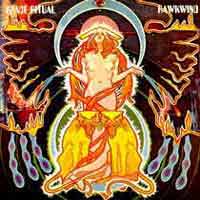 Mein erstes selbst gekauftes Album: Weihnachten 1973 bei Radio Bohlen in Dinslaken
für stolze 29 DM erstanden, nachdem ich das Lied "Born To Go"
im Radio gehört hatte (entweder bei Winfried Trenkler oder
Alan Bangs). Auch nach 3 Jahrzehnten finde ich dieses Live-Doppelalbum
immer noch klasse! Irres Klapp-Cover! Eine Nackt-Tänzerin! Synthesizer!
Audio-Generatoren! (wat is dat denn?) Der schlechteste und gleichzeitig
beste Saxofonist des Rock'n'Roll! Science-Fiction-Gedichte live rezitiert!
Lemmy am Bass! Wo aber war bloß die "Silver Machine" abgeblieben?
Mein erstes selbst gekauftes Album: Weihnachten 1973 bei Radio Bohlen in Dinslaken
für stolze 29 DM erstanden, nachdem ich das Lied "Born To Go"
im Radio gehört hatte (entweder bei Winfried Trenkler oder
Alan Bangs). Auch nach 3 Jahrzehnten finde ich dieses Live-Doppelalbum
immer noch klasse! Irres Klapp-Cover! Eine Nackt-Tänzerin! Synthesizer!
Audio-Generatoren! (wat is dat denn?) Der schlechteste und gleichzeitig
beste Saxofonist des Rock'n'Roll! Science-Fiction-Gedichte live rezitiert!
Lemmy am Bass! Wo aber war bloß die "Silver Machine" abgeblieben?

 Eine wundervoll poetische Platte mit schönen Orchesterarrangements,
die damals dem ehemaligen Bassisten, Pianisten und Bratschenspieler
der schrägen
Eine wundervoll poetische Platte mit schönen Orchesterarrangements,
die damals dem ehemaligen Bassisten, Pianisten und Bratschenspieler
der schrägen  Zu Terry Reid "Karriere" kann man nur sagen: was für
eine Verschwendung von Talent! Einer der besten britischen Rocksänger
hat es nach einem Hitalben in den späten 60ern in England seit
den 70ern bis heute in seiner Wahlheimat USA nur zu vier Platten gebracht,
die teilweise genial (wie diese) und teilweise nicht ganz so genial
waren, aber in jedem Fall kommerzielle Flops. In der 73er Truppe spielte
übrigens David Lindley seine unnachahmliche Slidegitarre!
Zu Terry Reid "Karriere" kann man nur sagen: was für
eine Verschwendung von Talent! Einer der besten britischen Rocksänger
hat es nach einem Hitalben in den späten 60ern in England seit
den 70ern bis heute in seiner Wahlheimat USA nur zu vier Platten gebracht,
die teilweise genial (wie diese) und teilweise nicht ganz so genial
waren, aber in jedem Fall kommerzielle Flops. In der 73er Truppe spielte
übrigens David Lindley seine unnachahmliche Slidegitarre! Das Debütalbum, noch ohne Sängerin Minne Graw, aber im Prinzip ist alles
schon da, was diese Band ausmacht: historische Texte, teilweise in Alt-
oder Mittelhochdeutsch, unterlegt mit (damals) zeitgemäßem
Folk und Folkrock. Wichtigste Beteiligte waren damals nach meiner Einschätzung
Sänger, Schlagzeuger und "Übersetzer" Olaf Casalich
und Multiinstrumentalist Frank Wulff, der sich kompetent auf
nahezu allem versucht, was Saiten hat oder in das man hineinblasen kann.
Das Debütalbum, noch ohne Sängerin Minne Graw, aber im Prinzip ist alles
schon da, was diese Band ausmacht: historische Texte, teilweise in Alt-
oder Mittelhochdeutsch, unterlegt mit (damals) zeitgemäßem
Folk und Folkrock. Wichtigste Beteiligte waren damals nach meiner Einschätzung
Sänger, Schlagzeuger und "Übersetzer" Olaf Casalich
und Multiinstrumentalist Frank Wulff, der sich kompetent auf
nahezu allem versucht, was Saiten hat oder in das man hineinblasen kann.